Palm PIXE CDMA-EVDO SmartPhone User Manual Palm Pixi User Guide
Palm Inc CDMA-EVDO SmartPhone Palm Pixi User Guide
Palm >
Contents
- 1. User Manual 1 of 2
- 2. User Manual 2 of 2
User Manual 2 of 2
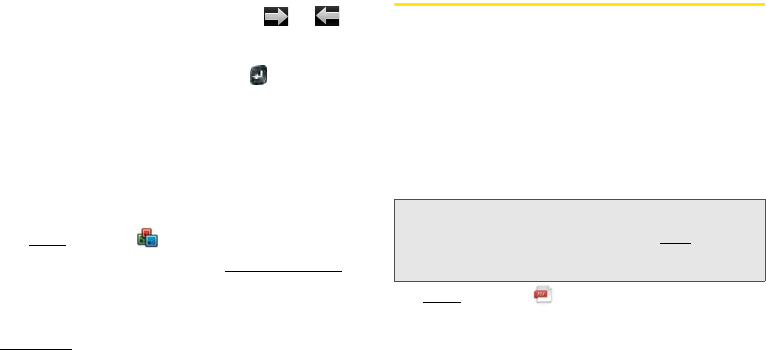
160 2G. Documents
Move Around in a Presentation
ⅷGo to the next or preceding slide: Tap or .
ⅷJump to a different slide: Tap the current slide number
in the lower-left corner of the screen. Enter the slide
number you want and press Enter .
Upgrade to Documents To Go® From
DataViz
With Documents To Go® from DataViz, you can create
and edit Word, Excel, and PowerPoint files right on your
phone, in addition to viewing them.
1. Open Doc View .
2. Open a document, open the application menu,
scroll down the menu if needed, and tap Document
Editing.
For more information on Documents To Go, go to
dataviz.com.
PDF View
With PDF View, you can view PDF (Adobe Acrobat) files
on your phone.
Open a File
You can view a PDF file that you copy from your
computer (see “Copy Files Between Your Phone and
Your Computer” on page 73) or receive as an email
attachment (see “Open Attachments” on page 196).
1. Open PDF View . (The list of your files appears
onscreen.)
Before You Begin: Before you put files on your phone, make
sure you have enough storage space on
your phone to fit the file. Open Device
Info and look at the Available field under
Phone.
Regulatory Submission (10.26.09). Palm, Inc. Confidential. Top Secret.
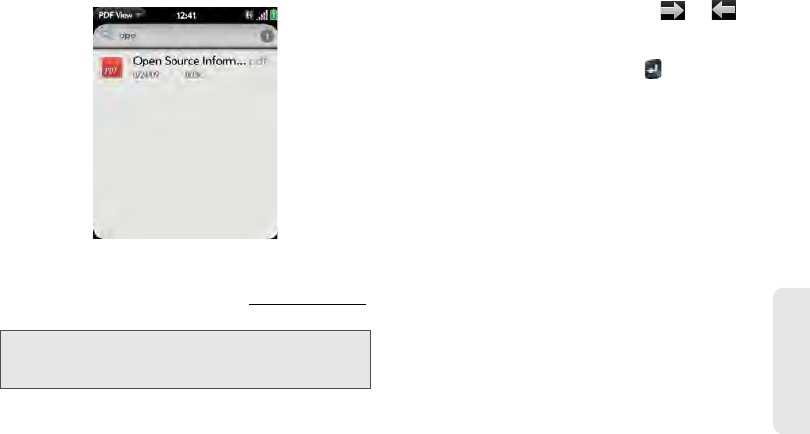
2G. Documents 161
Documents
2. To search for a file, begin typing the name. (Tap
the file when it appears.)
If the PDF file was created with a password, enter
the password to open the file.
3. To open a second file: Open the application menu
and tap Open. (Tap the file.)
Move Around in a File
ⅷGo to the next or preceding page: Tap or .
ⅷJump to a different page: Tap the current page
number at the bottom of the screen. Enter the page
number you want and press Enter .
Change the Display Size
For information on zooming in and out, see “Zoom
Gestures” on page 41.
ⅷPinch out to enlarge items onscreen.
ⅷPinch in to decrease the size of items onscreen.
ⅷDouble-tap the screen to zoom in or out a specified
amount.
Tip: To move between open PDFs, tap the center of the
gesture area to go to Card view. Tap the PDF card you
want to read.
Regulatory Submission (10.26.09). Palm, Inc. Confidential. Top Secret.
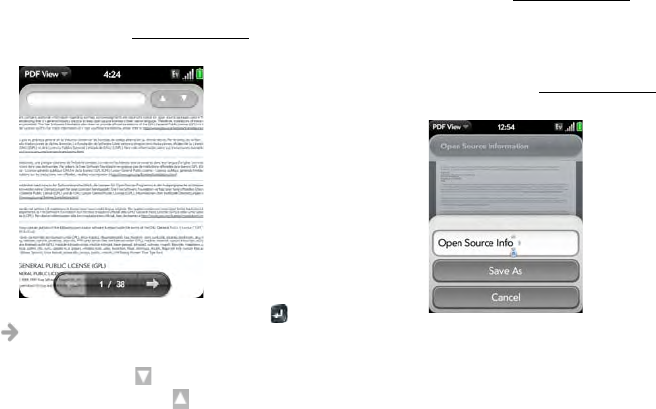
162 2G. Documents
Find Text in a File
1. With a file open, open the application menu and
tap Find.
2. Type the text you want to find, and press Enter
or tap . (The first instance of the text appears
highlighted.)
3. Find the next instance: Tap .
Find the preceding instance: Tap .
4. To exit search, open the application menu and tap
Find.
Save a File With a New Name
1. With the file open, open the application menu and
tap Save As.
2. Enter the new file name and tap Save As.
Regulatory Submission (10.26.09). Palm, Inc. Confidential. Top Secret.
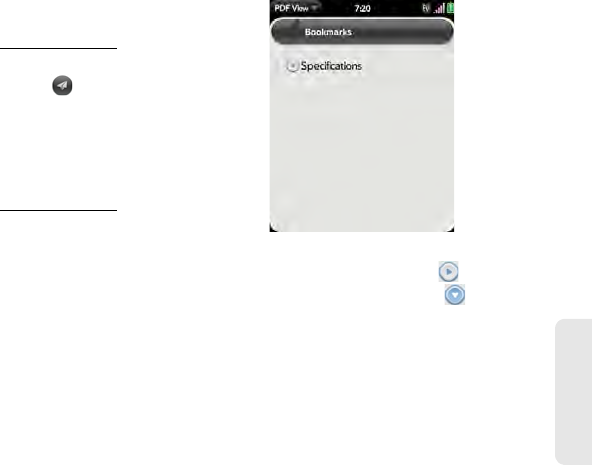
2G. Documents 163
Documents
Share a File
1. With the file open, open the application menu and
tap Share.
2. Create the email message and tap .
View Bookmarks
If a PDF file was created with bookmarks, you can see
the bookmarks on your phone.
1. With the file open, open the application menu and
tap Bookmarks. (A checkmark next to a bookmark
name identifies the section of the file you are
currently viewing.) 2. Do any of the following:
ⅢTo expand a bookmark entry: Tap .
ⅢTo collapse a bookmark entry: Tap .
ⅢTo search for a specific bookmark: Type the
bookmark name.
3. Tap a bookmark to jump to that section of the file.
Regulatory Submission (10.26.09). Palm, Inc. Confidential. Top Secret.

164 2H. Preferences
2H. Preferences
ࡗBackup (page 164)
ࡗDate & Time (page 170)
ࡗDevice Info (page 171)
ࡗRegional Settings (page 174)
ࡗScreen & Lock (page 175)
ࡗSounds & Ringtones (page 178)
Backup
Back Up Your Information
A Palm profile connects your phone to Palm to get
automatic updates, back up your data, and more. You
create a Palm profile when you set up your phone.
Your phone backs up the contacts, calendar events,
tasks, and memos that are in your Palm profile account,
as well as system settings and applications you
downloaded to your phone. An automatic backup to
your Palm profile of all this information happens every
day. So if you ever need to erase the info from your
phone, you can restore all your backed-up info. You
can turn off automatic backup, and you can also
perform a manual backup.
Backup does not affect information stored in online
accounts like Google. Information stored in online
accounts is synchronized by the online provider at
regular intervals. Information stored in Outlook
Exchange is synchronized by your company's
Exchange server.
Regulatory Submission (10.26.09). Palm, Inc. Confidential. Top Secret.
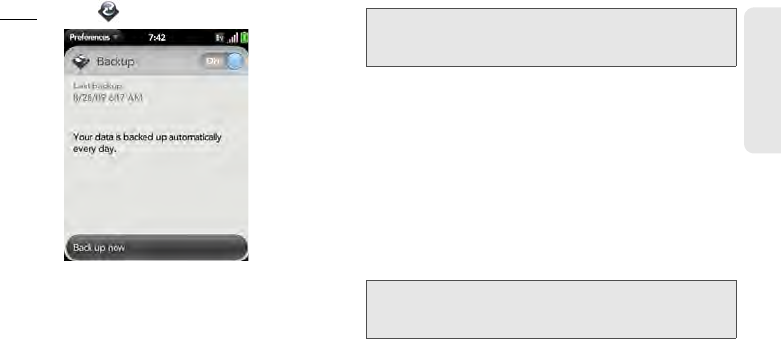
2H. Preferences 165
Preferences
1. Open Backup .
2. Do any of the following:
ⅢBack up your information manually: Tap Back up
now.
ⅢTurn off automatic backup and delete backed-up
information: Tap On to switch backup from On to
Off. Tap Turn Off And Erase Data. This deletes all
your information on the server. It does not affect
the information on your phone.
ⅢTurn on automatic backup if you had previously
turned it off: Tap Off to switch Backup from Off to
On.
What Information is Backed Up?
All data backed up to your Palm profile is encrypted,
and only you, the profile owner, can access your data.
Backed up data cannot be accessed by Palm. Data in
your Palm profile can only be added to or edited on
your phone.
Tip: Go to Device Info to delete the information on your
phone (see “Erase Data and Reset Your Phone” on
page 171).
Important: In the event that your phone is lost or stolen, you
can go to your Palm profile on palm.com and from
there erase the data on your phone.
Regulatory Submission (10.26.09). Palm, Inc. Confidential. Top Secret.

166 2H. Preferences
The following table lists info that is and is not backed
up to your Palm profile:
Application Backed up Not backed up
Backup Backup setting is on by default.
Bluetooth Nothing is backed up.
Calendar Events in your Palm profile.
Username and password for accounts like
Google that sync calendar events online.
Preferences (see “Customize Calendar” on
page 143).
Events in online accounts.
Password for Facebook accounts.
Contacts Contacts in your Palm profile account.
Username and password for accounts like
Google that sync contacts online.
Preferences (see “Customize Contacts” on
page 133).
Contacts in online accounts.
Linking relationships between contacts.
Original contact photos added from a local
image on the phone.
Password for Facebook accounts.
Speed dials.
Date & Time Nothing is backed up.
Regulatory Submission (10.26.09). Palm, Inc. Confidential. Top Secret.

2H. Preferences 167
Preferences
Doc View Nothing is backed up. Keep a copy of these files
on your computer (see “Copy Files Between
Your Phone and Your Computer” on page 73).
Email Username and password of your email
accounts. When you sign in to your Palm profile
after your phone is erased, email accounts are
restored automatically and synchronized.
Emails, their contents and attachments, their sort
order, and account preferences.
Launcher Nothing is backed up.
Location
Services
Nothing is backed up.
Memos All memos.
Messaging Username and password of accounts. Message contents, attachments, and history.
PDF View Nothing is backed up. Keep a copy of these files
on your computer (see “Copy Files Between
Your Phone and Your Computer” on page 73).
Phone Nothing is backed up.
Photos Username and password of online accounts like
Facebook and Photobucket.
No photos are backed up. Keep a copy of your
photos on your computer (see “Copy Files
Between Your Phone and Your Computer” on
page 73).
Application Backed up Not backed up
Regulatory Submission (10.26.09). Palm, Inc. Confidential. Top Secret.

168 2H. Preferences
Regional
Settings
Nothing is backed up.
Screen & Lock Nothing is backed up.
Sounds &
Ringtones Nothing is backed up.
Tasks Tasks in your Palm profile account.
Username and password for accounts like
Microsoft Exchange ActiveSync that synchronize
tasks online.
Tasks in online accounts.
Third-party apps Apps you downloaded are downloaded again
from App Catalog.
Wallpaper Nothing is backed up.
Web Nothing is backed up.
Application Backed up Not backed up
Regulatory Submission (10.26.09). Palm, Inc. Confidential. Top Secret.

2H. Preferences 169
Preferences
Update Your Palm Profile Settings
In the event that your phone is lost or stolen, you can
go to your Palm profile on palm.com and from there
erase the data on your phone.
1. Open Backup .
2. Tap application menu and tap Palm Profile.
3. Enter your Palm profile password and tap Done.
4. Edit any of the following:
First Name/Last Name: Change the first name
and/or last name associated with your Palm profile.
Email: Change the email address associated with
your Palm profile. A verification email is sent to the
new address. Click the link in the email to verify the
new address. After you verify, the email address is
changed.
Important: To ensure that the data on your phone is consistent
with that stored on your Palm profile, it is
recommended that you perform a manual backup
of your data after changing any of your Palm profile
settings (see “Back Up Your Information” on
page 164).
Regulatory Submission (10.26.09). Palm, Inc. Confidential. Top Secret.
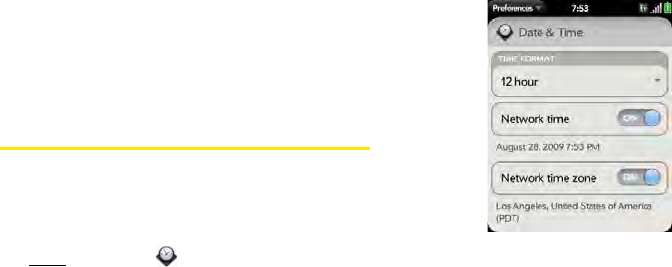
170 2H. Preferences
Security Question/Answer: Tap the current question
and tap a new one. Then tap Answer and enter an
answer.
Change Password: Tap Change Password. Enter
your new password and confirm it. Tap Done.
Date & Time
You can set your phone to adjust the date and time
automatically to the local date and time wherever you
are, or you can turn this feature off and enter this
information manually.
1. Open Date & Time . 2. Set any of the following:
Time Format: Set whether to use a 12-hour or a
24-hour format.
Network time: Tap On or Off. If you turn this option
off, select the date and time. If you switch from
manual time to network time, there might be a
delay before the network time updates on your
phone.
Regulatory Submission (10.26.09). Palm, Inc. Confidential. Top Secret.
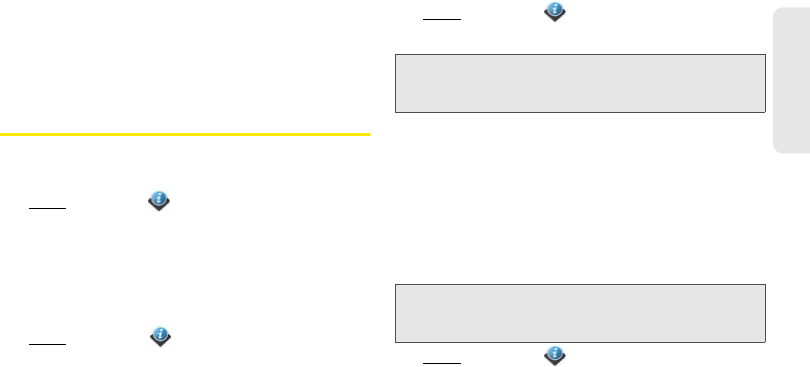
2H. Preferences 171
Preferences
Network time zone: Tap On or Off. If you turn this
option off, tap the city that appears onscreen. Type
the name of a country or city in the time zone you
want, and then tap the location.
Device Info
View System Information
1. Open Device Info . (Basic system information is
displayed.)
2. To view more detailed system information, tap
More Info, and tap Software or Hardware.
Rename Your phone
1. Open Device Info .
2. Tap the Name field and enter the new name.
Restart Your phone
If an application freezes, first try restarting your phone.
No files or settings are changed when you restart.
1. Open Device Info .
2. Tap Phone Reset Options and tap Restart.
Erase Data and Reset Your Phone
If restarting your phone does not solve the problem of
application freezes, you may need to reset the phone. A
reset deletes some or all information from your phone
(depending on the type of reset you select). After a
reset, you must follow the prompts to sign in to your
Palm profile again before you can use your phone.
1. Open Device Info .
2. Tap Reset Options.
Note: If the screen does not respond to taps, press and hold
power and slide the ringer switch three times to restart
your phone.
Important: You should perform a manual backup of your data
before resetting your phone (see “Back Up Your
Information” on page 164).
Regulatory Submission (10.26.09). Palm, Inc. Confidential. Top Secret.
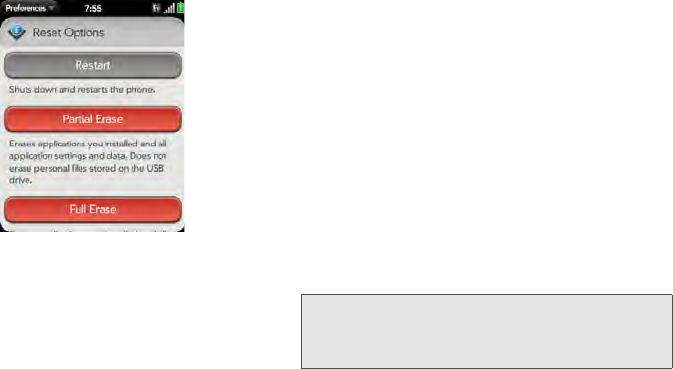
172 2H. Preferences
3. Do one of the following:
ⅢErase all data from the phone except items stored
in USB Drive storage, such as pictures, videos, and
music: Tap Partial Erase twice.
ⅢErase all data from the phone:Tap Full Erase twice.
All data from all accounts and in USB Drive
storage is erased from your phone, including
information about your Palm profile. But all your
data on the Web—in your online accounts and in
your Palm profile—is untouched. Perform a full
erase when you give your phone to somebody
else and you don’t want that person to be able to
access your data. Also, before giving your phone
to another person, you must manually delete all
the apps you installed, because they reappear on
your phone after a full erase (see “Delete an
Application” on page 52).
After a full erase, you can sign in to your Palm
profile either on a new webOS phone or the same
phone you just erased. Signing in restores your
Palm profile data and information from online
accounts, but not your stored files such as pictures,
videos, and music (you must copy those again to
the phone; see “Copy Files Between Your Phone
and Your Computer” on page 73). You can also
sign in to your Palm profile on a new phone and
restore your data to the new phone.
Run Quick Tests
If you are troubleshooting your device with a support
agent, you can run Quick Tests to get diagnostic
Important: If you have a Palm profile from a phone that you no
longer use, you can sign in to your existing profile.
All info associated with your profile is downloaded
to your new phone.
Regulatory Submission (10.26.09). Palm, Inc. Confidential. Top Secret.

2H. Preferences 173
Preferences
information. If you need more information after running
Quick Tests, you can run one or more Interactive Tests
(see “Run Interactive Tests” on page 173).
1. Open Device Info .
2. Tap More Info.
3. Open the application menu and tap Quick Tests.
4. Work with the support agent to view and report the
test results.
Run Interactive Tests
If you are troubleshooting your device with a support
agent and need more information after running Quick
Tests (see “Run Quick Tests” on page 172), you can
run one or more Interactive Tests.
1. Open Device Info .
2. Tap More Info.
3. Open the application menu and tap Interactive
Tests.
4. Work with the support agent to run and view
results from one or more tests.
Use Certificate Manager
Certificates are digital documents that are used to
authenticate and exchange information on networks.
Certificates can be issued for a user, a device, or a
service.
Add a Certificate From USB Drive Storage
You can install a certificate that is located in the USB
Drive storage on your phone. To copy a certificate into
USB Drive storage, see “Copy Files Between Your
Phone and Your Computer” on page 73.
1. Open Device Info .
2. Tap More Info.
3. Open the application menu and tap Certificate
Manager.
Regulatory Submission (10.26.09). Palm, Inc. Confidential. Top Secret.
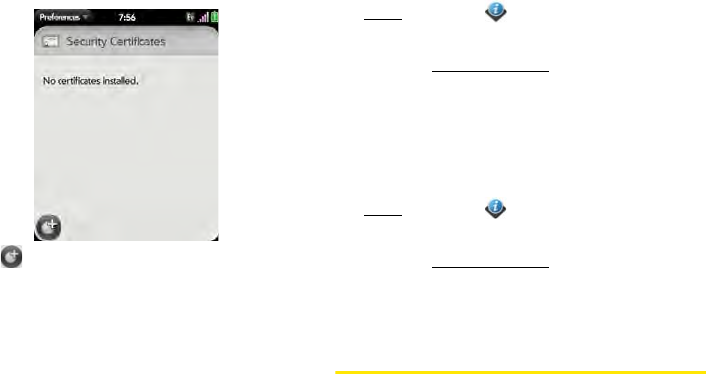
174 2H. Preferences
4. Tap and tap the certificate name.
Add a Certificate From an Email
Attachment
Open the email attachment (see “Open Attachments”
on page 196), and then tap Trust Certificate.
View Certificate Details
Only user-installed certificates can be viewed.
1. Open Device Info .
2. Tap More Info.
3. Open the application menu and tap Certificate
Manager.
4. Tap the certificate name.
Delete a Certificate
Only user-installed certificates can be deleted.
1. Open Device Info .
2. Tap More Info.
3. Open the application menu and tap Certificate
Manager.
4. Tap the certificate and tap Delete Certificate.
Regional Settings
Language
You can set your phone display to any language
available for the device.
Regulatory Submission (10.26.09). Palm, Inc. Confidential. Top Secret.

2H. Preferences 175
Preferences
1. Open Regional Settings .
2. Tap the language.
3. If a region list is displayed, tap the region.
4. Confirm you want to use the new language, or
revert to the original language.
Your phone resets after you select a new language.
You do not lose any data or applications from the reset.
Formats
You can set your phone to format numbers, currency,
date, and time to reflect your country’s style.
1. Open Regional Settings .
2. Tap the country name.
3. Do one of the following:
ⅢScroll down to find a country, and then tap it.
ⅢType the name of the country, and when it
appears, tap it.
4. Confirm you want to change the format, or tap
Cancel.
Your phone restarts after you select a new country
format. You do not lose any data.
Screen & Lock
Change Screen Brightness
1. Open Screen & Lock .
2. Under Screen, tap, hold, and drag the Brightness
slider to the preferred level.
Set the Interval for Turning the Screen Off
Automatically
By default, your screen turns off after one minute of
inactivity to save battery power. You can change this
interval.
1. Open Screen & Lock .
2. In Turn off after, tap the number of seconds or
minutes.
Regulatory Submission (10.26.09). Palm, Inc. Confidential. Top Secret.

176 2H. Preferences
Change Your Wallpaper
Your wallpaper is the screen background in Card view.
You can customize the wallpaper to show a favorite
picture.
1. Open Screen & Lock .
2. Tap Change Wallpaper.
3. Do one of the following:
ⅢUse an existing picture as the background: Tap the
album containing the picture, and tap the picture.
ⅢUse a new picture as the background: Tap New
Photo and take the picture.
4. (Optional) Do either or both of the following:
ⅢTo zoom out or in on a part of the picture, pinch
in or out on the picture.
ⅢTo capture the portion of the picture you want for
your wallpaper, tap and hold the picture, and then
drag the portion you want to the center of the
onscreen box.
5. Tap Set Wallpaper.
Turn Advanced Gestures On/Off
Turning on advanced gestures gives you two new
gestures, previous and next, and also changes the way
you make the back gesture, and the forward gesture (in
Web only).
ⅷNew gestures: The previous and next gestures let you
move among your open applications without first
going to Card view. The previous gesture is a full
swipe from left to right across the entire length of the
gesture area. The next gesture is a full swipe from
right to left across the entire length of the gesture
area. Use these gestures when you have more than
one app open and an app is displayed full-screen.
By making the previous and next gestures you go
from full-screen view to full-screen view of each app.
The order of applications is determined by the order
that you opened them or arranged them in Card
view.
ⅷChange to back gesture: The back gesture still goes
from right to left in the gesture area, but you must
make a shorter swipe, from the center outward.
Regulatory Submission (10.26.09). Palm, Inc. Confidential. Top Secret.
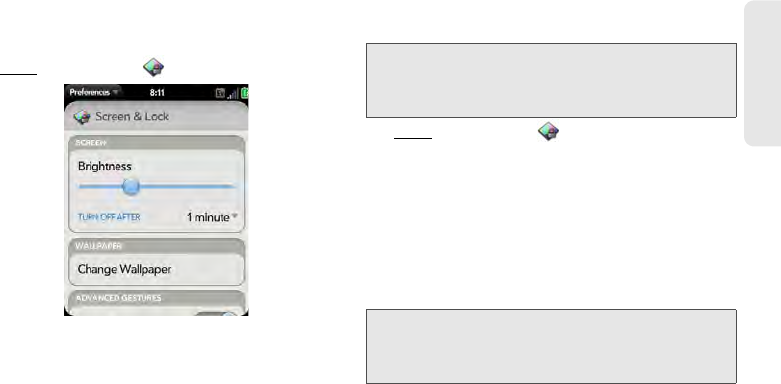
2H. Preferences 177
Preferences
ⅷChange to front gesture: The front gesture (available in
Web only) still goes from left to right in the gesture
area, but it’s a shorter swipe, from the center outward.
1. Open Screen & Lock .
2. In Switch Applications, tap On or Off.
Set Options for Unlocking the Screen
The screen locks five seconds after it turns off
automatically, or immediately if you turn the screen off
manually. Use Secure Unlock if you want to require a
PIN or a password to unlock the screen.
1. Open Screen & Lock .
2. To turn Secure Unlock on, in Secure Unlock, tap
Simple PIN or Password and do one of the
following:
Simple PIN: Enter a four-digit PIN. This is a PIN that
you make up. Enter the PIN again to confirm.
Password: Enter a password containing any
combination of letters and numbers. Enter the
password again to confirm.
3. (Optional) Under Notifications, tap On or Off to set
whether notifications are displayed when the
screen is locked.
Tip: If your company issued your phone to you, check with
your system administrator whether the company has its
own settings for locking and unlocking the screen of your
phone.
Important: Be sure to write down your PIN or password and
keep it somewhere safe. If you forget your PIN or
password, you need to remotely reset your phone
and may lose data.
Regulatory Submission (10.26.09). Palm, Inc. Confidential. Top Secret.
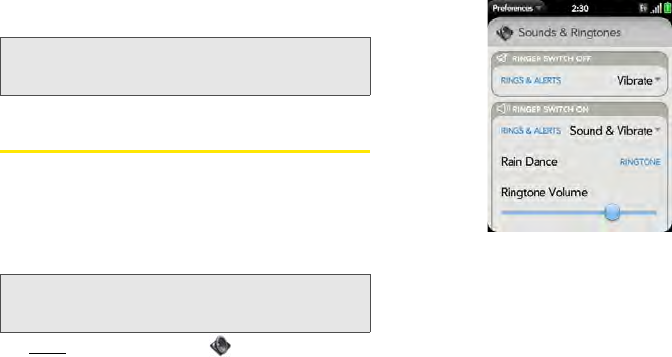
178 2H. Preferences
4. To turn Secure Unlock off, in Secure Unlock, tap Off.
(Enter the PIN or password.)
Sounds & Ringtones
Manage System Sounds and Ringtones
You can turn system sounds, such as transition sounds
and notification alerts, on or off. You can also set the
volume for system sounds.
1. Open Sounds & Ringtones .
2. In Ringer Switch Off, tap Vibrate or Mute to set
whether your phone vibrates when you slide the
ringer switch off.
3. Under Ringer Switch On, set any of the following:
Rings & Alerts: Select Sound & Vibrate or Sound. To
change the ringtone for incoming calls see “Select
the Ringtone for Incoming Calls” on page 179. Tap,
hold, and drag the Ringtone Volume slider to set
the ringtone volume.
Tip: To change your PIN or password, in Secure Unlock, tap
Change PIN or Change Password. Enter the old
PIN/password and the new PIN/password.
Note: Sliding the ringer switch off turns off system sounds.
The ringer switch does not affect the Clock alarm or
media sounds, such as Music and Video.
Regulatory Submission (10.26.09). Palm, Inc. Confidential. Top Secret.
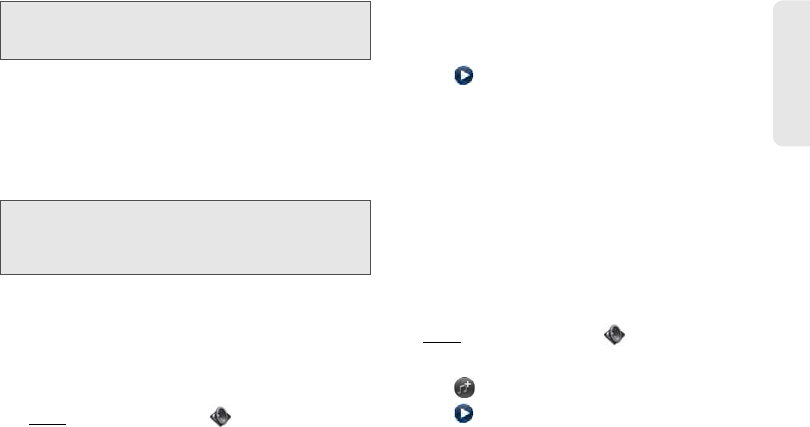
2H. Preferences 179
Preferences
System Sounds: Set whether to turn on systemwide
sounds for general actions such as transitions,
notifications, and Calendar event alerts. Tap, hold,
and drag the Volume slider to set the system
sounds volume.
Vibrate: Set whether your phone vibrates as well as
plays a ringtone on an incoming call.
Select the Ringtone for Incoming Calls
The ringtone you select here applies globally to all
incoming calls. You can also set a unique ringtone for
a contact (see “Add a Ringtone to a Contact” on
page 128).
1. Open Sounds & Ringtones .
2. Tap the displayed ringtone to open the full list of
tones.
3. Tap the name of the ringtone to select it.
4. Tap to listen to the ringtone.
5. Use the back gesture to get to the Ringtone Volume
slider, and then tap, hold, and drag the slider to
change volume.
Select a Song as a Ringtone
You can add the first few seconds of a song as the
ringtone for your phone.
The ringtone you select here applies globally to all
incoming calls. You can also set a unique ringtone for
a contact (see “Add a Ringtone to a Contact” on
page 128).
1. Open Sounds & Ringtones .
2. Tap the displayed ringtone.
3. Tap .
4. Tap to the right of a song title to preview it.
5. Tap the song title to add it as your ringtone.
Tip: Adjusting the Ringtone Volume slider is the same as
using the volume up and volume down buttons on the
side of the phone.
Tip: By default, when the ringer switch is off, you can still hear
the Clock alarm. If you want to change this setting, go to
Clock > Preferences. Under Ringer Switch Off, change
Play alarm anyway to Off or On.
Regulatory Submission (10.26.09). Palm, Inc. Confidential. Top Secret.
180 2H. Preferences
6. Use the back gesture to get to the Ringtone Volume
slider, and then tap, hold, and drag the slider to
change volume.
Regulatory Submission (10.26.09). Palm, Inc. Confidential. Top Secret.
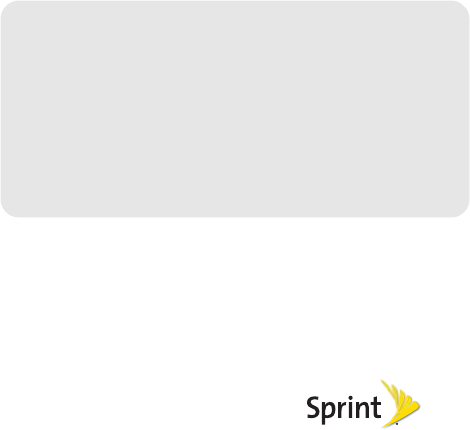
Web and Data Services and
Other Wireless Connections
Section 3
Regulatory Submission (10.26.09). Palm, Inc. Confidential. Top Secret.

182 3A. Using Web and Data Services
3A. Using Web and Data
Services
ࡗGet Started With Data Services (page 182)
ࡗAccess Data Services (page 182)
ࡗUse Sprint TV®(page 183)
Get Started With Data Services
With your Sprint service, you are ready to start enjoying
the advantages of data services. To sign up for data
services and to access complete instructions, visit
sprint com For information on charges associated with
the features of Sprint’s data services, refer to your Sprint
service plan.
Enable Data Services
The first time your activated Palm® Pixi™ phone is
turned on, a one-time setup process occurs
automatically. You do not need to do anything. If the
setup process fails, call Sprint Customer Service at
1-888-211-4727 from another phone for assistance.
Access Data Services
Data Services User Name
When you buy your phone and sign up for service,
you’re automatically assigned a user name, which is
typically based on your name and a number followed
by “@sprintpcs.com.” (For example, the third John
Smith to sign up for Sprint services might have
jsmith003@sprintpcs.com as his user name.)
When you use data services, your user name is
submitted to identify you to the Sprint National Network.
Your user name is automatically programmed into your
phone. You don’t have to enter it. When your phone is
enabled with data services, your user name
automatically appears on the Device Info screen.
Regulatory Submission (10.26.09). Palm, Inc. Confidential. Top Secret.
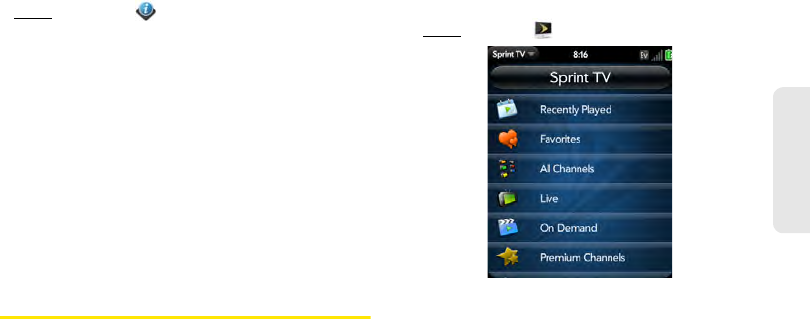
3A. Using Web and Data Services 183
Web & Data Services
To find your user name:
ⅷOpen Device Info and tap More Info. (Your data
services user name appears under NAI.).
Data Services Symbols on Your Screen
When you are connected to data services, a data
connection icon appears at the top of the screen. See
“Icons in the Title Bar” on page 29 for a description of
the various data connection icons.
Data Services Billing Information
See your service plan or contact Sprint for details on
data services billing.
Use Sprint TV®
With Sprint TV®, you can watch live TV on the go, right
on your phone. Accessing your Sprint TV channels is
as easy as using the remote control in your living room.
Browse through the available free channels or
subscribe to one of the premium offerings. Wherever
you go on the Sprint National Network, you can get
more out of your Sprint TV service.
1. Open Sprint TV .
2. Tap Recently Played, Favorites, All Channels, Live,
On Demand, Premium Channels, Sprint Radio, or
Sprint Movies to display a list of channels and
programming.
3. Tap an item to play it.
Regulatory Submission (10.26.09). Palm, Inc. Confidential. Top Secret.
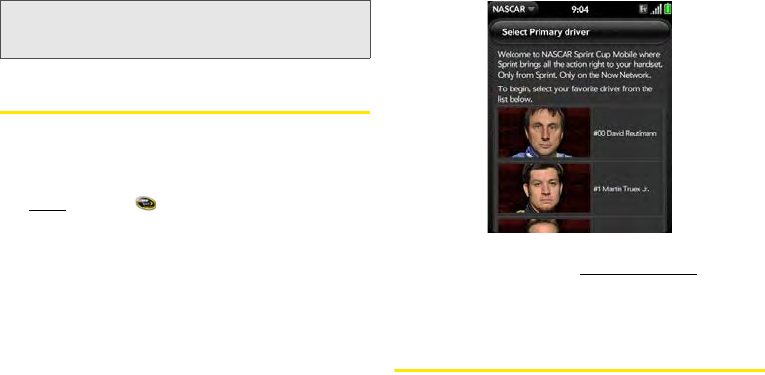
184 3A. Using Web and Data Services
NASCAR Sprint Cup MobileSM
With NASCAR Sprint Cup MobileSM, you can keep pace
with the latest race results, driver stats, and live race
audio.
1. Open NASCAR .
2. The first time you open NASCAR Sprint Cup Mobile,
do the following:
ⅢTap Continue and follow the onscreen
instructions.
ⅢTap a driver thumbnail and tap Continue.
3. Tap options such as Home, News, SPEED, Video,
and Drivers. (Open the application menu and tap
other options such as Stats and Schedules, Sprint
FanView, Alerts and Personalization, or Fantasy.)
NFL Mobile Live
With NFL Mobile Live, you can keep up with the latest
news and stats from the National Football League.
Note: The first time you access a channel that requires a
subscription, you are prompted to purchase access.
Tap Subscribe to purchase access.
Regulatory Submission (10.26.09). Palm, Inc. Confidential. Top Secret.
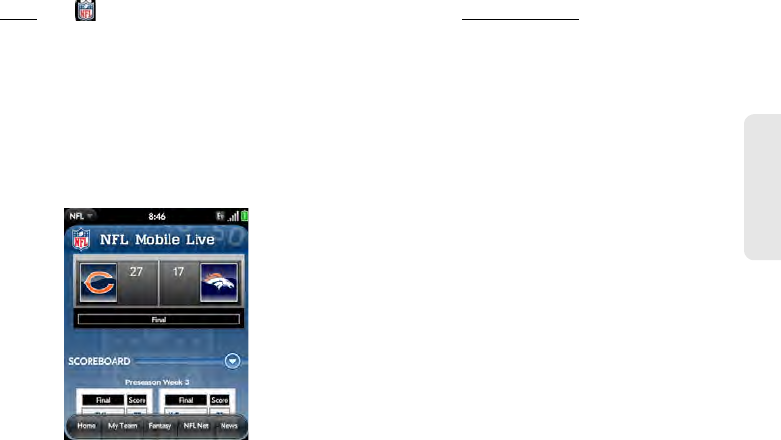
3A. Using Web and Data Services 185
Web & Data Services
1. Open NFL .
2. The first time you use NFL Mobile Live, you are
asked to select your favorite team. Do either of the
following:
ⅢTap A for an AFC team.
ⅢTap N for an NFC team.
3. Tap a team logo.
4. Tap options such as Home, My Team, Fantasy, NFL
Net, and News.
5. Open the application menu and tap other options
such as Alerts & Personalizations, Scores &
Schedules, Audio & Video, Standings & Statistics, or
Help.
Regulatory Submission (10.26.09). Palm, Inc. Confidential. Top Secret.

186 3B. Email and Other Messages
3B. Email and Other
Messages
ࡗEmail (page 186)
ࡗMessaging (page 202)
Email
How Do I Send and Receive Email on My
Phone?
Use the Email application on your phone to access the
many email accounts you have: company (like
Exchange), ISP (like EarthLink and Comcast), and
web-based (like Gmail).
The Palm® Synergy™ feature makes it easy to
synchronize all data from an online account. By setting
up synchronization in one app, synchronization of the
other apps is automatically set up for you. For example,
if you set up your Google contacts account in Contacts
before you set up Gmail, when you first open Email,
you find that your Gmail messages are already
downloaded. And when you first open Calendar, you
find that your Google calendar events are already in
your phone’s Calendar app.
For email accounts that do not make use of the
Synergy feature, you need to enter the settings for that
account—such as username and password—directly in
the Email application (see “Set Up Email” on
page 187).
You can also use your phone’s Web browser to view
your web-based email—just go to the email provider’s
website.
Merged Inboxes in Email
You can set up multiple email accounts on your phone.
When you open Email, you see all your accounts in a
single view: Account List view. From there, you can
open the inbox of an individual account—or, thanks to
the Palm® Synergy™ feature, you can see all messages
from all your inboxes displayed in a single merged view
called All inboxes.
Regulatory Submission (10.26.09). Palm, Inc. Confidential. Top Secret.
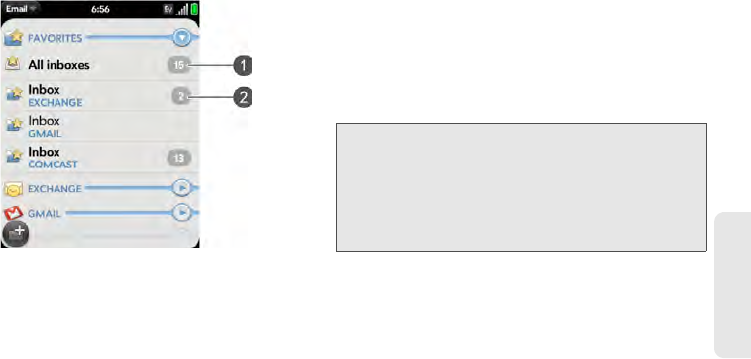
3B. Email and Other Messages 187
Email & Messaging
1Number to the right of All inboxes indicates total
number of unread email messages in all your
email accounts.
2Number to the right of individual folder name
indicates number of unread messages in that
folder.
If you reply to a message when you’re working in All
inboxes, the message is sent from the same account in
which it was received.
If you create a new message when you’re working in
All inboxes, the message goes out using the account
you set as the default account (see “Set Email
Preferences” on page 200).
Set Up Email
Set Up Email: Common Providers
Follow this procedure if you have a common email
provider, for example, AOL, EarthLink, or Yahoo! If you
are setting up the Email application to work with your
corporate email account that uses Microsoft Exchange
ActiveSync, see “Set Up Email: Microsoft Exchange
ActiveSync (EAS)” on page 188. If you have a less
common email provider, see “Set Up Email: Other
Providers” on page 190.
Before You Begin:
• Make sure your phone is on and you’re inside a coverage
area before you send or receive messages.
• If you want delivery of Microsoft Office Outlook® email from
an Exchange account using Microsoft Direct Push, make
sure that your IT organization uses Exchange Server 2007,
or Exchange Server 2003 with Service Pack 2.
Regulatory Submission (10.26.09). Palm, Inc. Confidential. Top Secret.
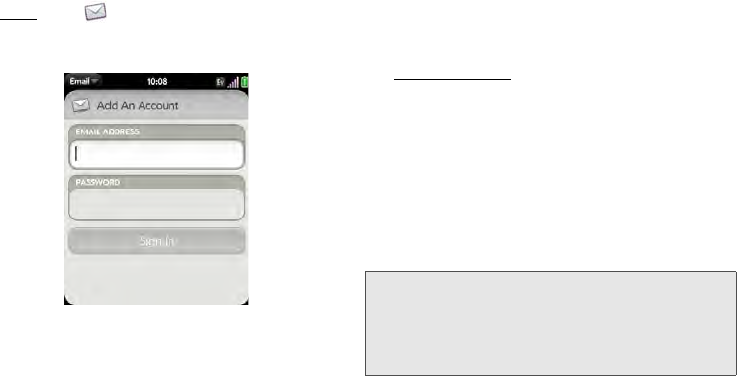
188 3B. Email and Other Messages
If the email account you set up takes advantage of the
Synergy feature, then setting up email also
synchronizes the provider's calendar and contacts.
1. Open Email .
2. The first time you open Email, do one of the
following:
ⅢIf this is the first email account you are setting up:
The email address you used for your Palm profile
is entered by default. Use that address, or enter
an address for one of your other email accounts.
Enter your password for the account and tap Sign
In.
ⅢIf you already set up an account and want to set up
another one: Tap Add An Account and enter the
email address and password. Tap Sign In.
3. Any other time you open Email, open the
application menu, tap Preferences & Accounts, and
tap Add An Account. (Enter the email address and
password and tap Sign In.)
4. Tap Add An Account to add another account.
Set Up Email: Microsoft Exchange
ActiveSync (EAS)
Follow this procedure to get email from an Exchange
account.
Before You Begin: Get this info from your email provider or
system administrator:
• Mail server name or IP address for
receiving mail
•Server domain name
• Your username and password
Regulatory Submission (10.26.09). Palm, Inc. Confidential. Top Secret.
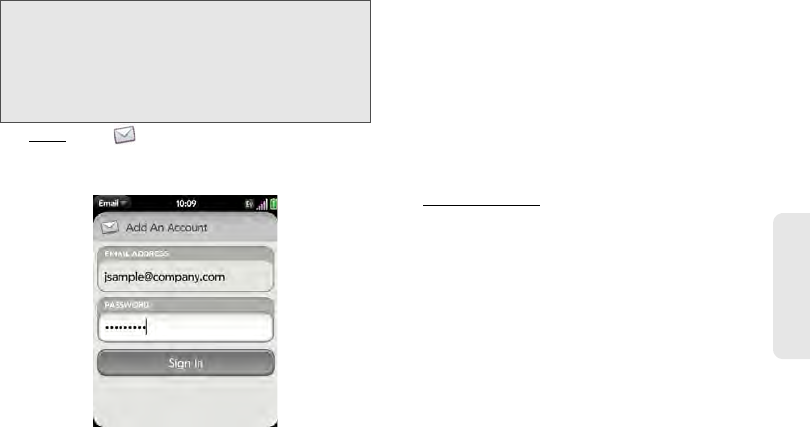
3B. Email and Other Messages 189
Email & Messaging
1. Open Email .
2. The first time you open Email, do one of the
following:
ⅢIf this is the first email account you are setting up:
The email address you used for your Palm profile
is entered by default. Use that address, or enter
an address for one of your other email accounts.
Enter your password for the account and tap Sign
In.
ⅢIf you already set up an account and want to set up
another one: Tap Add An Account. Enter your
username and password, and tap Sign In.
3. Any other time you open Email, open the
application menu, tap Preferences & Accounts, and
tap Add An Account. (Enter your username and
password, and tap Sign In.)
4. Tap OK, and tap Manual Setup.
5. In Mail Type, tap POP to display the list of options,
and then tap Exchange (EAS).
6. Verify the information in the other fields and
change the info as needed based on the
information you obtained. (You can enter either the
server name or IP address in the Incoming Mail
Server field.)
7. Tap Sign In.
Note: If your corporate EAS system utilizes policies such as
remote wipe and password enforcement (including
minimum password length, allowed number of failed
password attempts, and other parameters), those
policies are supported in your Exchange account on
your phone. Check with your system administrator for
details.
Regulatory Submission (10.26.09). Palm, Inc. Confidential. Top Secret.
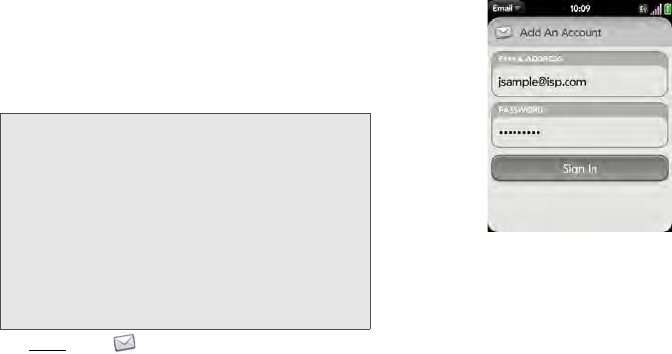
190 3B. Email and Other Messages
8. Tap Add An Account to add another account.
Set Up Email: Other Providers
Follow this procedure to get email from an account that
you have with an Internet service provider (ISP), a work
account other than a Microsoft Exchange ActiveSync
account, or any other IMAP or POP email account.
1. Open Email .
2. The first time you open Email, do one of the
following:
ⅢIf this is the first email account you are setting up:
The email address you used for your Palm profile
is entered by default. Use that address, or enter
an address for one of your other email accounts.
Enter your password for the account and tap Sign
In.
ⅢIf you already set up an account and want to set up
another one: Tap Add An Account. Enter your
username and password, and tap Sign In.
Before You Begin: Get this info from your email provider or
system administrator:
• Account type (POP or IMAP)
• Incoming and outgoing mail server
names
• Incoming mail server username and
password
• Incoming and outgoing server port
numbers
• Any SSL requirements for incoming
and/or outgoing mail
• Any authentication (ESMTP)
requirements for outgoing mail
• Root folder (IMAP accounts only)
Regulatory Submission (10.26.09). Palm, Inc. Confidential. Top Secret.
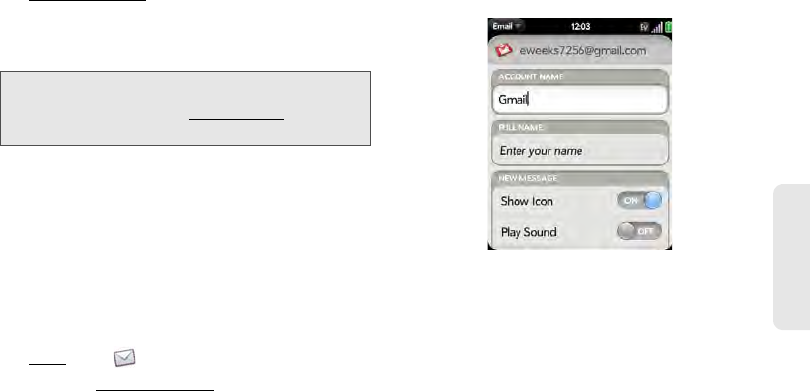
3B. Email and Other Messages 191
Email & Messaging
3. Any other time you open Email, open the
application menu, tap Preferences & Accounts, and
tap Add An Account. (Enter your username and
password, and tap Sign In.)
4. Tap OK, and tap Manual Setup.
5. Verify the information in the other fields and
change the info as needed based on the
information you obtained from your email provider
or system administrator.
6. Tap Sign In.
Enter Advanced Account Settings
These settings apply only to the account you select in
step 3.
1. Open Email .
2. Open the application menu and tap Preferences &
Accounts.
3. Tap the account name.
4. Set any of the following:
Account Name: Enter the name that appears in the
account list.
Full Name: Enter the name you want to appear in
the From field for messages you send.
Show Icon: Set whether a notification icon appears
onscreen when a new message arrives.
Play Sound: Set whether a sound plays when a
new message arrives.
Tip: You can jump to the account settings entry screen
directly from the screen where you enter your username
and password. Open the application menu and tap
Manual Setup.
Regulatory Submission (10.26.09). Palm, Inc. Confidential. Top Secret.

192 3B. Email and Other Messages
Vibrate: Set whether your phone vibrates when a
new message arrives.
Signature: Tap to create a signature that’s added to
outgoing messages (see “Add a Signature to
Outgoing Messages” on page 199 for more
information).
Reply-to Address: Enter the address you want
recipients to see and reply to on your outgoing
messages, if this is different from your actual email
address.
Sync deleted emails (POP accounts only): Set
whether messages should be deleted on the
server when you delete them on your phone.
Show Email: Set how many days’ worth of
messages to retrieve from the server.
Get Email: Set how frequently to synchronize email
for this account.
Default Folders (IMAP accounts only): Specify the
folder where messages you send, save as drafts,
or delete are stored.
Remove Account: See “Delete an Email Account”
on page 192.
Change Login Settings: See “Change Account
Login Settings” on page 192.
Change Account Login Settings
When you change your password for an online email
account, remember to make the change in the account
settings on your phone also.
1. Open Email .
2. Open the application menu and tap Preferences &
Accounts.
3. Tap the account name.
4. Tap Change Login Settings and tap the relevant
fields to change the account information.
Delete an Email Account
When you delete an email account from your phone, it
removes the account information from your phone only.
It does not affect your account with the email provider.
Regulatory Submission (10.26.09). Palm, Inc. Confidential. Top Secret.
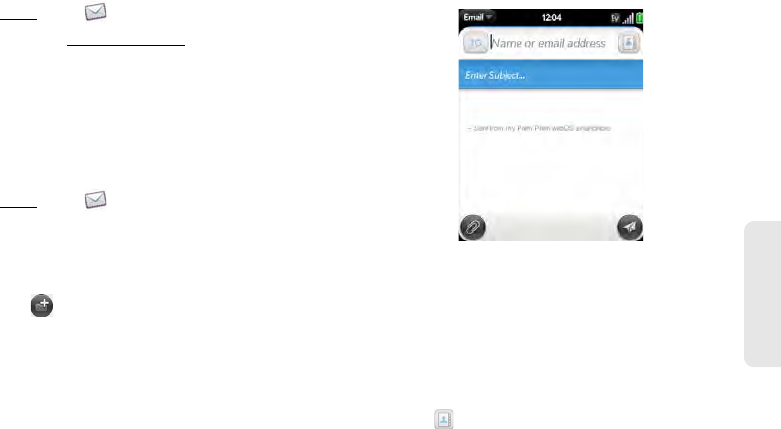
3B. Email and Other Messages 193
Email & Messaging
1. Open Email .
2. Open the application menu and tap Preferences &
Accounts.
3. Tap the account name.
4. Tap Remove Account, and then tap Remove Email
Account.
Create and Send an Email Message
1. Open Email .
2. If this is the first time you have opened the Email
application, and you have set up at least one email
account, tap Done. (If you have not set up an email
account, see “Set Up Email” on page 187.)
3. Tap .
4. (Optional) Tap From to change the email account
you are using to send the message. (This option
appears only if you have more than one email
account set up on your phone.)
5. In the To field, do one of the following to address
the message:
ⅢEnter a contact name, initials, or email address.
Tap the email address when it appears.
ⅢTap to open the full contact list. Tap the
contact you want, or enter a name or address to
narrow the list.
Regulatory Submission (10.26.09). Palm, Inc. Confidential. Top Secret.
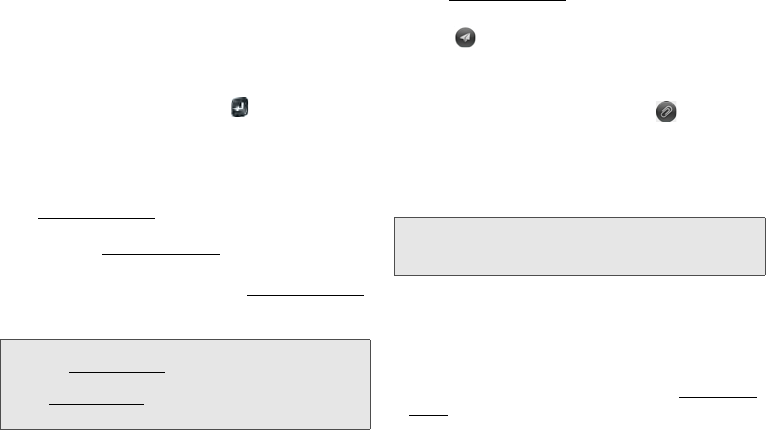
194 3B. Email and Other Messages
ⅢEnter the full email address for a recipient who is
not a contact.
6. (Optional) Tap To to open the Cc and Bcc fields,
and enter an address.
7. (Optional) Repeat steps 5 and 6 to enter additional
addresses.
8. Enter the subject, press Enter , and enter the
body text.
9. (Optional) To format body text, do one of the
following:
ⅢTo enter bold, italic, or underlined text, open the
application menu and tap Edit > [the option you
want]. Enter the text. To turn off the formatting,
open the application menu and tap Edit > [the
option you want to turn off].
ⅢTo enter colored text, open the application menu
and tap Edit > scroll down > Text Color. Tap the
color and enter the text.
10. (Optional) To set the priority for the message, open
the application menu and tap Set As Normal
Priority or Set As High Priority.
11. Tap .
Add Attachments to a Message
1. While composing a message, tap .
2. To locate a file, do the following:
ⅢTap an icon at the bottom of the screen to search
for pictures, videos, music files, or documents.
ⅢBegin typing the file name.
3. Tap the file name.
4. Repeat steps 1–3 to attach other files.
Save a Message as a Draft
ⅷWhile composing a message, open the application
menu and tap Save As Draft.
Tip: To format text you already entered, select the text, open
the application menu, and tap Edit > [the option you
want]. To turn off a formatting option, open the
application menu and tap Edit > [the option you want
to turn off]. For text color, tap the black square.
Tip: To take a new picture to send as an attachment, tap the
photo icon at the bottom of the screen and tap New
Photo.
Regulatory Submission (10.26.09). Palm, Inc. Confidential. Top Secret.
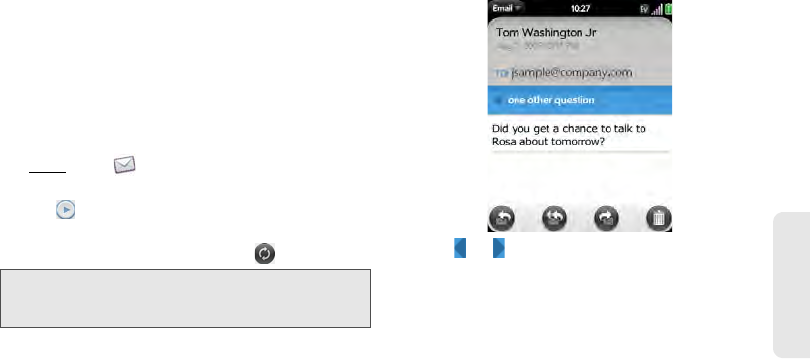
3B. Email and Other Messages 195
Email & Messaging
Receive and Read Email Messages
The Email application synchronizes messages anytime
you open a mail folder. It also synchronizes messages
on an automatic schedule—the default interval is every
30 minutes (see “Enter Advanced Account Settings” on
page 191 for information on changing the interval).
Follow these steps to manually retrieve messages.
1. Open Email .
2. If the folders for the account you want are hidden,
tap to display the folders.
3. Tap the folder you want to check messages for. (If
synchronization doesn’t start, tap .)
4. Tap a message to open it.
5. Tap or in the subject line to view the next
newer or older message.
6. To view messages for another account, make the
back gesture (see “Go Up One Level in an App
(Back Gesture)” on page 48) to return to the
account list, and tap the account name.
Save or Share an Inline Image
If a message contains an inline image—an image
inserted right into the body text—you can share the
Tip: How can you tell if sync is happening? Look for the
animated circular movement around the number of
messages in the upper-right corner of the screen.
Regulatory Submission (10.26.09). Palm, Inc. Confidential. Top Secret.
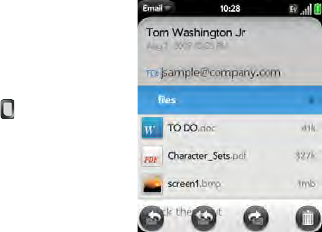
196 3B. Email and Other Messages
image with someone else via email. If you choose this
option, a new blank email message opens with the
image file as an attachment.
If the image is in JPG, BMP, or PNG format, you can
also save it to and view it in the Photos app.
1. With the message open, press and hold Option
and tap the image.
2. Tap Copy To Photos (if available) or Share.
Open Attachments
You can receive any kind of file sent to you, but you
can only open an attachment if the your phone has an
application that can open the file type.
ⅷTo open a single attachment: Tap the name to open
the attachment. For large attachments, tap the name
to fully download the attachment, and tap the name
again to open the attachment.
ⅷTo open multiple attachments: Tap the list of
attachment names to view the attachments, and tap
an attachment name to open the file.
Save Attachments
When you open attachments of certain file types, you
can save them to your phone so you can view them
later in one of your phone’s applications.
1. Open the attachment (see “Open Attachments” on
page 196).
2. Do one of the following:
ⅢFor pictures in JPG, BMP or PNG format: Tap Copy
To Photos.
Regulatory Submission (10.26.09). Palm, Inc. Confidential. Top Secret.

3B. Email and Other Messages 197
Email & Messaging
ⅢFor other file types: Open the application menu
and tap Save As. If the Save As menu item is not
available, you cannot save the attachment.
Add a Contact From an Email Message
You can add a contact name or email address to your
Contacts list directly from the To, Cc, or Bcc field of an
incoming email message. You can either create a new
contact or add the information to an existing contact.
1. In a message you received, tap the name or email
address.
2. Tap Add To Contacts.
3. Tap one of the following:
Save As New: Create a new contact for the name or
address.
Add To Existing: Tap the contact you want to add
the name or address to.
View a Contact From an Email Message
ⅷIn a message you received from someone listed in
the Contacts app, tap the name to open the contact
entry.
Search for an Email Message
You can search for messages in any email folder.
Incoming messages must be fully downloaded to your
phone to show up in search results.
ⅷIn the folder containing the message, type a few
characters of a name or email address in the From,
To, or Cc line, or a few characters of the subject.
Matching results appear as you type. Keep entering
characters to narrow the list.
Reply to a Message
1. Open a message.
2. Tap one of the following:
: Reply to just the sender.
: Reply to the sender and all other addressees.
Regulatory Submission (10.26.09). Palm, Inc. Confidential. Top Secret.

198 3B. Email and Other Messages
3. Enter the reply message text and tap .
Forward a Message
1. Open a message and tap .
2. Address the forwarded message (see “Create and
Send an Email Message” on page 193).
3. Enter the forwarded message text and tap .
Move a Message to Another Folder
1. Open a message.
2. Open the application menu and tap Move To
Folder.
3. Tap the folder you want.
Mark a Message as Read or Unread
1. Open a message.
2. Open the application menu and tap Mark As
Read/Unread.
Flag or Unflag a Message
1. Open a message.
2. Open the application menu and tap Set Flag or
Clear Flag.
Show or Hide Message Header Details
1. Open a message.
2. Tap a recipient name to show details. (Tap again to
hide details.)
Delete a Message
Deleting a message moves it to your deleted items
folder, so it’s still on your phone. Depending on your
email account, this folder is called Deleted Items,
Deleted, Trash, or something else.
If you accidentally delete a message, you can move it
back to the original folder (see “Move a Message to
Another Folder” on page 198). To remove a message
from your phone permanently, delete it from the
deleted items folder.
Regulatory Submission (10.26.09). Palm, Inc. Confidential. Top Secret.
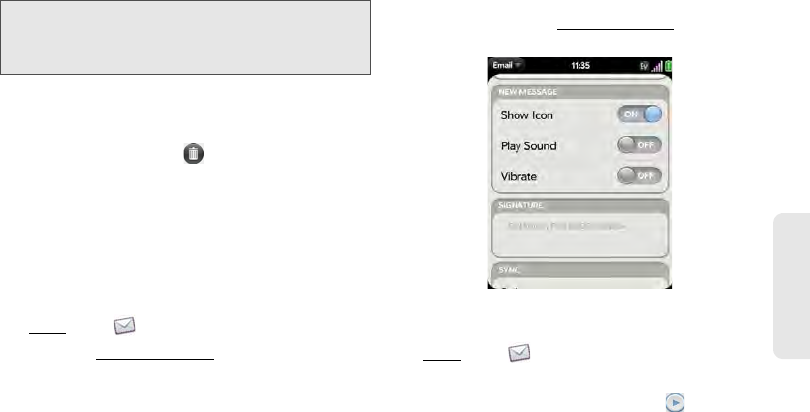
3B. Email and Other Messages 199
Email & Messaging
Do one of the following:
ⅷIn the message list: Throw the message off the side of
the screen.
ⅷIn an open message: Tap .
Add a Signature to Outgoing Messages
A signature includes information you want to add to the
closing of all your outgoing messages—for example,
your name, address, and phone numbers; your
website; or a personal motto. You can use a different
signature for each email account.
1. Open Email .
2. Open the application menu and tap Preferences &
Accounts.
3. Tap the account you want.
4. Tap the Signature field and enter the signature text.
(To format the text with bold, italics, or color, select
the text (see “Text Selection Gestures” on
page 42), open the application menu, and tap
Edit > [the option you want].)
View Mail Folders
1. Open Email .
2. Do any of the following:
ⅢView all folders for an account: Tap .
ⅢOpen a folder: Tap the folder name.
Tip: If you change the folder where you store deleted
messages for an IMAP account (see “Enter Advanced
Account Settings” on page 191), deleting messages from
this folder removes them from your phone.
Regulatory Submission (10.26.09). Palm, Inc. Confidential. Top Secret.
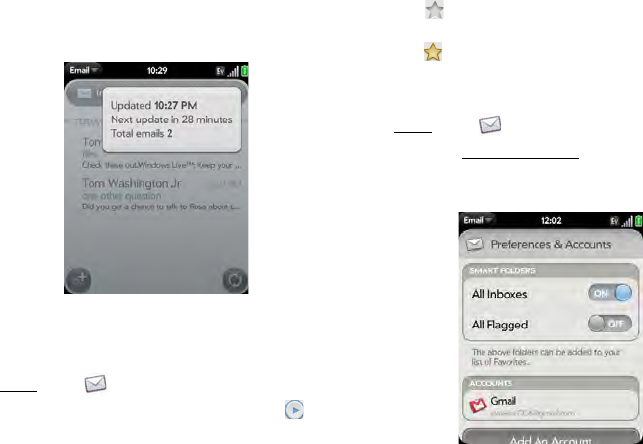
200 3B. Email and Other Messages
ⅢView folder information such as last sync and
number of messages: Open the folder, and then
tap the folder header.
Add a Folder as a Favorite
Favorites appear at the top of Account List view.
1. Open Email .
2. If the folder you want is not displayed, tap to
the right of the email account name to display the
folder.
3. Tap to the right of the folder name.
To remove a folder as a favorite, repeat steps 1 and 2
and tap to the right of the folder name.
Set Email Preferences
1. Open Email .
2. Open the application menu and tap Preferences &
Accounts.
3. Set any of the following:
Regulatory Submission (10.26.09). Palm, Inc. Confidential. Top Secret.

3B. Email and Other Messages 201
Email & Messaging
Smart Folders: Set whether to include All Inboxes
and/or All Flagged messages as favorites at the
top of Account List view.
Accounts: Tap an account name to enter advanced
settings (see “Enter Advanced Account Settings”
on page 191).
Default Account: Tap the account shown to set
another account as the default. The default
account is used to send a message when you
create a new message in Account List view or in a
merged folder such as All Inboxes or All Flagged. If
you have only one email account on your phone,
the Default Account preference is not displayed.
Add An Account: See “Set Up Email” on page 187.
Reorder Accounts
1. Open Email .
2. Open the application menu and tap Preferences &
Accounts.
3. Tap and hold the account name, wait for the visual
cue, and then drag the account up or down. (This
changes the order of the accounts in Account List
view.)
Reply to Meeting Invitations
You can receive meeting invitations on your phone in
the same way that you receive email messages. You
cannot create meeting invitations on your phone.
ⅷTap whether to accept, tentatively accept, or decline
an invitation.
Here are the key features of meeting invitations:
ⅷMeeting invitations appear on your phone in the
Email application, not in the Calendar application.
ⅷFrom within the Email application, you can accept,
decline, or tentatively accept a meeting invitation.
ⅷIf you accept or tentatively accept an invitation, it
appears as an event in Calendar.
ⅷYou can reply to and forward meeting invitations in
the same way as email messages.
Tip: If you receive an updated meeting invitation, you can
again choose to accept, decline, or tentatively accept. If
you receive a meeting cancellation, open the message
and tap Remove From Calendar to delete the meeting
from your calendar.
Regulatory Submission (10.26.09). Palm, Inc. Confidential. Top Secret.

202 3B. Email and Other Messages
Send Email Messages From Within
Another Application
Use the share menu item in any application that
supports this feature to send an item as an attachment
to an email message. This feature is supported in the
Contacts, Photos, Doc View, PDF View, and Memos
applications, among others. Depending on the app, the
menu item might be named Share, Send, or Email. For
details, see the section on the specific application.
Messaging
What Kinds of Messages Can I Send and
Receive?
You can use the Messaging application to send and
receive the following types of messages:
ⅷText and multimedia messages (see “Create and
Send a Text or Multimedia Message” on page 205).
ⅷInstant messages for an IM account you already
have set up online (see “Set Up an Instant
Messaging (IM) Account” on page 209).
The Synergy feature enables the Messaging app to
gather all your text, multimedia, and instant messages
to and from the same contact into a single
conversation (sometimes called a thread). So you can
see your entire message history with a person
regardless of the different methods you happened to
use to communicate with that person (see “Work With
Conversations” on page 202). You can even switch
from account to account without losing the thread of
your conversation (see “Switch Between Messaging
Accounts in a Conversation” on page 203)—just pick
the messaging account that’s most likely to keep you in
unbroken contact with the person you're talking to.
Work With Conversations
When you exchange more than one message with a
person, the messages are grouped into a conversation.
A single conversation can contain text, multimedia, and
IM messages. When you start or continue a
Regulatory Submission (10.26.09). Palm, Inc. Confidential. Top Secret.

3B. Email and Other Messages 203
Email & Messaging
conversation, the upper part of Conversation view
displays all messages you’ve exchanged with this
person, and the bottom part provides the area where
you type your next message.
You can carry on multiple conversations at the same
time.
1. Open Messaging .
2. Do one of the following:
ⅢStart a new conversation: Create a message (see
“Create and Send a Text or Multimedia Message”
on page 205 or “Send and Receive IM
Messages” on page 211), or tap a message and
reply to it.
ⅢContinue an existing conversation: Tap the
conversation.
3. Enter your message.
4. Tap .
Switch Between Messaging Accounts in a
Conversation
In a single conversation, you can switch between
text/multimedia messaging and an IM account. So if
you are having an IM chat with someone and he or she
goes offline, you can send the person a text message
to wrap up the conversation. You can also switch
between different phone numbers for sending a text
message to a person.
1. In Messaging, start a new conversation or open
one that’s listed in Conversations view.
2. Tap Text or an IM account name in the upper-right
corner of the screen. (If available, the other ways to
Tip: To save the contents of a conversation, open the
conversation, open the application menu, and tap Copy
All. This saves the entire conversation as plain text, which
you can paste in a memo, email message, and so on.
Regulatory Submission (10.26.09). Palm, Inc. Confidential. Top Secret.
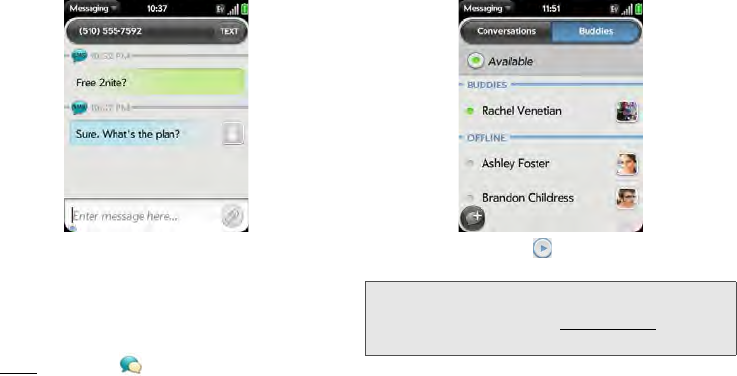
204 3B. Email and Other Messages
communicate with this contact appear in a list. Tap
the account or phone number you want to use.)
Switch Between Conversations View and
Buddies View
Conversations view lists all of your Messaging
conversations. Buddies view lists all of your IM buddies.
1. Open Messaging .
2. For Conversations view, tap Conversations. (For
Buddies view, tap Buddies.)
3. In Buddies view, tap to expand a buddy list.
(Tap a buddy name to contact that person.)
Tip: You can set a preference to show all your buddies,
whether they are on- or offline, or to hide offline buddies.
In Buddies view, open the application menu and tap
Show/Hide Offline Buddies.
Regulatory Submission (10.26.09). Palm, Inc. Confidential. Top Secret.

3B. Email and Other Messages 205
Email & Messaging
Create and Send a Text or Multimedia
Message
Each text message can have up to 160 characters. If
you send a text message to an email address, the
email address is deducted from the 160-character
count.
Multimedia messages consist of both text and pictures.
You can include pictures in JPG format.
1. Open Messaging .
2. The first time you open Messaging, tap Done to
send a text or multimedia message. (Thereafter,
skip to step 3.)
3. Tap . (The cursor is in the To field.) Do one of
the following to address the message:
ⅢEnter a contact’s first or last name or initials,
screen name, phone number, or email address.
Tap the phone number, IM, or email address you
want to use to send the message when it
appears.
ⅢTap to open your full contact list. Tap the
contact you want or enter a name or address to
narrow the list.
ⅢEnter a phone number for a recipient who is not a
contact.
4. Tap the To field and repeat step 3 to enter
additional recipients.
Did You Know? You can send and receive text messages
even while you are on a phone call. This is
easiest when using a hands-free headset or
the speaker.
Before You Begin: Make sure that your phone is on and that
you’re inside a coverage area (see “Turn
Wireless Services On” on page 20).
Tip: If you want to set up an instant messaging (IM) account
the first time you open Messaging, tap Add An Account
and see “Set Up an Instant Messaging (IM) Account” on
page 209 for instructions.
Tip: Do you need to enter a short code that contains letters?
Use the keyboard to enter it; just press the letter keys. For
example, if the code is “win01,” press W to enter w, I to
enter i, and so on. No need to figure out the numbers that
correspond to the letters.
Regulatory Submission (10.26.09). Palm, Inc. Confidential. Top Secret.
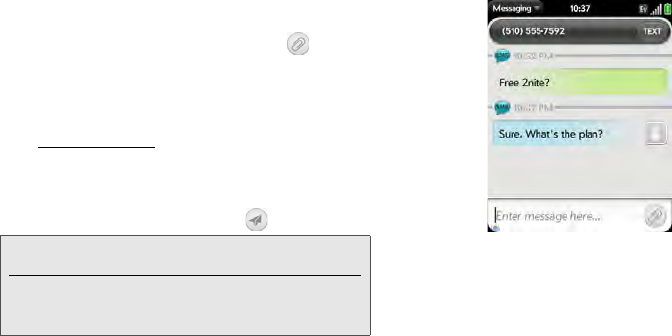
206 3B. Email and Other Messages
5. Do one of the following to attach a picture to a
multimedia message:
ⅢBefore entering the message text: Tap . Tap the
album containing the picture you want. Tap the
picture, or tap New Photo and take the picture.
Tap Attach Photo.
ⅢAfter entering the message text: Open the
application menu and tap Add Picture. Tap the
album containing the picture you want and tap
the picture, or tap New Photo and take the picture.
Tap Attach Photo.
6. Enter the message text and tap .
Use Emoticons in a Message
To include an emoticon in a text, multimedia, or IM
message, type in a keyboard character combination for
that emoticon. Most emoticons can be created by more
than one combination. After you send the message, the
emoticon image appears in the conversation on your
phone and on the recipient’s phone, as long as the
receiving IM application supports the image.
Tip: You can include emoticons in your message (see “Use
Emoticons in a Message” on page 206).
Tip: You can also send a contact entry as part of a
multimedia message. Do this in the Contacts app (see
“Sending Contacts” on page 134).
Regulatory Submission (10.26.09). Palm, Inc. Confidential. Top Secret.

3B. Email and Other Messages 207
Email & Messaging
This table shows the emoticons that are supported on
your phone.
Note: Emoticon combinations that use words, such as :cool
or :cry, are not supported in most chat applications.
Emoticons created using these combinations may not
appear correctly on the recipient’s phone.
To display this
emoticon...
Enter any of these keyboard character
combinations...
>:o >:-o >:O >:-O >:( >:-(
:angry :mad
o_O :confused
8) 8-) B) B-) :cool
:’( =’( :cry
:[ :-[ =[ =-[ redface
:S :-S :s :-s %-( %( X-( X(
:eww :gross
:! :-! :eek
(:-(=(=-(:sad
:O :-O :o :-o =O =-O =o
=-o :surprised :shock :omg
^^ ^_^ ^-^ :grin :biggrin
<3 :heart
O:) O:-) o:) o:-) :innocent :angel
:-*:*=*=-*:kiss
:-D:D=D=-D laugh:lol
>:-) >:) >:-> >:> :evil :twisted
To display this
emoticon...
Enter any of these keyboard character
combinations...
Regulatory Submission (10.26.09). Palm, Inc. Confidential. Top Secret.

208 3B. Email and Other Messages
Receive and View Text and Multimedia
Messages
You can view pictures and videos and listen to music
files included in a multimedia message. You can save
pictures in JPG format to your phone for viewing in the
Photos application.
1. Open Messaging .
2. Tap a conversation to view messages.
3. In a multimedia message, tap a music, video, or
vCard file name to view the attached file.
((Attached pictures are displayed within the
message.) Tap Copy Photo to save an attached
JPG picture.)
Add a Contact From a Message
1. In a conversation, tap the header of a message
received from someone who is not a contact.
2. Tap Add To Contacts.
3. Tap one of the following:
Save As New: Create a new contact for the name or
address.
Add To Existing: Tap the contact you want to add
the name or address to.
:| :-| :neutral :meh
:-&:&=&=-&:-@:@=@
=-@ :sick
:) :-) =) =-) :smile
:/ :-/ :\ :-\ =/ =-/ =\ =-\
:doh
;) ;-) :wink
:P:-P:p:-p:b:-b=p=P
=b =-b =-p =-P :yuck :razz
To display this
emoticon...
Enter any of these keyboard character
combinations...
Regulatory Submission (10.26.09). Palm, Inc. Confidential. Top Secret.

3B. Email and Other Messages 209
Email & Messaging
View a Contact’s Information From a
Message
ᮣIn a conversation, tap the header of a message
received from a contact to open the contact entry.
Dial a Number From a Message
ᮣTap a phone number.
Delete a Message
1. In a conversation, throw the message off the side
of the screen.
2. Tap Delete to confirm.
Delete a Conversation
1. In Conversations view, throw the conversation off
the side of the screen.
2. Tap Delete to confirm.
Set Up an Instant Messaging (IM) Account
To use an IM account on your phone, such as a
GoogleTalk IM account, you must already have the
account online. If you have an IM account with a
provider that takes advantage of the Synergy feature,
that IM account is automatically added to your phone
when you enter your username and password for that
provider in Email, Calendar, or Contacts.
1. Open Messaging .
2. Do one of the following:
ⅢThe first time you open Messaging: Tap Add An
Account.
ⅢAny other time: Open the application menu and
tap Preferences & Accounts. Tap Add IM Account.
Regulatory Submission (10.26.09). Palm, Inc. Confidential. Top Secret.
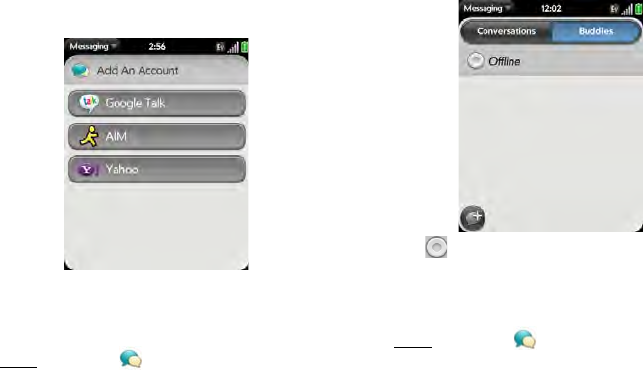
210 3B. Email and Other Messages
3. Tap the account type and enter your username
and password.
4. Tap Sign In.
Sign In to an IM Account
1. Open Messaging .
2. Tap Buddies.
3. Tap to the left of the text Offline and tap
Available.
Sign Out of an IM Account
1. Open Messaging .
2. Tap Buddies.
3. Tap the status icon to the left of your online status
(Available or Busy) and tap Sign off.
Regulatory Submission (10.26.09). Palm, Inc. Confidential. Top Secret.
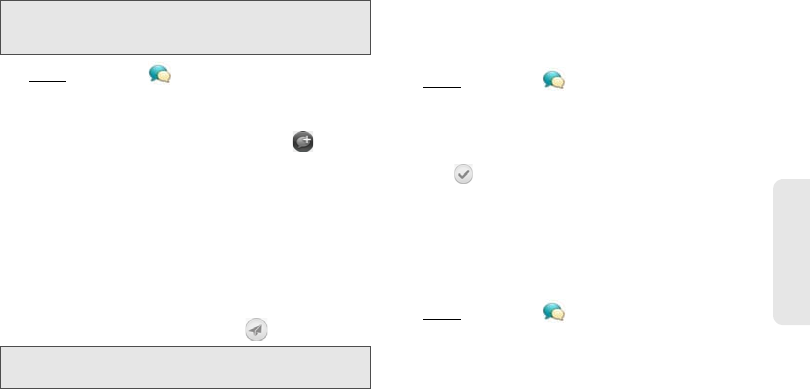
3B. Email and Other Messages 211
Email & Messaging
Send and Receive IM Messages
1. Open Messaging .
2. Do one of the following to start or continue a
conversation:
ⅢIn Conversations or Buddies view, tap to start
a new conversation.
ⅢIn Conversations view, tap an existing
conversation and enter a new message.
ⅢIn Buddies view, tap a buddy name and enter a
new message.
3. Tap Text or an IM account name in the upper-right
corner of the screen, and tap the IM account you
want to use.
4. Enter the message text and tap .
5. When the message recipient replies, the reply
appears below your message in the conversation.
(Repeat step 4 to send another message.)
Change Your Online Status
1. Open Messaging .
2. Tap Buddies.
3. Tap the status icon to the left of the status
description, and tap your new status.
4. Tap to confirm your status.
Change Your Custom Message
Your custom message is seen by your IM buddies. It
appears next to your IM screen name and status. It can
contain any text you want.
1. Open Messaging .
2. Tap Buddies.
Before You Begin: Make sure that your phone is on and that
you’re inside a coverage area (see “Turn
Wireless Services On” on page 20).
Tip: You can include emoticons in your message (see “Use
Emoticons in a Message” on page 206).
Regulatory Submission (10.26.09). Palm, Inc. Confidential. Top Secret.

212 3B. Email and Other Messages
3. Do one of the following:
ⅢIf you already have a custom message: Tap the
current message and enter the new message
text.
ⅢIf you’re creating a custom message for the first
time: Tap the status text (Available, Busy, and so
on) and enter the custom message text.
Change Your IM Account Username and
Password
If you change the username or password for your IM
account online, you need to enter the updated
information for the account on your phone.
1. Open Messaging .
2. Open the application menu and tap Preferences &
Accounts.
3. Tap the account name.
4. Enter the new information and tap Sign In.
Delete an IM Account
1. Open Messaging .
2. Open the application menu and tap Preferences &
Accounts.
3. Tap the account name.
4. Tap Remove Account, and tap Remove Account
again to confirm.
Turn Messaging Notifications On or Off
You can set your phone to show a notification and/or
play a sound when a new message arrives. These
settings apply to all your Messaging accounts.
1. Open Messaging .
2. Open the application menu and tap Preferences &
Accounts.
3. Turn either of the following new message
notifications on or off:
Regulatory Submission (10.26.09). Palm, Inc. Confidential. Top Secret.
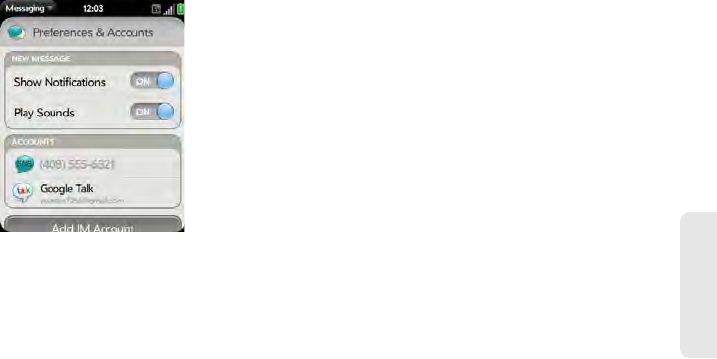
3B. Email and Other Messages 213
Email & Messaging
Show Notifications: Set whether a notification
appears when you receive a new message.
Play Sounds: Set whether an alert sound plays
when you receive a new message. The ringer
switch must be set to On for you to hear the sound.
Regulatory Submission (10.26.09). Palm, Inc. Confidential. Top Secret.

214 3C. Web and Wireless Connections
3C. Web and Wireless
Connections
ࡗLocation Services (page 214)
ࡗWeb (page 215)
ࡗGoogle Maps (page 223)
ࡗSprint Navigation (page 224)
ࡗBluetooth® Wireless Technology (page 226)
Location Services
The Location Services application provides information
about your location to applications that request it. For
example, Google Maps may use your location
information if you need driving directions.
1. Open Location Services .
2. The first time you open Location Services you may
be asked to review and accept the terms of use,
and decide whether to allow anonymous data
collection. Tap Next and do the following:
ⅢReview the terms of use.
ⅢIf you decide not to allow anonymous data
collection, tap the checkmark to remove it.
ⅢTap Agree or Don’t Agree.
3. Decide whether to enable auto locate, or whether
you want to be asked each time an application
needs to know your location: Tap Auto Locate or
Ask Each Time.
4. To change settings after you accept the terms of
use, tap On or Off for any of the following:
Regulatory Submission (10.26.09). Palm, Inc. Confidential. Top Secret.
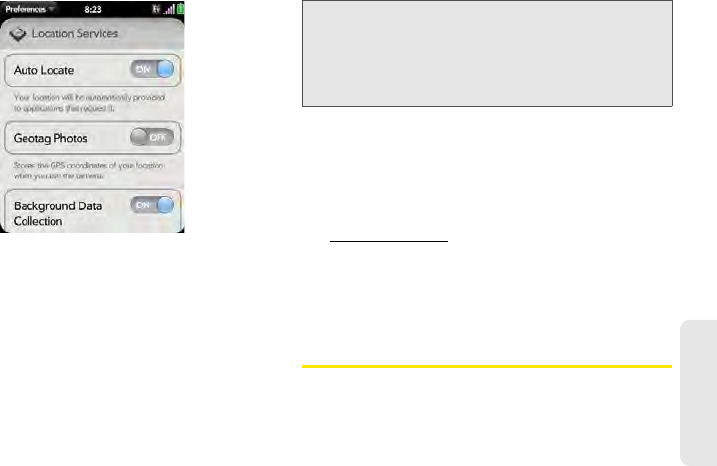
3C. Web and Wireless Connections 215
Wireless Connections
ⅢAuto Locate: If you turn Auto Locate off and an
application subsequently needs to know your
location, a notification appears asking if the
application can identify your location. Tap Allow
to turn on Location Services for that session only.
ⅢGeotag Photos: If Geotag Photos is turned on,
photos are tagged with the latitude and longitude
coordinates of the location in which they were
taken.
ⅢBackground Data Collection: Turn on Background
Data Collection to allow the collection of
anonymous aggregate location data to improve
the quality of the location services provided to
applications that require them.
5. To choose how you want to be located, open
application menu, tap Locate Me Using, and
choose one or both of the following:
ⅢGPS.
ⅢGoogle Service.
Web
Go to a Website
The Web browser on your phone is capable of
displaying most Web content. The browser features the
Did You Know? The geotag is stored as an EXIF tag in the
photo file, not on the image itself. A common
use of the geotag occurs in online photo
services like Photobucket and desktop apps
like Google Earth, which use the data to
position the photo as a thumbnail on a map.
Regulatory Submission (10.26.09). Palm, Inc. Confidential. Top Secret.
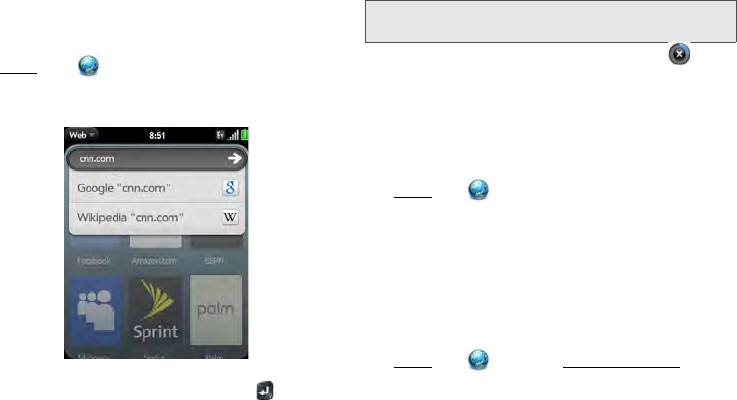
216 3C. Web and Wireless Connections
latest Web standard technologies such as HTML 4.01,
CSS 2.1, Ajax, and JavaScript. It does not support
plug-ins such as Flash or Java applets.
1. Open Web .
2. Enter the address of the page. (You don’t need to
enter the prefix http://www.)
If the page appears in the list of viewed pages, tap
it to go there again. If not, press Enter
3. To cancel a page while it is loading, tap .
Go to a Website Using Search
You can also search the Web from the Launcher or
Card view (see “Search to Find Info and Make Calls”
on page 61).
1. Open Web .
2. Enter the search term and tap a search option.
Open Another Browser
If you are looking at one Web page and need to check
something on a different one, simply open another
browser.
1. Open Web , open the application menu , and
tap New card.
2. Enter an address or search term for the second
instance of the browser.
Did You Know? If you browse to a secure Web page, the lock
icon in the address line appears closed.
Regulatory Submission (10.26.09). Palm, Inc. Confidential. Top Secret.

3C. Web and Wireless Connections 217
Wireless Connections
3. To move between the two pages, tap the center of
the gesture area to display Card view. Tap one
Web page and then the other to go between the
two.
Navigate a Web Page
ⅷMove back through previously viewed pages: Tap
or make the back gesture from right to left anywhere
in the gesture area.
ⅷMove forward through previously viewed pages:
Tap or make the forward gesture from left to right
anywhere in the gesture area.
ⅷRefresh the current page: Tap .
ⅷScroll a page: Swipe up or down on the screen.
ⅷView a Web page in landscape mode: Turn the phone
on its side. When the display is in landscape mode,
you can swipe up and down on the gesture area to
scroll up and down a page.
ⅷZoom in or out on a page: Pinch out to enlarge items
onscreen. Pinch in to decrease the size of items
onscreen. Double-tap the screen to zoom in or out a
specified amount.
ⅷZoom in on a column of a Web page: Double-tap the
page to center a column and enlarge it. To zoom out
to see the whole page again, keep double-tapping.
ⅷPan a page: Tap, hold, and drag the page.
ⅷEnter information in a form: Tap the form field. Enter or
select information and press Enter .
ⅷShare a Web address as a link: Open the application
menu, tap Page, and tap Share. Create the email
message.
ⅷDisplay the address bar: Start typing a search term or
Web address, or scroll to the top of the page.
Add a Web Page to the Launcher
Add any Web pages you visit frequently to the
Launcher so you can access them in a few taps.
1. Open the page you want to add to the Launcher.
2. Open the application menu, tap Page, and tap Add
To Launcher.
Regulatory Submission (10.26.09). Palm, Inc. Confidential. Top Secret.

218 3C. Web and Wireless Connections
3. Enter any of the following:
Icon: Tap the currently displayed page icon
thumbnail. Then tap, hold, and drag the Web page
to use a different portion of the page as the
Launcher icon. You can zoom in on or out of the
page while selecting the portion you want to use.
The portion that appears in the white square is
used as the icon. Tap Done.
Title: See “Text Selection Gestures” on page 42 for
useful gestures if you want to edit the page title.
URL: Enter or edit the URL for the page. For
example, change the URL to the home page of a
site instead of a drill-down page within the site.
4. Tap Add To Launcher.
The page now appears as an icon on the Launcher.
Tap the icon to open the page. To delete the page from
the Launcher, see “Delete an Application” on page 52.
Create a Bookmark
1. Open the page you want to bookmark.
2. Open the application menu and tap Add
Bookmark.
Regulatory Submission (10.26.09). Palm, Inc. Confidential. Top Secret.

3C. Web and Wireless Connections 219
Wireless Connections
3. Enter any of the following:
Icon: Tap the currently displayed bookmark icon.
Then tap, hold, and drag the Web page to use a
different portion of the page as the bookmark icon.
You can zoom in on or out of the page while
selecting the portion you want to use. The portion
that appears in the white square is used as the
icon. If you add the bookmark to the Launcher, the
icon is used as the Launcher icon. Tap Done.
Title: See “Text Selection Gestures” on page 42 for
useful gestures if you want to edit the bookmark
title.
URL: Enter or edit the URL for the bookmark. For
example, change the URL to the home page of a
site instead of a drill-down page within the site.
4. Tap Add Bookmark.
The first 12 bookmarks you create become thumbnails
on the start page of the Web app.
Open a Bookmarked Page
Do one of the following:
ⅷFrom the start page when you open the browser, tap
a thumbnail.
Regulatory Submission (10.26.09). Palm, Inc. Confidential. Top Secret.
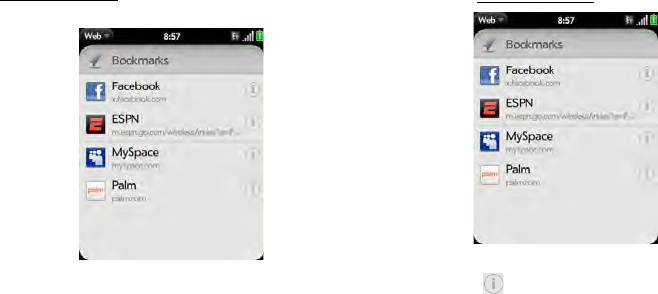
220 3C. Web and Wireless Connections
ⅷTo open a bookmark if it’s not on the start page, or
after you navigate away from the start page, open the
application menu and tap Bookmarks. Then tap a
bookmark.
Edit, Reorder, or Delete a Bookmark
1. Open the application menu and tap Bookmarks.
2. Do one of the following:
ⅢEdit: Tap to the right of the bookmark name.
Enter the new icon, title, or URL and tap Save
Bookmark.
Regulatory Submission (10.26.09). Palm, Inc. Confidential. Top Secret.
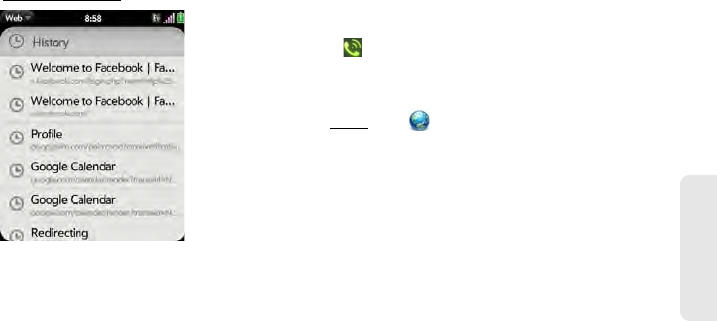
3C. Web and Wireless Connections 221
Wireless Connections
ⅢReorder: Tap, hold, wait for the visual cue, and
then drag the bookmark.
ⅢDelete: Throw the bookmark off the side of the
screen and tap Delete.
Return to Previously Viewed Web Pages
1. Open the application menu and tap History.
2. Scroll to the page name and tap the page.
You can also search for a recently viewed page by
entering a term or address in the address bar that
matches the page name or address.
Use Links on a Web Page
ⅷTo follow a link to another page: Zoom in on the page
(pinch out or double-tap the page), and tap the link.
ⅷTo dial a phone number that appears as a link: Tap the
link to display the dial pad with number entered, and
tap .
Customize Web Browser Settings
1. Open Web .
Regulatory Submission (10.26.09). Palm, Inc. Confidential. Top Secret.
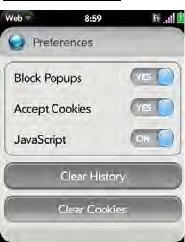
222 3C. Web and Wireless Connections
2. Open the application menu and tap Preferences.
3. Set any of the following:
Block Popups: Prevents websites from opening up
new browser windows. Tap Yes to turn Block
Popups off.
Accept Cookies: Allows cookies from any website
you view, even if you are redirected to a site from
another site. Tap Yes to turn Accept Cookies off.
JavaScript” Tap On to turn off JavaScript. Turning
off JavaScript may prevent some websites from
functioning properly.
Clear History: Tap to delete your browsing history.
Clear Cookies: Tap to delete cookies used by some
websites to remember visiting history and user
settings.
Clear Cache: Tap to delete any Web page content
that has been stored in the local cache. This
ensures that you are viewing the most current
content when you visit a Web page.
Regulatory Submission (10.26.09). Palm, Inc. Confidential. Top Secret.
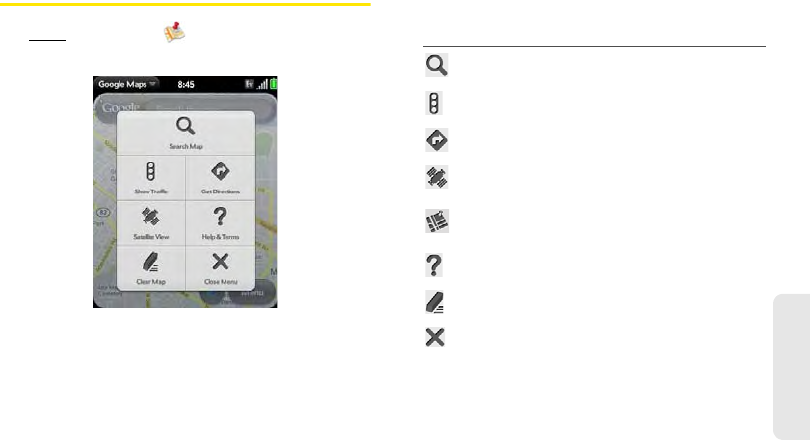
3C. Web and Wireless Connections 223
Wireless Connections
Google Maps
1. Open Google Maps .
2. Tap Menu in the lower-right corner.
In Google Maps, use these icons to do the
following:
Icon Description
Search Map: Search for a location.
Show Traffic: View local traffic conditions.
Directions: Get directions.
Satellite: View a satellite photo of the map
area.
Map: Return to Map View from Satellite
View.
Help & Terms: Get help.
Clear Map: Clear the current map.
Close Menu: Close the Google Maps
menu.
Regulatory Submission (10.26.09). Palm, Inc. Confidential. Top Secret.
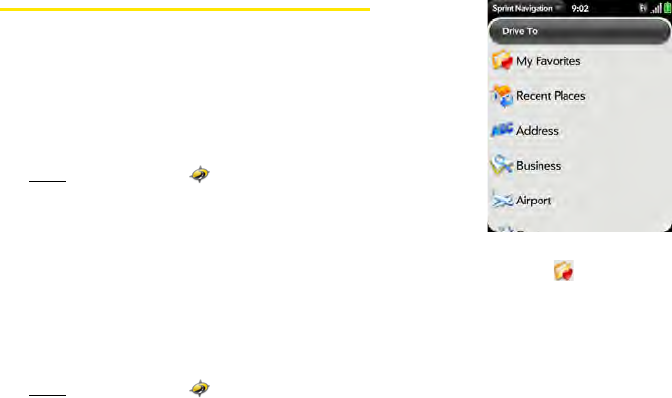
224 3C. Web and Wireless Connections
Sprint Navigation
You can use Sprint Navigation to get driving directions,
check traffic conditions, and search for services.
Sign In to Sprint Navigation
The first time you use Sprint Navigation, you are asked
to sign in.
1. Open Sprint Navigation .
2. If prompted, tap Accept to turn on Location
Services.
3. Review the terms of use and tap Accept or Decline.
4. Enter your first name, last name, and email
address (your email address is optional).
5. Tap Continue.
Get Directions
1. Open Sprint Navigation .
2. Tap Drive To.
3. Tap any of the following:
ⅢMy Favorites: Tap to add an address.
ⅢRecent Places: View directions to places you
visited recently.
ⅢAddress: Search for directions to a specific street
address, intersection, or city.
ⅢBusiness: Search for a business address.
ⅢAirport: Get directions to an airport.
ⅢContact: Get directions to a contact’s address.
Regulatory Submission (10.26.09). Palm, Inc. Confidential. Top Secret.
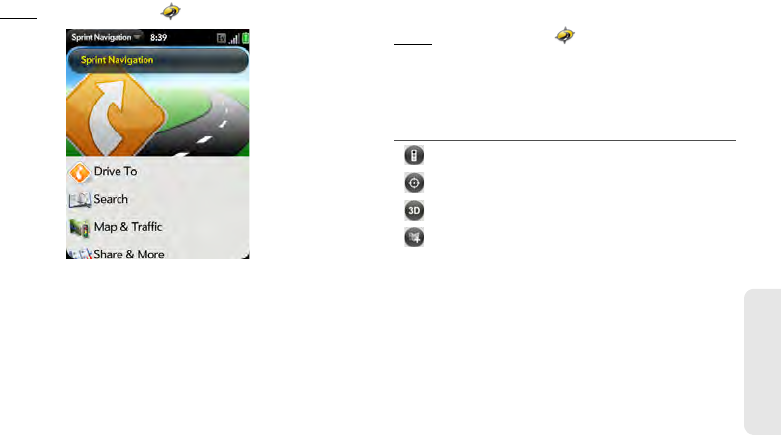
3C. Web and Wireless Connections 225
Wireless Connections
Search for a Service
1. Open Sprint Navigation .
2. Tap Search.
3. Tap the Search Near field and tap where you want
to base your search.
4. Tap the Category field and tap the type of service
you are looking for.
5. Tap Search.
Get Your Location and Local Traffic
Information
1. Open Sprint Navigation .
2. Tap Map & Traffic.
3. Use these icons to do the following:
Icon Description
View traffic information.
See your current location.
View the map in 3D.
Return to the Sprint Navigation menu.
Regulatory Submission (10.26.09). Palm, Inc. Confidential. Top Secret.

226 3C. Web and Wireless Connections
Bluetooth® Wireless Technology
What is Bluetooth® Wireless Technology?
With the Bluetooth® wireless technology on your phone,
you can connect to a number of Bluetooth devices,
including a hands-free device such as a headset or car
kit; see “Set Up and Use a Bluetooth® Hands-Free
Device” on page 96.
Before you can connect to another Bluetooth device,
you need to pair with that device. You can either make
the pairing request from your phone (see “Make a
Pairing Request to Another Device” on page 226), or
accept a pairing request from the other device (see
“Accept a Pairing Request From Another Device” on
page 227).
Turn the Bluetooth Feature On/Off
Do one of the following:
ⅷOpen Bluetooth , and tap On or Off.
ⅷFrom any screen: Open the connection menu, tap
Bluetooth, and tap Turn on Bluetooth or Turn off
Bluetooth.
Make a Pairing Request to Another Device
You can make a pairing request to a Bluetooth audio
device such as a headset, car kit, or A2DP device.
1. Open Bluetooth .
2. Make sure Bluetooth is on (see “Turn the Bluetooth
Feature On/Off” on page 226).
Before You Begin: The other device must be discoverable to
appear on your phone’s Devices list.
Check the documentation that came with
the other device for information on
making it discoverable.
Regulatory Submission (10.26.09). Palm, Inc. Confidential. Top Secret.
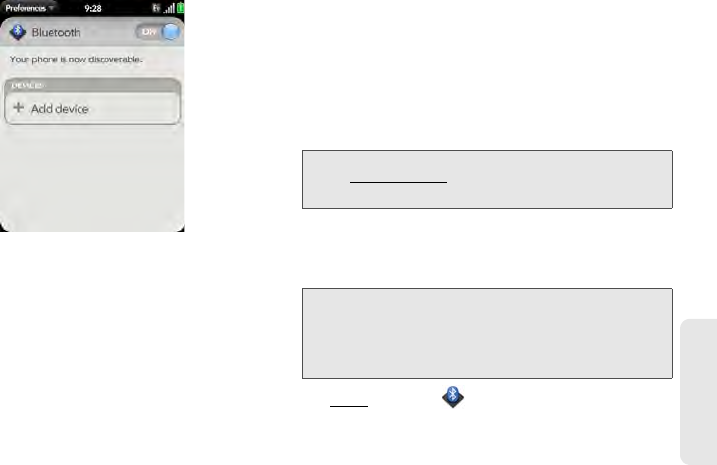
3C. Web and Wireless Connections 227
Wireless Connections
3. Tap Add device and tap the device name on the list
of available Bluetooth devices.
4. If a passkey is not required, pairing is complete
when the Devices list appears. (If a passkey is
required, tap Yes, allow.)
5. Do one of the following:
ⅢAn automatically generated passkey appears on the
passkey screen: Check the other device screen to
verify that the passkey is correct, and tap Yes,
connect to connect.
ⅢThe screen displays a passkey generated by your
phone: Enter the displayed passkey on the other
device.
ⅢThe screen prompts you to enter a passkey: Check
the documentation that came with the other
device to see if there's a required passkey. If so,
enter that passkey on your phone. If not, make up
a passkey and enter it on both devices.
Accept a Pairing Request From Another
Device
1. Open Bluetooth .
2. Make sure Bluetooth is on (see “Turn the Bluetooth
Feature On/Off” on page 226).
Tip: You can also open the Bluetooth app by opening the
connection menu, tapping Bluetooth, and tapping
Bluetooth Preferences.
Note: Your phone is discoverable only when the Bluetooth
app is open, the app window is maximized, and
Bluetooth is turned on. If you move away from the
Bluetooth app, minimize the app to a card, or turn off
the screen, your phone is no longer discoverable.
Regulatory Submission (10.26.09). Palm, Inc. Confidential. Top Secret.
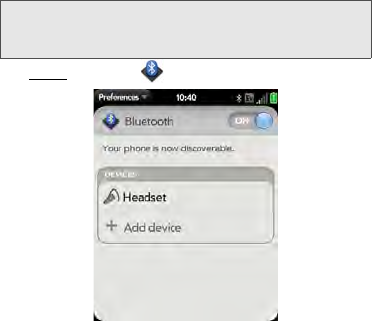
228 3C. Web and Wireless Connections
3. Initiate a pairing from the other device.
4. When the connection request appears, tap Yes,
allow.
5. If a passkey is not required, pairing is complete
when the Devices list appears. If a passkey screen
appears, do one of the following:
ⅢAn automatically generated passkey appears on the
passkey screen: Check the other device screen to
verify that the passkey is correct, and tap Yes,
connect to connect.
ⅢThe screen displays a passkey generated by your
phone: Enter the displayed passkey on the other
device.
ⅢThe screen prompts you to enter a passkey: Check
the documentation that came with the other
device to see if there's a required passkey. If so,
enter that passkey on your phone. If not, make up
a passkey and enter it on both devices.
Connect With a Paired Device
After you pair with a device, you can connect to that
device without having to go through the pairing
process again.
1. Open Bluetooth .
Note: To connect with a paired computer, you must initiate
the connection from the computer. See the computer
documentation for instructions.
Regulatory Submission (10.26.09). Palm, Inc. Confidential. Top Secret.

3C. Web and Wireless Connections 229
Wireless Connections
2. Make sure Bluetooth is on (see “Turn the Bluetooth
Feature On/Off” on page 226) and tap the device
name.
Disconnect From a Device
Disconnecting from a device does not mean you delete
the relationship you created between the device and
your phone. See “Connect With a Paired Device” on
page 228 for instructions on how to reconnect with the
device.
1. Open Bluetooth .
2. Tap the connected device name to disconnect
from it. (Or tap another device name to disconnect
from the current device and connect to the new
device.)
Delete a Device
Deleting a device means you end the relationship you
created between your phone and the device. This
means that you must pair with the device again if you
want to connect (see “Make a Pairing Request to
Another Device” on page 226 or “Accept a Pairing
Request From Another Device” on page 227). If all you
want to do is temporarily disconnect from a device, see
“Disconnect From a Device” on page 229.
1. Open Bluetooth .
2. Throw the name off the side of the screen and tap
Delete.
Rename a Device
1. Open Bluetooth .
2. Tap and hold the device name.
3. Enter a new name.
Regulatory Submission (10.26.09). Palm, Inc. Confidential. Top Secret.
230 3C. Web and Wireless Connections
Regulatory Submission (10.26.09). Palm, Inc. Confidential. Top Secret.
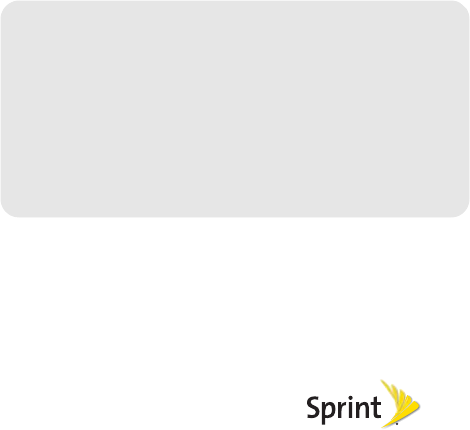
Your Resources
Section 4
Regulatory Submission (10.26.09). Palm, Inc. Confidential. Top Secret.

232 4A. Troubleshooting
4A. Troubleshooting
ࡗFor Users of Other Palm® Devices (page 232)
ࡗBattery (page 233)
ࡗScreen and Performance (page 242)
ࡗPhone (page 244)
ࡗHands-Free Devices (page 246)
ࡗSynchronization (page 247)
ࡗSending and Receiving Data in Email, Messaging, and
Web (page 251)
ࡗEmail (page 252)
ࡗMessaging (page 254)
ࡗWeb (page 255)
ࡗCalendar and Contacts (page 256)
ࡗCamera (page 258)
ࡗAmazon MP3 (page 258)
ࡗTransferring Information From Your Computer (page 259)
ࡗBacking Up and Restoring Data (page 260)
ࡗUpdates (page 261)
ࡗThird-Party Applications (page 261)
ࡗMaking Room on Your Phone (page 262)
For Users of Other Palm® Devices
I Want to Transfer My Data From My
Computer
If you previously synchronized data from a Palm®
smartphone—such as contacts or calendar events—with
a desktop organizer such as Palm® Desktop by
ACCESS or Microsoft Outlook®, you can do a one-time,
one-way export of that data from the desktop organizer
to your Palm® Pixi™ phone.
Windows: You can transfer contacts, calendar events,
tasks, and memos/notes from Palm Desktop software
by ACCESS version 6.2 and Microsoft Outlook 2003 or
later. If you don't have Palm Desktop version 6.2,
download it for free from palm.com/support.
Important: If your desktop Outlook synchronizes with an
Exchange server using Microsoft Exchange
ActiveSync, you cannot do a one-way export of that
Outlook data to your phone. Instead, set up your
Exchange account to synchronize with your phone
(see “How Do I Send and Receive Email on My
Phone?” on page 186).
Regulatory Submission (10.26.09). Palm, Inc. Confidential. Top Secret.

4A. Troubleshooting 233
Help
Mac: You can transfer contacts, calendar events, and
tasks from Address Book, iCal, Palm Desktop software
by ACCESS version 6.2. If you don't have Palm Desktop
version 6.2, download it for free from palm.com/support
For instructions on doing a one-time, one-way export of
you data, see “How Do I Get Data Off My Computer?”
on page 77. For more detailed information, go to
palm.com/migrate-pixi.
Battery
I Can’t Charge the Battery
ⅷIf you’re using a new battery or a new charger, make
sure the battery and charger are approved by Palm
and Sprint for use with your phone. Failure to use an
approved battery or charger may prevent your phone
from turning on or being charged.
ⅷIf you’re using an existing, approved battery, the
battery may have reached the end of its useful life
and may need to be replaced. See “I Need to
Replace the Battery” on page 234 for details.
Note: You can export data from Palm Desktop, Outlook on
your Windows computer, and Address Book and iCal
on your Mac computer, even if you never synchronized
with a Palm smartphone.
WARNING: Use only batteries and chargers that are
approved by Sprint and Palm with your phone.
Failure to use a battery or charger approved by
Sprint and Palm may increase the risk that your
phone will overheat, catch fire, or explode,
resulting in serious bodily injury, death, or
property damage. Use of unapproved third-party
power supply accessories may damage the
device and void the Limited Warranty for the
product.
Regulatory Submission (10.26.09). Palm, Inc. Confidential. Top Secret.
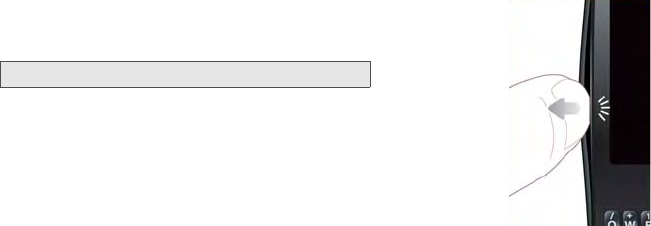
234 4A. Troubleshooting
I Need to Replace the Battery
Your Pixi phone comes with a replaceable battery. Be
sure to use a battery that is approved by Palm and
Sprint and that is compatible with your phone. Failure
to use the proper battery may result in personal injury
or product damage, and it voids your phone warranty.
1. If the USB cable is attached to the phone,
disconnect the USB cable.
2. If a wired headset is attached to the phone,
disconnect the headset.
3. To begin separating the back cover from the body
of the phone: Use your thumbnail to release the
clasp at the midpoint of the left side of the phone
(see a in step 4).
Note: Please dispose of the old battery properly.
Regulatory Submission (10.26.09). Palm, Inc. Confidential. Top Secret.
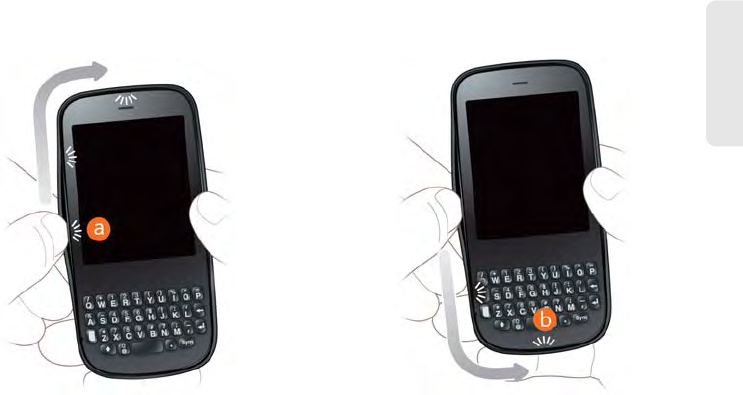
4A. Troubleshooting 235
Help
4. Run your thumbnail around the hairline opening to
release the upper-left and top clasps. (You may
hear a sound when the clasp releases.)
5. Run your thumbnail around the hairline opening to
release the bottom-left and bottom clasps. (End
at (b).)
Regulatory Submission (10.26.09). Palm, Inc. Confidential. Top Secret.
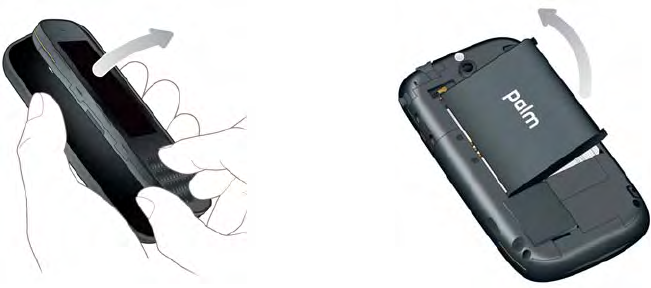
236 4A. Troubleshooting
6. Swing the body of the phone out of the back cover
as if the right side were a hinge. 7. Remove the battery by sliding your finger under
the groove at the side of the battery.
Regulatory Submission (10.26.09). Palm, Inc. Confidential. Top Secret.
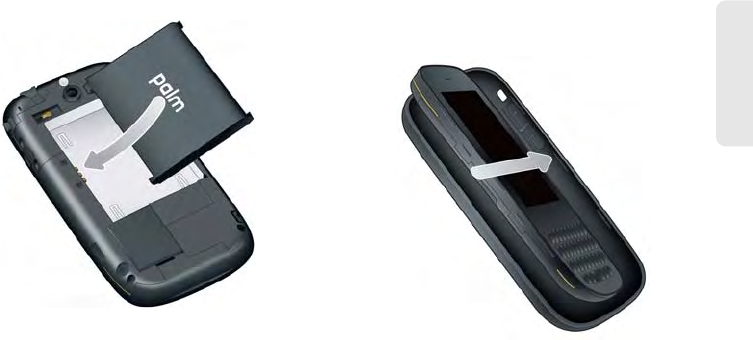
4A. Troubleshooting 237
Help
8. Insert the new battery.9. To replace the back cover: Insert the ringer switch
into the hole provided for it on the right side of the
back cover.
Regulatory Submission (10.26.09). Palm, Inc. Confidential. Top Secret.
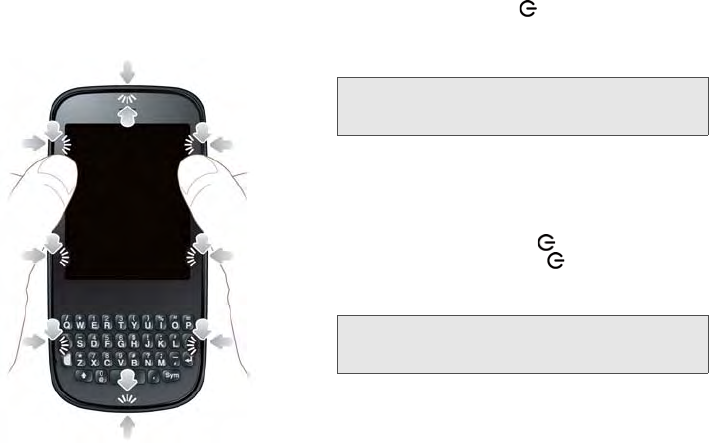
238 4A. Troubleshooting
10. Press the back cover and the body of the phone
together at each pair of clasps. (You can feel the
clasps engage.)
11. Press and hold power on the upper-left corner
of your phone until you see the Palm logo on the
screen (approximately five seconds). (Please be
patient while your phone starts up.)
I Can’t Get My Screen to Turn On After
Removing and Replacing the Battery
Removing the battery turns off your phone completely,
so you can’t just press power to turn on the screen.
Instead, press and hold power until you see the
Palm logo on the screen (approximately five seconds).
Please be patient while your phone starts up.
Tip: If your phone does not turn on after you insert the battery
and press and hold power, you need to charge the
battery (see “Charge the Battery” on page 31).
Tip: If your phone does not turn on after you press and hold
power, you need to charge the battery (see “Charge the
Battery” on page 31).
Regulatory Submission (10.26.09). Palm, Inc. Confidential. Top Secret.
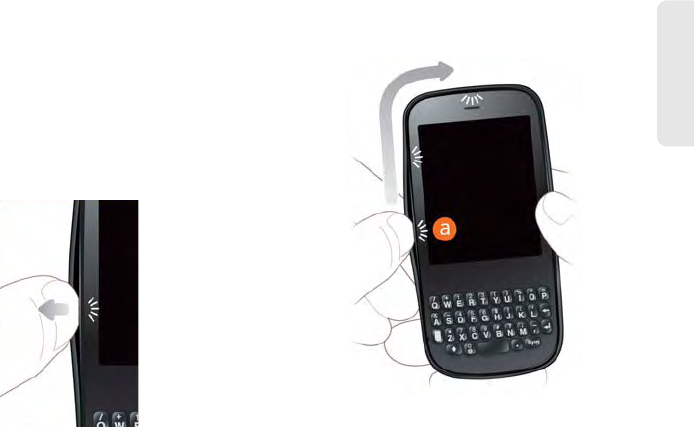
4A. Troubleshooting 239
Help
I Can’t Get the Back Cover Off
1. If the USB cable is attached to the phone,
disconnect the USB cable.
2. If a wired headset is attached to the phone,
disconnect the headset.
3. To begin separating the back cover from the body
of the phone: Use your thumbnail to release the
clasp at the midpoint of the left side of the phone
(see a in step 4).
4. Run your thumbnail around the hairline opening to
release the upper-left and top clasps. (You may
hear a sound when the clasp releases.)
Regulatory Submission (10.26.09). Palm, Inc. Confidential. Top Secret.
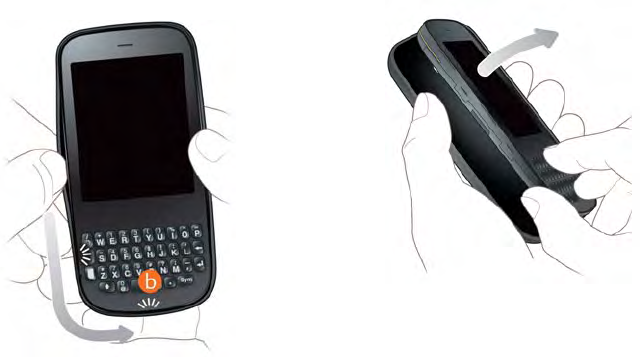
240 4A. Troubleshooting
5. Run your thumbnail around the hairline opening to
release the bottom-left and bottom clasps. (End at
(b).)
6. Swing the body of the phone out of the back cover
as if the right side were a hinge.
Regulatory Submission (10.26.09). Palm, Inc. Confidential. Top Secret.
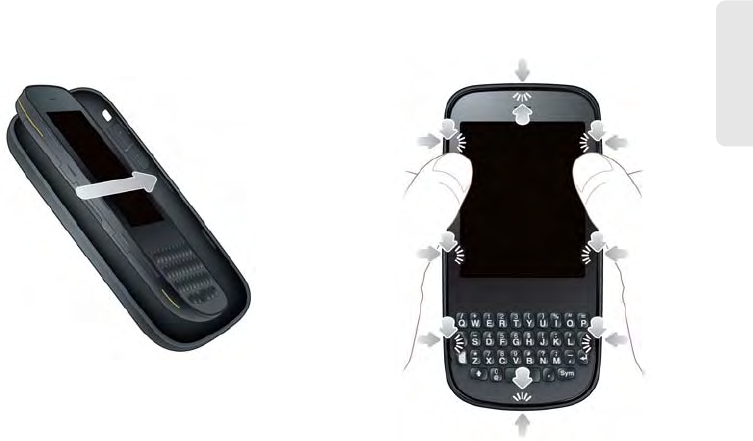
4A. Troubleshooting 241
Help
I Can’t Get the Back Cover Back On
1. Insert the ringer switch into the hole provided for it
on the right side of the back cover.
2. Press the back cover and the body of the phone
together at each pair of clasps. (You can feel the
clasps engage.)
Regulatory Submission (10.26.09). Palm, Inc. Confidential. Top Secret.
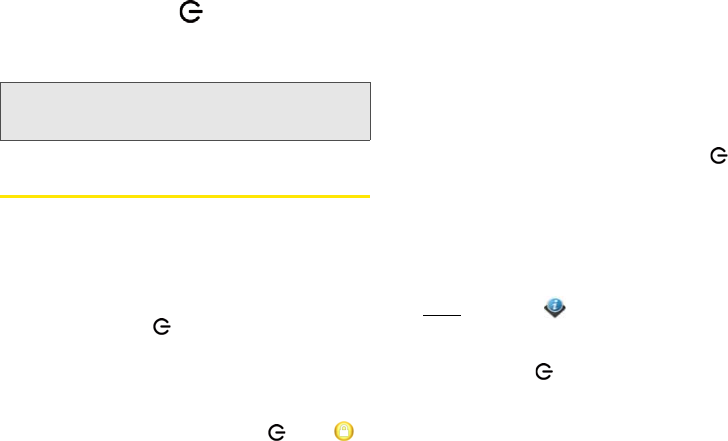
242 4A. Troubleshooting
3. Press and hold power on the upper-left corner
of your phone until you see the Palm logo on the
screen (approximately five seconds). (Please be
patient while your phone starts up.)
Screen and Performance
The Screen Appears Blank
To save power, the screen dims automatically after a
period of inactivity, and then turns off.
If you just inserted or replaced the battery, you need to
press and hold power until you see the Palm logo
on the screen. Otherwise, follow these steps in
sequence if you see a blank screen:
1. To brighten the screen if it has dimmed, tap the
screen.
2. To turn on the screen, press power . Drag
up to unlock the screen
3. Look closely at the screen. (If you can see a dim
image, try adjusting the screen brightness (see
“Change Screen Brightness” on page 175).)
4. If the problem persists, connect your phone to the
AC charger (see “Charge the Battery” on page 31).
(If you see a dim image, try to restart your phone
(see “Restart Your phone” on page 171).)
5. If that doesn’t work, press and hold power and
slide the ringer switch three times to restart your
phone. (Please be patient while your phone starts
up.)
An Application Is Not Responding to Taps
Try the following steps in sequence:
1. Open Device Info and restart your phone (see
“Restart Your phone” on page 171).
2. If the screen does not respond to taps at all, press
and hold power and slide the ringer switch
three times to restart your phone. (Please be
patient while your phone starts up.)
Tip: If your phone does not turn on after you insert the battery
and press and hold power, you need to charge the
battery (see “Charge the Battery” on page 31).
Regulatory Submission (10.26.09). Palm, Inc. Confidential. Top Secret.

4A. Troubleshooting 243
Help
Applications Are Running Slower Than
Usual
1. Tap the center of the gesture area to display Card
view.
2. Scroll through the cards and note how many
applications you have running.
3. Close any application you are not using by
throwing its card off the top of the screen.
If the problem persists, try restarting your phone (see
“Restart Your phone” on page 171).
My Gestures in the Gesture Area Aren’t
Working
ⅷSome gestures begin in the gesture area and end in
the touchscreen, and vice versa. Crossing the border
between the two areas with your finger is crucial to
making the gesture successfully. Likewise, the drag
gesture for opening a menu begins at the top of the
phone, above the screen, and crosses down onto the
screen.
ⅷIf you cannot make the back gesture, check to see if
you have the next/previous app gestures turned on
(see “Turn Advanced Gestures On/Off” on page 176).
If so, you need to make a short swipe left for the back
gesture, and a full swipe right or left for the next or
previous open app.
ⅷLikewise, you can’t use the next/previous app
gestures unless you turn them on (see “Turn
Advanced Gestures On/Off” on page 176).
You can see animations of many gestures: Open
Help and tap Clips. Or go to palm.com/support to
watch the animations on your desktop computer.
Also, see “Use Gestures: Tap, Swipe, Drag, Flick,
Pinch” on page 35.
Tip: Be sure that any third-party applications you install are
compatible with the Palm® webOS™ platform.
Applications written for Palm smartphones using the
Palm OS operating system or Windows Mobile are not
compatible with your Pixi phone. If you can try a free
version of the software before purchasing it, you can test it
first to make sure it works properly. In App Catalog, you
can purchase the Classic application from MotionApps to
run Palm OS applications on your Pixi phone.
Regulatory Submission (10.26.09). Palm, Inc. Confidential. Top Secret.

244 4A. Troubleshooting
There Are Small Icons in the Lower-Right
Corner of the Screen
Those icons represent notifications that you have not
opened or dismissed. For most types of notifications, if
you do not tap a notification after a few seconds, it
becomes an icon in the lower-right portion of the
screen. If you see one or more icons, tap anywhere on
the bottom of the screen to display your notifications.
Phone
Signal Strength Is Weak
Become familiar with low coverage areas where you
live, commute, work, and play. Then you know when to
expect signal-strength issues.
ⅷIf you’re standing, move about 3 meters in any
direction.
ⅷIn a building, move near a window. Open any metal
blinds.
ⅷIn a building, move outdoors or to a more open area.
ⅷOutdoors, move away from large buildings, trees, or
electrical wires.
ⅷIn a vehicle, move your phone so that it’s level with a
window.
My Phone Won’t Connect to the Mobile
Network
ⅷTry the suggestions in the preceding section for
weak signals.
ⅷTurn off your phone and turn it on again (see “Turn
the Phone On/Off” on page 18).
ⅷRestart your phone (see “Restart Your phone” on
page 171).
I See Five Bars in the Signal-Strength Icon,
but I Still Can’t Connect to the Network
The signal-strength icon always displays five bars.
Your signal strength is indicated by the number of bars
that are shaded white. If most or all of the bars are gray,
you are in an area of weak or no coverage.
Regulatory Submission (10.26.09). Palm, Inc. Confidential. Top Secret.

4A. Troubleshooting 245
Help
The Other Person Hears an Echo
ⅷTry decreasing the volume on your phone—whether
you are using the speakerphone or the earpiece—to
avoid coupling or feedback on the other person’s
end.
ⅷPosition the earpiece closer to your ear to prevent
sound leaking back into the microphone.
ⅷIf you’re using the speakerphone feature with your
phone lying on a flat surface, try turning the phone
face down (screen facing the surface).
I Hear My Own Voice Echo
Ask the person on the other end of the call to turn
down the volume on his or her phone or to hold the
phone closer to his or her ear.
My Voice Is Too Quiet on the Other End
ⅷBe sure to position the microphone, which is on the
lower-left side of the keyboard next to the Option
key, close to your mouth. Make sure you are not
covering the microphone with your cheek or chin.
ⅷCheck the signal-strength icon. If the signal is
weak, try to find an area with better coverage (see
“Signal Strength Is Weak” on page 244).
I Hear Static or Interference
Check the signal-strength icon. If the signal is weak,
try to find an area with better coverage (see “Signal
Strength Is Weak” on page 244).
If you’re using a hands-free device enabled with
Bluetooth® wireless technology, try the following:
ⅷMove your phone closer to the hands-free device.
Audio quality degrades as the distance between
your phone and the hands-free device increases.
The effective range for a hands-free device varies
among manufacturers.
ⅷConfirm that no obstructions, including your body,
are between the phone and your hands-free device.
For example, move your phone to the same side of
your body as your hands-free device.
Regulatory Submission (10.26.09). Palm, Inc. Confidential. Top Secret.

246 4A. Troubleshooting
My Phone Seems to Turn Off by Itself
Your phone has a power-saving feature that’s set to
turn off the screen if it has been idle for one minute.
You can change the auto-shut off interval (see “Set the
Interval for Turning the Screen Off Automatically” on
page 175).
If you restart your phone, any wireless services are
automatically turned on if they were on before the
restart. However, if the phone can’t determine if a
wireless service was on before the restart, that service
does not automatically turn on (see “Turn the Phone
On/Off” on page 18).
If the problem persists and you’re using third-party
applications, see “Third-Party Applications” on
page 261 for additional suggestions.
Hands-Free Devices
I Can’t Make or Receive Calls Using a
Bluetooth® Hands-Free Device
Verify all of the following:
ⅷThe Bluetooth feature is turned on (see “Turn the
Bluetooth Feature On/Off” on page 226).
ⅷYour Bluetooth hands-free device is charged and
turned on.
ⅷYou have already formed a partnership between your
phone and your hands-free device, and the
hands-free device appears in the Devices list (see
“Connect With a Paired Device” on page 228).
ⅷYour phone is within range of the hands-free device.
Bluetooth range is up to 10 meters in optimum
environmental conditions, which include the absence
of obstacles, radio interference from nearby
electronic equipment, and other factors.
ⅷYou are away from other devices using the 2.4GHz
radio frequency, such as cordless phones and
Regulatory Submission (10.26.09). Palm, Inc. Confidential. Top Secret.

4A. Troubleshooting 247
Help
microwaves. If this is impossible, move the phone
closer to the hands-free device.
ⅷThe hands-free device is compatible with your
phone. Go to palm.com/support to see a list of
supported devices.
I Lost the Connection Between My Phone
and My Bluetooth Headset
If your headset isn’t working, delete the existing
partnership (see “Delete a Device” on page 229) and
create a new one (see “Set Up and Use a Bluetooth®
Hands-Free Device” on page 96).
I Hear Static or Interference When Using
My Hands-Free Device
ⅷTry moving your phone closer to the hands-free
device. Audio quality degrades as the distance
between your phone and the hands-free device
increases. The effective range for a hands-free
device varies among manufacturers.
ⅷConfirm that no obstructions, including your body,
are between the phone and your hands-free device.
ⅷMove to a quieter location to reduce environmental
noise.
Some Features of My Hands-Free Device
Don’t Work With My Phone
ⅷCheck the compatibility list at palm.com/support to
ensure that your device is compatible with your Pixi
phone.
ⅷNot all hands-free features work with every
hands-free device. Check the documentation that
came with your hands-free device or the
manufacturer’s website for feature-compatibility
information specific to your device.
Synchronization
What Is Synchronization?
Anytime you are in Email, Calendar, or Contacts, you
can set up a relationship to wirelessly sync data with
selected service providers—for example, Google or
Microsoft Exchange ActiveSync® (EAS—check to see if
Regulatory Submission (10.26.09). Palm, Inc. Confidential. Top Secret.
248 4A. Troubleshooting
your company supports this). Sync means that if you
enter, change, or delete information in one location, the
change automatically shows up in the other location.
So if you enter a Google contact in the Contacts
application on your phone, the contact appears in your
online Google contacts—no need to enter it twice.
You must already have an account with a service
provider before you can set it up on your phone.
How Do I Set Up Synchronization With an
Online Account?
The first time you open Email, Contacts, or Calendar,
you are given the option to enter settings for one or
more online accounts (see “Set Up Email” on
page 187, “Use Contacts for the First Time” on
page 123, or “Use Calendar for the First Time” on
page 137). For any account, you need to enter the
settings in only one of these applications to
synchronize data for all three.
You can add additional accounts at any time using the
preferences in any of these applications (see “Set
Email Preferences” on page 200, “Customize Contacts”
on page 133, or “Customize Calendar” on page 143).
You can also set up the Messaging application to work
with an online instant messaging (IM) account (see
“Set Up an Instant Messaging (IM) Account” on
page 209), and the Photos application to work with an
online pictures account such as Facebook or
Photobucket (see “Set Up an Online Pictures Account
on Your Phone” on page 107).
See “Online Accounts Available for webOS Phones” on
page 294 for the current list of online accounts that
synchronize your info and those that do a one-way
transfer of info either from the Web to your phone, or
from your phone to the Web.
I Don’t Want to Sync Calendar or Contact
Information With My Online Account—Just
Email
If you do not want to sync a Google application with an
online account, you can remove that account from
within the application. The online account continues to
sync with any other related Google applications.
Regulatory Submission (10.26.09). Palm, Inc. Confidential. Top Secret.

4A. Troubleshooting 249
Help
1. Open the application.
2. Open the application menu and tap Preferences &
Accounts.
3. Tap the account name.
4. Tap Remove Account, and then tap Remove [app
name] Account.
I Want to Sync With Outlook or Palm
Desktop Software on My Computer
By default, your Pixi phone does not support
synchronization with Palm Desktop software or Outlook
on your desktop computer. Your Pixi phone, however,
gives you options for synchronization without a cable.
You can sync with online services that Palm has
partnered with so that you can store and sync your info
in online accounts. You can access your data even
when you are not able to make a connection to the
Web, because your data is cached on your phone.
If you have data from a Palm smartphone in Outlook or
Palm Desktop software, you can do a one-time,
one-way export of the data from the desktop
application to your phone (see “How Do I Get Data Off
My Computer?” on page 77). You can assign this data
to sync with an online account. You can also assign it
to the Palm profile account. Data in this account is
backed up to your Palm profile daily, so you can
retrieve it if you need to reset your phone. But it is not a
true sync because you cannot change your Palm
profile data anywhere except on your phone.
If your desktop Outlook synchronizes with an Exchange
server using Microsoft Exchange ActiveSync, you
cannot do a one-way export of that Outlook data to
your phone. However, you can synchronize the Outlook
data wirelessly with your phone through your Exchange
account.
Important: You cannot remove individual Exchange account
applications. If you remove your Exchange account
from one application, sync stops with all your
Exchange apps.
Tip: A number of third-party applications (sold separately) are
available that let you synchronize data on your Pixi phone
with a desktop application. Visit palm.com/migrate-pixi to
learn more.
Regulatory Submission (10.26.09). Palm, Inc. Confidential. Top Secret.
250 4A. Troubleshooting
I Have an Exchange ActiveSync Account
at Work, but My Data Is Not Being
Downloaded to My Phone
Check with your system administrator to obtain or verify
the name of the mail server that offers you wireless
access to the corporate mail system. If you cannot
obtain the name of this server (some companies do
not give it out because they do not want wireless
access to their servers), you cannot synchronize with
your Exchange ActiveSync account.
If your company requires you to change your password
for accessing your Exchange ActiveSync account, you
must change the password on your phone (see
“Change Account Login Settings” on page 192).
I Entered the Settings to Sync With
Exchange ActiveSync, but I Can’t
Synchronize With My Company’s
Exchange Server
Check with your system administrator to find out if a
systemwide locking policy is in place.
A Notification Tells Me That ActiveSync
Encountered a Problem on the Server
There is a temporary problem with the server, or the
server may be temporarily overloaded. Try again later,
and if the problem persists, contact your system
administrator.
A Notification Tells Me That There Is Not
Enough Free Memory to Synchronize
1. Tap the center of the gesture area to display Card
view.
2. Scroll through the cards and note how many
applications you have running.
3. Close any application you are not using by
throwing its card off the top of the screen.
If the previous steps don’t fix the problem, see “Making
Room on Your Phone” on page 262 for other
suggestions.
Regulatory Submission (10.26.09). Palm, Inc. Confidential. Top Secret.

4A. Troubleshooting 251
Help
A Notification Tells Me That the Server
Could Not Be Reached
Make sure your phone is connected to the Sprint
network (see “Icons in the Title Bar” on page 29).
If you have a network connection and receive this
notification, it means your phone had to wait too long to
connect to the Exchange server. The connection may
have been lost, the server may be temporarily
overloaded, or the server may have encountered an
internal error. Check your Exchange server name and
proxy server settings (see “Set Up Email: Microsoft
Exchange ActiveSync (EAS)” on page 188), and try
again later.
A Notification Tells Me That ActiveSync
Encountered a Problem With [item Type]
[item Name]
There was an error while synchronizing a single item.
This error can usually be corrected only by deleting the
item that caused the error. If you sync again to see if
the error persists, be aware that items causing this type
of error are skipped and do not show up again.
Sending and Receiving Data in
Email, Messaging, and Web
I Can’t Tell If Data Services Are Available
The following icons appear in the title bar to indicate
whether data services are available. If you don’t see
one of these icons, you cannot open a data
connection:
Key Term: 1xRTT (single-carrier [1x] radio transmission
technology): A wireless technology that can
provide fast data transfer and Internet access, with
average speeds of 60-to-80Kbps and bursts of up
to 144Kbps.
Key Term: EvDO (Evolution Data Optimized): A wireless
broadband technology that is designed for very
high-speed data transfer, with average download
speeds of 400-to-600Kbps, and capable of
reaching speeds up to 3.2Mbps and upload
speeds up to 1.8Mbps.
Regulatory Submission (10.26.09). Palm, Inc. Confidential. Top Secret.

252 4A. Troubleshooting
Email
I Have Problems Using My Account
Occasionally you may experience problems using an
email account after you set it up. If you followed the
account setup procedure (see “Set Up Email” on
page 187) and are experiencing problems using the
account, verify that the account complies with your
email provider’s requirements:
ⅷVerify both your password and your username for
your email account.
ⅷIf you changed your password in an online email
account, you must change the password on your
phone (see “Change Account Login Settings” on
page 192).
ⅷSome wireless service providers have other
requirements specific to their service. Check with
Sprint to find out whether any provider-specific
requirements exist.
ⅷMake sure your ISP or email provider allows you to
access email on a phone. (Some providers do not
offer this option at all; other providers require an
upgrade for you to access email on a phone.).
ⅷEmail provider settings may change. If your email
account was working but you are currently
experiencing problems, check with your email
provider to find out whether any of the account
settings have changed.
Your phone is connected to a 1x data network.
Data is not currently being transmitted over the
network.
Your phone is connected to a 1x data network
and data is being transmitted over the network.
Your phone is connected to an EvDO data
network. Data is not currently being transmitted
over the network.
Your phone is connected to an EvDO data
network and data is being transmitted over the
network.
Regulatory Submission (10.26.09). Palm, Inc. Confidential. Top Secret.

4A. Troubleshooting 253
Help
I Have Problems Sending and Receiving
Email
ⅷMake sure your phone is on and that your data
connection to your mail server or email service
provider has not been interrupted (see “Turn the
Phone On/Off” on page 18).
ⅷShort periods of time when email is unavailable are
common, due to server problems or poor wireless
coverage. If you have problems sending or receiving
mail for an extended period of time, check with your
ISP or email service provider to verify that the service
is working properly, and check with Sprint for outage
information in your area.
I Have Problems Sending Email (IMAP and
POP Accounts)
If you are able to receive email messages but cannot
send them, try the following:
ⅷTurn on authentication (see “Set Up Email: Other
Providers” on page 190). Many service providers
require authenticated access, or ESMTP, to use their
SMTP servers for outgoing mail.
ⅷEnter the name of a different outgoing mail server for
sending mail (see “Set Up Email: Other Providers” on
page 190). Many ISPs, such as cable companies,
require that you have an Internet connection to their
network to send email through their servers. In this
case, you can almost always receive email from
these accounts, but if you want to send email, you
must send it through another server. Check with your
email service provider for the correct outgoing mail
server name.
After I Receive Messages, Older
Messages Disappear From My Inbox
When email sync takes place, the last three days’ worth
of email messages is downloaded from your mail
server to your Inbox. All messages older than three
days are removed from your Inbox; they are not deleted
on the server, however.
You can change the setting to download only one or
two days’ worth of messages. If you select one of these
options, any messages older than one or two days are
deleted from your Inbox. You can also change the
setting to download all messages regardless of the
Regulatory Submission (10.26.09). Palm, Inc. Confidential. Top Secret.

254 4A. Troubleshooting
date, in which case all messages continue to appear in
your Inbox (see “Enter Advanced Account Settings” on
page 191).
Messaging
I Can’t Send or Receive Text or Multimedia
Messages
ⅷMake sure that your phone is on (see “Turn the
Phone On/Off” on page 18).
ⅷFor multimedia messages, do the following:.
ⅢContact Sprint to verify that messaging services
have been correctly activated on your phone, and
that they are available at your location. (Sprint
should be able to tell you if messaging services
have been experiencing transmission delays.).
ⅢCheck to see if you have data services enabled.
Open Phone , open the application menu,
and tap Preferences. Under Network, make sure
Data Usage is set to On.
ⅢIf you are in roaming coverage, check to see if
you have data roaming enabled. Open
Phone , open the application menu, and tap
Preferences. Under Network, tap Data Roaming
and tap Enabled.
ⅷIf possible, contact the recipient of the message, and
make sure the receiving device can handle the type
of message you’re sending.
ⅷIf a message arrives but does not display a
notification, restart your phone (see “Restart Your
phone” on page 171).
I Want to Send a Video in a Multimedia
Message, but Do Not See It on the List of
Items I Can Attach
You can attach only pictures in JPG format to outgoing
multimedia messages. To send files of other types,
attach them to an email message (see “Add
Attachments to a Message” on page 194).
Regulatory Submission (10.26.09). Palm, Inc. Confidential. Top Secret.
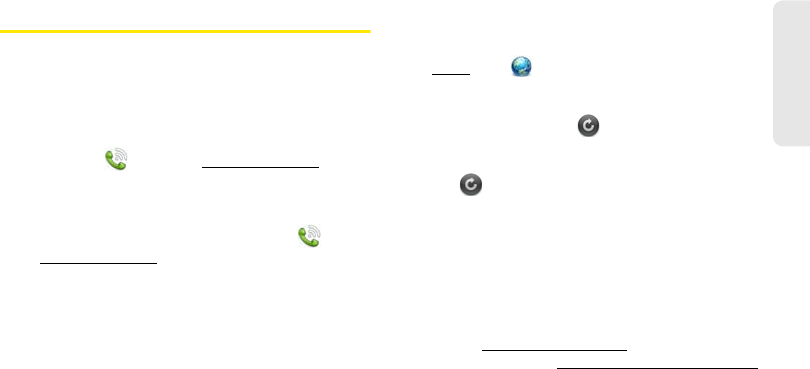
4A. Troubleshooting 255
Help
Web
My Phone Won’t Connect to the Internet
Your phone supports EvDO and 1xRTT wireless data
networks.
ⅷCheck to see if you have data services enabled.
Open Phone , open the application menu, and
tap Preferences. Under Network, make sure Data
Usage is set to On.
ⅷIf you are in roaming coverage, check to see if you
have data roaming enabled. Open Phone , open
the application menu, and tap Preferences. Under
Network, tap Data Roaming and tap Enabled.
ⅷTurn off your phone and turn it on again (see “Turn
the Phone On/Off” on page 18).
ⅷRestart your phone (see “Restart Your phone” on
page 171).
ⅷContact Sprint to verify that your subscription plan
has been correctly activated. Sprint should also be
able to tell you if there are any outages in your
location.
I Can’t Access a Page
1. Make sure you have Internet access:
ⅢOpen Web and try to view a Web page
you’ve loaded before.
ⅢTo ensure that you’re viewing the page directly
from the Internet, tap .
ⅢAfter confirming your Internet connection, try to
view the page again. If it comes up blank,
tap .
ⅢIf you’re still having trouble, the page may contain
elements that are not supported by the browser,
such as Flash, Shockwave, VBScript, WML script,
and other plug-ins.
2. Some websites redirect simple Web addresses
given to the public to actual Web addresses that
are more complex (for example, if you enter the
address www.palm.com/support, it may actually go
to the Web address http://www.palm.com/us/support.
(If your phone’s browser can’t follow the redirect,
enter the Web address in a desktop browser and
read the actual Web address in the address bar.
Then enter the actual address in your phone’s
browser.)
Regulatory Submission (10.26.09). Palm, Inc. Confidential. Top Secret.

256 4A. Troubleshooting
An Image or Map Is Too Small on My
Screen
Do either of the following:
ⅷTo switch to landscape mode to see more of the
image, turn the phone on its side.
ⅷTo zoom in on the image, pinch out or double-tap
the screen.
A Secure Site Refuses to Permit a
Transaction
Some websites don’t support certain browsers for
transactions. Contact the site’s webmaster to make
sure the site allows transactions using your phone’s
Web browser.
Calendar and Contacts
I Haven’t Entered Any Contacts or
Calendar Events on my Phone, but When I
Open Those Apps, I See Entries
The entries you see displayed in Calendar or Contacts
have been downloaded to your phone from one of your
online accounts such as Google or Microsoft
Exchange ActiveSync. Anytime you are in Email,
Calendar, or Contacts, you can set up a relationship to
wirelessly sync data with one of these accounts. And
after you enter the account settings in just one of these
apps, any information you have online is automatically
downloaded to all three—so if you set up a Gmail
account in Email but also have a Google calendar, your
phone’s calendar automatically displays events entered
in your Google calendar.
You can remove an online account from an application
so that that app no longer syncs with that account (see
“Stop Synchronization of Contacts With an Online
Account” on page 134, “Stop Synchronization of
Regulatory Submission (10.26.09). Palm, Inc. Confidential. Top Secret.

4A. Troubleshooting 257
Help
Calendar With an Online Account” on page 145, or
“Delete an Email Account” on page 192).
My Personal and Work Contact and
Calendar Information Is Getting Merged
Into a Single View—I’d Rather Keep Them
Separate
The Palm® Synergy™ feature on your phone displays
information from several sources in a single view, so
you can access your info quickly, without having to
remember where you stored it. But though the
information is visible in one view, the sources of that
information are kept separate.
In Calendar, to see events from just one calendar, tap
the word All in the upper-right corner of the screen and
pick the account you want to see. See “Change the
Calendar Display” on page 140.
In Contacts, the list view shows all contacts from all
accounts. You can, however, see what data comes
from which account by opening the contact and
tapping Edit. If you want to unlink contacts, see “Unlink
a Contact” on page 131.
In Email, you can turn off the smart folder for All
Inboxes (see “Set Email Preferences” on page 200).
Then make the inboxes of your individual accounts
favorites so that they're always easy to see in Account
List view (see “Add a Folder as a Favorite” on
page 200).
I Started Entering a Contact’s Name in
Universal Search, but I’m Not Seeing the
Person in the Results
ⅷYou need to enter at least two letters in universal
search before contact matches are returned.
ⅷIf the contact is a linked contact, universal search
searches on the primary profile only. Scroll through
the contact match results to make sure that universal
search did not return a different match for your
contact from the one you were expecting.
For example, suppose you’re searching for your
friend Ed Smith’s contact info. You have three
contact entries for Ed that are linked, and the
primary entry happens to be the one listed by Ed’s
screen name, ScubaEd. Typing es is not going to
find Ed’s contact; you have to type scu. To correct
Regulatory Submission (10.26.09). Palm, Inc. Confidential. Top Secret.

258 4A. Troubleshooting
this, make the contact listing Ed’s real name the
primary contact (see “Link a Contact” on
page 130).
Camera
Here are some tips for taking good pictures with the
camera:
ⅷClean the camera’s lens with a soft, lint-free cloth.
ⅷTake pictures in bright lighting conditions. Low-light
images may be grainy, due to the sensitivity of the
camera.
ⅷHold the phone as still as possible. Try supporting
your picture-taking arm up against your body or a
stationary object (such as a wall).
ⅷKeep the subject of the pictures still. Exposure time is
longer with lower light levels, so you may see a blur.
ⅷFor best results, verify that you have the brightest light
source coming from behind you, lighting the
subject’s face. Avoid taking indoor pictures with the
subject in front of a window or light. If the light is
behind the subject, try moving closer to the subject
and enabling the flash.
ⅷMake sure the subject is at least 0.5 meter away from
the camera to ensure good focus.
Amazon MP3
I Bought a Song From Amazon MP3, but It
Isn’t Showing Up on My Phone
Occasionally, the download process may be
interrupted, so a song you purchased may not be
successfully downloaded to your phone. To confirm the
purchase and download of a song, log in to your
Amazon account from your computer. If the song
shows up there as purchased and downloaded,
contact Amazon support and let them know you never
received your song.
Regulatory Submission (10.26.09). Palm, Inc. Confidential. Top Secret.

4A. Troubleshooting 259
Help
Transferring Information From Your
Computer
I Bought a Song Through Amazon MP3
and Want to Transfer It to My Computer
You can copy music files on your phone to your
computer for use with a desktop music player. For
instructions, see “Copy Files Between Your Phone and
Your Computer” on page 73.
I Copied Files From My Computer, but I
Can’t See or Play Them on My Phone
When you connect your phone to your computer in
USB Drive mode, you can copy any file onto your
phone. However, each media application on your
phone—Photos, Music, and Videos—can display or play
files in certain file formats only. If your media file is in an
unsupported format, you can’t use it on your phone.
For a list of supported photo types, see “Photos” on
page 102. For a list of supported music file types, see
“Music” on page 113. For a list of supported video file
types, see “Videos” on page 108.
When I Open the Palm Pixi Drive Folder on
My Computer, I see Subfolders. Do I Need
to Move My Files Into These Folders?
The default folders are there to help you organize files
you copy to and from your computer. But you can copy
files from your computer into any folder you want—you
can create your own folders, or just drag your files to
the top level of the drive. As long as the file is in a
supported format, your phone can detect and open it.
Note: If you move a music file into the ringtones folder, the
Music application cannot find it.
Regulatory Submission (10.26.09). Palm, Inc. Confidential. Top Secret.

260 4A. Troubleshooting
Backing Up and Restoring Data
I Need to Reset My Phone but Don’t
Understand the Difference Between a
Partial Erase and a Full Erase
Both a partial erase and a full erase delete all personal
information, such as events, contacts, and tasks, as well
as applications you have added, such as third-party
software, on your phone. In addition, a full erase
deletes all files stored in the USB Drive of your phone,
which includes all pictures, videos, music files,
documents, PDF files, and ringtones.
For more information, see “Erase Data and Reset Your
Phone” on page 171.
How Do I Get My Data Back After a Full or
Partial Erase?
After a full or a partial erase, on your phone, enter your
existing Palm profile email address, and password—
don’t create a new one! When you do this, all data that
has been backed up to your profile—contacts, calendar
events, and tasks, as well as apps you bought through
App Catalog—is restored to your phone. Information
about your online accounts is also restored to your
phone, so those online accounts are set up again
automatically on your phone and synchronization
begins again as well.
A full erase deletes everything deleted by a partial
erase, plus everything you stored in your phone's USB
Drive (photos, videos, music, documents, PDF files,
ringtones, and so on). You need to have copies of
those files available elsewhere if you want to restore
them to your phone. For example, you can save copies
on your computer and then transfer them back to your
phone (see “Copy Files Between Your Phone and Your
Computer” on page 73).
Regulatory Submission (10.26.09). Palm, Inc. Confidential. Top Secret.

4A. Troubleshooting 261
Help
Updates
I Dismissed a System Update Notification,
and Now I Don’t Know How to Get the
Update on My Phone
If you have a phone network connection and the
battery has at least a 30% charge, you can start the
update yourself: Open Updates . Your phone
checks for the availability of the update, and if one is
available, tap Download Now. The download happens
in the background, so you can continue to use your
phone until the actual installation takes over.
After the update has finished being downloaded, tap
Install Now to install the update on your phone.
My Phone Froze While I Was Downloading
or Installing a System Update
During a wireless software update, there’s a small
chance that your phone may freeze and stop
responding to taps or key presses. If this happens, you
can use webOS DoctorTM to restore your phone and
install the system update from your computer using the
USB cable. On your computer, go to palm.com/support
to download webOS Doctor.
Third-Party Applications
Some third-party applications may cause conflicts with
your phone. Third-party applications that modify the
wireless features of your phone may require extra
troubleshooting. Use caution when installing the
following:
ⅷRingtone managers.
ⅷCaller ID applications.
ⅷInstant messaging.
ⅷApplications that modify when your phone or data
connections turn on or off and how your phone
behaves.
Regulatory Submission (10.26.09). Palm, Inc. Confidential. Top Secret.

262 4A. Troubleshooting
If you recently installed an application and your phone
seems to be stuck, try the following in sequence until
the problem is resolved:
1. Restart your phone (see “Restart Your phone” on
page 171).
2. Make sure your third-party applications are up to
date (see “Manually Check for Updates” on
page 67).
3. See if a system update is available (see “Manually
Check for Updates” on page 67).
4. Delete the most recently installed application, or
the application you think could be causing the
problem, from your phone (see “Delete an
Application” on page 52). (Perform a backup (see
“Back Up Your Information” on page 164).)
5. Perform a partial erase (see “Erase Data and Reset
Your Phone” on page 171).
6. Enter your Palm profile email address and
password to restore your backed-up information.
7. If the problem is resolved, begin reinstalling your
third-party applications one at a time.
8. If the problem recurs, delete the last application
you installed and report the problem to its
developer.
Getting More Help
Contact the author or vendor of any third-party software
if you require further assistance. Neither Palm nor
Sprint provides technical support for applications that
are not built into your phone.
Making Room on Your Phone
If you store a large number of files, or install many
third-party applications, the internal memory on your
phone may fill up. Here are some ways to clear space
on your phone:
ⅷPhotos, Videos, Music, Amazon MP3, Doc View, PDF
View: Large media files take up a lot of memory.
Move files to your computer (see “Copy Files
Between Your Phone and Your Computer” on
page 73), or delete them from your phone.
Regulatory Submission (10.26.09). Palm, Inc. Confidential. Top Secret.

4A. Troubleshooting 263
Help
ⅷEmail: Email attachments can be large and consume
lots of memory. Copy attachments to your computer
(see “Copy Files Between Your Phone and Your
Computer” on page 73), or delete large files from
your phone (see “Delete a Message” on page 198).
You can also empty the deleted items folder.
ⅷWeb: Delete stored Web browsing information by
clearing your history, cookies, and cache
(see “Customize Web Browser Settings” on
page 221).
ⅷThird-party applications: You can delete infrequently
used applications (see “Delete an Application” on
page 52).
Regulatory Submission (10.26.09). Palm, Inc. Confidential. Top Secret.

264 4B. Glossary
4B. Glossary
airplane mode: A mode in which all the wireless
services on your phone are turned off. Wireless
services include the phone used for making and
receiving calls, and Bluetooth® wireless technology.
See “Turn Wireless Services Off (Airplane Mode)” on
page 19.
application menu: A menu that contains application
commands such as cut, copy, and paste (where
available); preferences; and application help. To open
the application menu, tap the application name in the
upper-left corner of the screen. See also “connection
menu” on page 265.
application search: The feature that lets you search
for entries within an application by typing a search term
when the list view is displayed—for example, a contact
name or phone number, the subject text of an email
message, or a few words from a memo. See also
“universal search” on page 268.
application update: An update from the developer of
an application you bought through App Catalog on
your phone. When an application update is available, a
notification appears on your phone. You can also
check for application updates manually. Additional fees
may apply. See “Update the Software on Your Phone”
on page 65.
back: The gesture you use to move up one level from
a detailed view to a more general view of the
application you’re working in. For example, when you
finish reading an email message, make the back
gesture to close the message and return to your list of
messages. Or when you finish writing a memo, make
the back gesture to close and save the memo and
return to the display of all your memos. See “Go Up
One Level in an App (Back Gesture)” on page 48.
Making the back gesture is also the way you save your
work in many apps. If you don't see a Done button,
make the back gesture to save your work.
card: A minimized view of an open application. You
can easily move among and reorder cards in Card
view. Tap a card to restore the full-screen view of the
application and continue working in it. See also “Card
view” on page 265.
Regulatory Submission (10.26.09). Palm, Inc. Confidential. Top Secret.

4B. Glossary 265
Glossary
Card view: The view on your phone that displays
applications as minimized cards, allowing you to easily
move among and reorder them. Don’t confuse Card
view with the “Launcher” on page 265, which along
with “Quick Launch” on page 267, shows you all the
apps you have on your phone, not just the open ones.
To display Card view from any open application
window, flick up from the gesture area to the screen, or
tap the center of the gesture area. Card view displays
your wallpaper.
connection menu: A menu that lets you turn on or off
connection features including Bluetooth® wireless
technology, and all wireless services (airplane mode).
To open the connection menu, tap the upper-right
corner of the screen. See also “application menu” on
page 264.
dashboard: A list of all your notifications. When one or
more notification icons appear at the bottom of the
screen, tap the icons to open the dashboard. Tap a
dashboard item to act on it. See also “notification” on
page 266.
Data Transfer Assistant: A tool that allows you to do a
one-way transfer of information such as contacts and
calendar events from a desktop organizer to your
phone. See “Transferring Data” on page 76.
drag: A slow movement of the finger up or down on
the touchscreen.
flick: A very fast skimming of the finger horizontally or
vertically on the touchscreen.
gesture area: The strip beneath the touchscreen that
you use to perform the back gesture, among others.
Some gestures you begin in the gesture area and
complete on the touchscreen, for example, the slow
drag that displays “Quick Launch” on page 267 when
you have an application filling the screen.
Launcher: A group of screens displaying all your
applications. To open the Launcher, tap in “Quick
Launch” on page 267, or flick up twice from the gesture
area to the screen. If you are in Card view, flick up once
from the gesture area to the screen to open the
Launcher. In the Launcher, swipe up, down, left, and
right to see all your apps. Tap an app icon to open it.
linked contact: A contact containing information from
more than one source. For example, if you have you
have a work contact in Exchange ActiveSync and a
personal contact for the same person in Google, the
Regulatory Submission (10.26.09). Palm, Inc. Confidential. Top Secret.

266 4B. Glossary
Contacts application automatically recognizes the
connection and links the two contacts so that you can
see all the information in one place—but the
information is kept separate in the different accounts
where it originated. You can also manually link and
unlink contacts.
merged view: A feature on your phone that displays
data from several sources in a single view, but keeps
the sources of your data separate.
Let’s say you use Google calendar for your personal
events and your company’s Outlook calendar for
business events. Your phone’s Calendar application
displays events from both calendars in a single view,
called All.
Likewise, if you set up multiple email accounts, the
Email application displays the messages from all your
account inboxes in a single view, called All inboxes.
And in Messaging, all your messages with a person
show up in a single conversation view, whether they
are text, multimedia, or instant messages. See also
“linked contact” on page 265.
notification: A message that appears at the bottom of
the screen alerting you of an incoming or missed call;
voicemail, email, or text messages; an upcoming event;
and more. In most cases, you can tap a notification to
act on it. See also “dashboard” on page 265.
online account: An account that you have with an
online service such as Google or Microsoft Exchange
ActiveSync. You can synchronize contacts, calendar
events, and email between your phone and many of
your online accounts.
Option key: The key you use to enter characters
that appear above the letters on the keyboard keys.
Press once to enter a single character. Press twice to
lock the alternate character feature, so you can enter a
series of characters. Also, press and hold Option
and then drag your finger onscreen to move the cursor
in text.
Palm profile: A Palm profile gives you access to
services like automatic updates, backup of your data,
and more. You create a Palm profile by entering a
working email address during initial setup of your
Palm® Pixi™ phone. See “Set Up Your Phone” on
page 16. Your Palm profile also identifies the location
on the Web where the data you store in your Palm
Profile account is backed up. (You cannot see or
change this data on the Web, however.) See also “Palm
profile account” on page 267.
Regulatory Submission (10.26.09). Palm, Inc. Confidential. Top Secret.

4B. Glossary 267
Glossary
Palm profile account: An account you can use to
assign contacts and calendar events you create on
your phone. Palm profile items are included in the daily
backup of information to your Palm profile but do not
synchronize with any of your online accounts. See also
“Palm profile” on page 266.
pinch: A gesture used to go in for a magnified view
(zoom in) or move out to see a larger area (zoom out).
To zoom in, you pinch out: Place the thumb and index
fingertips close together on the touchscreen; then
slowly spread them apart. To zoom out, you pinch in:
Place the thumb and index fingertips apart on the
touchscreen, and slowly bring them together.
Quick Launch: A bar of up to five icons that give you
quick access to applications. Quick Launch always
appears at the bottom of Card view and the Launcher.
By default, Quick Launch displays icons for the
following apps: Phone, Email, Contacts, and Calendar.
The fifth icon is the Launcher. Tap a Quick Launch icon
to open the app.
You can also open Quick Launch from any maximized
application window by dragging up from the gesture
area to the screen. Move your finger to the app you
want, and then lift your finger. The application opens.
smart folder: One of two folders—All Inboxes and All
Flagged—that can be set to appear at the top of the
Account List view in the Email application See “Set
Email Preferences” on page 200.
swipe: A light, fast horizontal movement with the finger
from right to left or left to right on the touchscreen or
the gesture area.
Sym key: The key you use to enter symbols and
accented characters. Press Sym to open the full table
of symbols. Press Sym + a letter key to narrow the table
to symbols associated with that letter—for example,
press +
e to enter é.
SynergyTM feature: The feature from Palm that lets you
take advantage of merged views and linked contacts
on your phone. See “Your Palm® Pixi™ Phone” on
page 9.
system update: Updates provided by Palm to the
Palm® webOS™ platform and core applications such as
Contacts and Calendar. When a system update is
available, a notification appears on your phone. You
can also check for system updates manually. See
“Update the Software on Your Phone” on page 65.
Regulatory Submission (10.26.09). Palm, Inc. Confidential. Top Secret.
268 4B. Glossary
tap: A light quick touch on the touchscreen. Use the
fleshy part of your fingertip to tap. Don’t tap with a
fingernail, and don’t use a pen or pencil—the screen
does not respond to touches like that. Also, don't bear
down. Make the tap firmly, but lightly.
universal search: The feature that lets you make calls,
search for applications and contacts on your phone,
and search the Web simply by typing the number or
search term in either Card view or the Launcher. See
“Search to Find Info and Make Calls” on page 61.
webOSTM platform: The operating system of your
Palm® Pixi™ phone. Key features of the webOS platform
include gestures, cards, merged views, and linked
contacts.
Regulatory Submission (10.26.09). Palm, Inc. Confidential. Top Secret.
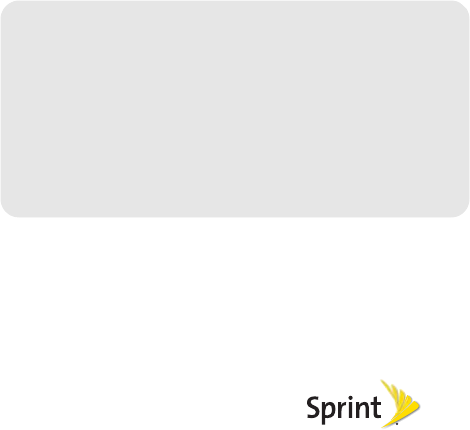
Your Safety and
Specifications
Section 5
Regulatory Submission (10.26.09). Palm, Inc. Confidential. Top Secret.

270 5A. Regulatory and Safety Information
5A. Regulatory and Safety
Information
ࡗFCC Statements (page 270)
ࡗAntenna Care/Unauthorized Modifications (page 271)
ࡗIndustry Canada (page 271)
ࡗRadio Frequency (RF) Safety Exposure (page 272)
ࡗHearing Aid Compatibility (HAC) (page 274)
ࡗBattery Handling (page 275)
ࡗProtecting Your Battery (page 276)
ࡗPower Specifications (page 277)
ࡗRecycling and Disposal (page 278)
ࡗUser Safety (page 279)
ࡗProduct Handling & Safety (page 282)
ࡗDriving Safety (page 284)
ࡗESD Safety (page 287)
FCC Statements
This equipment has been tested and found to comply
with the limits for a Class B digital device, pursuant to
part 15 of the FCC Rules. These limits are designed to
provide reasonable protection against harmful
interference in a residential installation. This equipment
generates, uses, and can radiate radio frequency
energy and, if not installed and used in accordance
with the instructions, may cause harmful interference to
radio communications. However, there is no guarantee
that interference will not occur in a particular
installation. If this equipment does cause harmful
interference to radio or television reception, which can
be determined by turning the equipment off and on,
the user is encouraged to try to correct the interference
by one or more of the following measures:
ⅷReorient or relocate the receiving antenna.
ⅷIncrease the separation between the equipment and
receiver.
ⅷConnect the equipment into an outlet on a circuit
different from that to which the receiver is connected.
Regulatory Submission (10.26.09). Palm, Inc. Confidential. Top Secret.
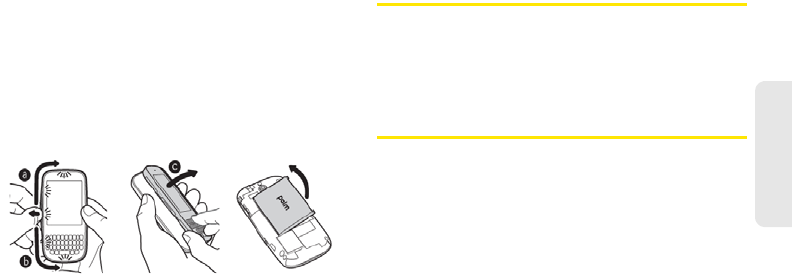
5A. Regulatory and Safety Information 271
Safety
ⅷConsult the dealer or an experienced radio/TV
technician for help.
This device complies with Part 15 of the FCC Rules.
Operation is subject to the following two conditions: (1)
this device may not cause harmful interference, and (2)
this device must accept any interference received,
including interference that may cause undesired
operation.
This phone meets the FCC Radiofrequency Emission
Guidelines and is certified with the FCC as:
FCC ID: O8F-PIXE.
The FCC ID on your Palm phone is located on a label
inside the battery compartment. The battery must be
removed as shown below to view the label.
Changes or modifications not expressly approved by
the party responsible for compliance could void the
user's authority to operate the equipment.
Antenna Care/Unauthorized
Modifications
Use only the supplied integral antenna. Unauthorized
antenna modifications or attachments could damage
the unit and may violate FCC regulations.
Industry Canada
Operation is subject to the following two conditions: (1)
This device may not cause harmful interference, and
(2) this device must accept any interference received,
including interference that may cause undesired
operation.
The term “IC” before the equipment certification
number only signifies that the Industry Canada
technical specifications were met.
Regulatory Submission (10.26.09). Palm, Inc. Confidential. Top Secret.

272 5A. Regulatory and Safety Information
IC: 39Ø5A-PIXE
This Class B digital apparatus complies with Canadian
ICES-003.
L'utilisation de ce dispositif est autorisée seulement aux
conditions suivantes: (1) il ne doit pas produire de
brouillage et (2) l'utilisateur du dispositif doit étre prêt à
accepter tout brouillage radioélectrique reçu, même si
ce brouillage est susceptible de compromettre le
fonctionnement du dispositif.
Cet appareil numérique de la classe [*] est conforme à
la norme NMB-003 du Canada.
Radio Frequency (RF) Safety
Exposure
General statement on Radio Frequency (RF) energy: Your
phone contains a transmitter and a receiver. When it is
ON, it receives and transmits RF energy. When you
communicate with your phone, the system handling
your call controls the power level at which your phone
transmits.
Specific Absorption Rate (SAR): Your mobile device is a
radio transmitter and receiver. It is designed not to
exceed the limits for exposure to radio waves
recommended by international guidelines. These
guidelines were developed by the independent
scientific organization ICNIRP and include safety
margins designed to assure the protection of all
persons, regardless of age and health.
In order to certify this unit for sale to the public, this unit
has been tested for RF exposure compliance at a
qualified test laboratory and found to comply with the
regulations regarding exposure to RF Energy under the
recommendations of the International Commission on
Non-Ionizing Radiation Protection (ICNIRP). The tests
are preformed in positions and locations as required by
the FCC and IC for each model.
As SAR is measured utilizing the device's highest
transmitting power, the actual SAR of this device while
operating is typically below that indicated below. This is
due to automatic changes to the power level of the
device to ensure it only uses the minimum power
required to communicate with the network.
The SAR limit for mobile devices set by FCC/IC is 1.6
W/kg averaged over 1 gram of tissue for the body or
Regulatory Submission (10.26.09). Palm, Inc. Confidential. Top Secret.

5A. Regulatory and Safety Information 273
Safety
head (4.0 W/kg averaged over 10 grams of tissue for
the extremities—hands, wrists, ankles, and feet).
The highest reported SAR values of the Palm® Pixi™
phone are:
In order to comply with FCC and IC RF exposure safety
guidelines, users MUST use one of the following types
of body-worn accessories:
1. A Palm® brand body-worn accessory that has
been tested for (specific absorption rate) SAR
compliance and is intended for use with this
product.
2. An accessory that contains NO metal (snaps, clips,
etc.) and provides AT LEAST 1.5 cm (0.6 in.) of
separation between the user’s body and the unit.
Do NOT use the device in a manner such that it is in
direct contact with the body (i.e., on the lap or in a
breast pocket). Such use will likely exceed the FCC RF
safety exposure limits. See fcc.gov/oet/rfsafety for more
information on RF exposure safety.
To view the most recent SAR values of the Palm® Pixi™
phone, visit palm.com/sarsprint-pixi.
Body worn operation: Important safety information
regarding radio frequency (RF) radiation exposure: To
ensure compliance with RF exposure guidelines the
phone must be used with a minimum of 1.5 cm (0.6 in.)
separation from the body. Failure to observe these
instructions could result in your RF exposure exceeding
the relevant guideline limits.
Limiting exposure to radio frequency (RF) fields: For
individuals concerned about limiting their exposure to
RF fields, the World Health Organization (WHO)
provides the following advice:
Precautionary measures: Present scientific information
does not indicate the need for any special precautions
for the use of mobile phones. If individuals are
concerned, they might choose to limit their own or their
children’s RF exposure by limiting the length of calls, or
using “hands-free” devices to keep mobile phones
away from the head and body.
Maximum scaled SAR values (W/kg) FCC
Head 1.56
Body 0.634
Regulatory Submission (10.26.09). Palm, Inc. Confidential. Top Secret.

274 5A. Regulatory and Safety Information
Further information on this subject can be obtained
from the WHO home page
who.int/mediacentre/factsheets/fs193/en/index.html WHO
Fact sheet 193: June 2000.
Hearing Aid Compatibility (HAC)
Using Your Phone With a Hearing Device
Your device has been tested for hearing aid
compatibility. Your Palm® Pixi™ phone has an
M4/T4 rating. For additional HAC information, including
the HAC rating of this product, please refer to
palm.com/hacsprint-pixi.
When some wireless phones are used near some
hearing devices (hearing aids and cochlear implants),
users may detect a buzzing, humming, or whining
noise. Some hearing devices are more immune than
others to this interference noise, and phones also vary
in the amount of interference they generate. The
wireless telephone industry has developed ratings for
some of their mobile s, to assist hearing-device users
in finding phones that may be compatible with their
hearing devices. Not all phones have been rated.
Phones that have been rated have a label on the box.
These ratings are not guarantees. Results will vary,
depending on the level of immunity of your hearing
device and the degree of your hearing loss. If your
hearing device happens to be vulnerable to
interference, you may not be able to use a rated phone
successfully. Trying out the phone with your hearing
device is the best way to evaluate it for your personal
needs.
M-Ratings: Phones rated M3 or M4 meet FCC
requirements and are likely to generate less
interference with hearing devices than phones that are
not labeled. M4 is the better/higher of the two ratings.
T-Ratings: Phones rated T3 or T4 meet FCC
requirements and are likely to be more usable with a
hearing device's telecoil (“T switch” or “Telephone
Switch”) than unrated phones. T4 is the better/higher of
the two ratings.
The more immune your hearing aid device is, the less
likely you are to experience interference noise from
your wireless phone. Hearing aid devices should have
ratings similar to those of phones. Ask your hearing
health care professional for the rating of your hearing
Regulatory Submission (10.26.09). Palm, Inc. Confidential. Top Secret.

5A. Regulatory and Safety Information 275
Safety
aid. Add the rating of your hearing aid and your phone
to determine probable usability:
ⅷAny combined rating equal to or greater than six
offers the best use.
ⅷAny combined rating equal to five is considered
normal use.
ⅷAny combined rating equal to four is considered
usable.
Thus, if you pair an M3 hearing aid with an M3 phone,
you will have a combined rating of six for “best use.”
This is synonymous for T ratings.
Palm further suggest that you experiment with multiple
phones (even those not labeled M3/T3 or M4/T4) while
in the store to find the one that works best with your
hearing aid device. If you experience interference or
find the quality of service unsatisfactory after
purchasing your device, promptly return it to the store
within 30 days of purchase. With the Palm 30-day
Risk-Free Guarantee, you may return the device within
30 days of purchase for a full refund, and you will only
be responsible for charges based on your actual
usage.
Getting the Best Hearing Device Experience With Your
Device
To further minimize interference:
ⅷSet the phone's screen and keyboard backlight
settings to ensure the minimum time interval.
ⅷMove the phone around to find the point with the
least interference.
For more information, please go to the FCC’s
Consumer Alert on accessibility of digital wireless
phones at fcc.gov/cgb/consumerfacts/hac wireless.html.
Battery Handling
ⅷDo not disassemble or open; crush, bend, or deform;
puncture or shred the battery.
ⅷDo not modify or remanufacture; attempt to insert
foreign objects into the battery; immerse or expose to
water or other liquids; expose to fire, explosion, or
other hazard.
ⅷOnly use the battery for the system for which it is
specified.
Regulatory Submission (10.26.09). Palm, Inc. Confidential. Top Secret.

276 5A. Regulatory and Safety Information
ⅷOnly use the battery with a charging system that has
been qualified with the system per the
IEEE/CTIA-1725 standard. Use of an unqualified
battery or charger may present a risk of fire,
explosion, leakage, or other hazard.
ⅷDo not short-circuit a battery or allow metallic
conductive objects to contact battery terminals.
ⅷReplace the battery only with another battery that has
been qualified with the system per IEEE/CTIA-1725.
Use of an unqualified battery may present a risk of
fire, explosion, leakage, or other hazard.
ⅷPromptly dispose of used batteries in accordance
with local regulations.
ⅷBattery usage by children should be supervised.
ⅷAvoid dropping the phone or battery. If the phone or
battery is dropped, especially on a hard surface, and
the user suspects damage, take it to a service center
for inspection.
ⅷDo not handle a damaged or leaking Lithium-Ion
(LI-ion) battery as you can be burned.
ⅷImproper battery use may result in a fire, explosion,
or other hazard.
Based on DOT rules, spare batteries must not be
transported in checked luggage on commercial flights.
Spare batteries can only be transported in carry-on
luggage. For more information:
http://safetravel.dot.gov/whats_new_batteries.html.
Protecting Your Battery
The guidelines listed below help you get the most out
of your battery’s performance.
Recently there have been some public reports of
wireless phone batteries overheating, catching fire, or
exploding. It appears that many, if not all, of these
reports involve counterfeit or inexpensive,
aftermarket-brand batteries with unknown or
questionable manufacturing standards. Use only
manufacturer-approved batteries and accessories
found at Carrier Stores or through your device’s
manufacturer. Buying the right batteries and
accessories is the best way to ensure they are genuine
and safe.
Regulatory Submission (10.26.09). Palm, Inc. Confidential. Top Secret.
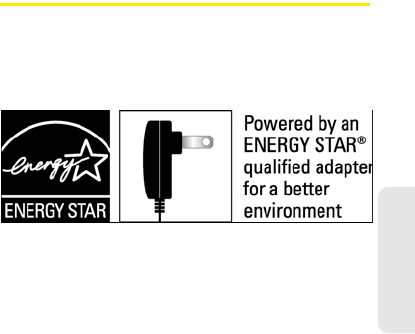
5A. Regulatory and Safety Information 277
Safety
ⅷIn order to avoid damage, charge the battery only in
temperatures that range from 32° F to 113° F (0° C to
45° C).
ⅷDon’t use the battery charger in direct sunlight or in
high humidity areas, such as the bathroom.
ⅷNever dispose of the battery by incineration.
ⅷKeep the metal contacts on top of the battery clean.
ⅷDon’t attempt to disassemble or short-circuit the
battery.
ⅷThe battery may need recharging if it has not been
used for a long period of time.
ⅷIt’s best to replace the battery when it no longer
provides acceptable performance. It can be
recharged hundreds of times before it needs
replacing.
ⅷDon't store the battery in high temperature areas for
long periods of time. It's best to follow these storage
rules:.
Less than one month: -4° F to 140° F
(-20° C to 60° C)
More than one month: -4° F to 113° F
(-20° C to 45° C)
Power Specifications
Use only Palm-approved power accessories such as
AC-power adapters and batteries. Unauthorized and
non-approved batteries will NOT operate with the Pixi
phone.
AC Power Adapter source: Palm
Part Number: 157-10130-00
Input Rating: 100-240Vac, 50/60Hz, 0.2A
Output Rating: 5Vdc, 1000mA
AC Power Adapter source: Palm
Part Number: 157-10124-00
Input Rating: 100-240 Vac, 50/60Hz, 0.2A
Output Rating: 5Vdc, 1000mA
Regulatory Submission (10.26.09). Palm, Inc. Confidential. Top Secret.

278 5A. Regulatory and Safety Information
Battery Source: Palm
Type: Rechargeable Li-ion Polymer
Model: 157-10119-00
Rating: 3.7Vdc, 1150mAh (minimum)
Recycling and Disposal
This symbol indicates that Palm products
should be recycled and not be disposed of in
unsorted municipal waste. Please return Palm
products to the electrical and electronic
equipment collection points in your
municipality or county or to a facility that properly
recycles electrical and electronic equipment. These
collection points are available free of charge. For
detailed information please contact your municipality
or county. For information on Palm’s environmental
programs, visit palm.com/environment.
Hazardous substances that may be included in
electronic products can potentially affect human health
and the environment. Recycling benefits the
environment by diverting waste from landfills and by
recovering materials that may be recycled into other
products. Responsible recycling ensures materials are
properly collected and disposed.
Palm is committed to supporting the collection and
recycling of its products. Palm is committed to
participate and support the European Union WEEE
Directive (2002/96/EC) and the protection of the
environment for future generations. For more
information on the WEEE Directive implementation in
the various EU member states please see
weee-forum.org.
It is everyone's responsibility to ensure that electrical
and electronic products are properly reused, recycled,
or recovered.
As part of Palm's corporate commitment to be a good
steward of the environment, we strive to use
environmentally friendly materials, reduce waste, and
collaborate with our channel partners to raise
awareness and help keep Palm handheld devices, s,
and mobile companions out of landfills through
evaluation and disposition for reuse and recycling. Visit
palm.com/recycle for additional details and information
about how you can help reduce electronic waste.
Regulatory Submission (10.26.09). Palm, Inc. Confidential. Top Secret.

5A. Regulatory and Safety Information 279
Safety
User Safety
Operational Warnings
IMPORTANT INFORMATION ON SAFE AND EFFICIENT
OPERATION. Read this information before using your
phone. For the safe and efficient operation of your
phone, observe these guidelines:
Potentially Explosive Atmospheres: Turn off your phone
when you are in any areas with a potentially explosive
atmosphere, such as fueling areas (gas or petrol
stations, below deck on boats), storage facilities for fuel
or chemicals, blasting areas and areas near electrical
blasting caps, and areas where there are chemicals or
particles (such as metal powders, grains, and dust) in
the air.
Interference to Medical and Personal Electronic Devices:
Most but not all electronic equipment is shielded from
RF signals and certain electronic equipment may not
be shielded against the RF signals from your phone.
Pacemakers: The Health Industry Manufacturers
Association recommends that a minimum separation
of 15 centimeters (6 inches) be maintained between a
phone and a pacemaker to avoid potential interference
with the pacemaker. These recommendations are
consistent with the independent research by the
recommendations of Wireless Technology Research.
Persons with pacemakers should:
ⅷALWAYS keep the phone more than six inches
(15 centimeters) from their pacemaker when the
phone is turned ON.
ⅷNot carry the phone in a breast pocket.
ⅷUse the ear opposite the pacemaker to minimize the
potential for interference.
ⅷTurn the phone OFF immediately if you have any
reason to suspect that interference is taking place.
Other Medical Devices, Hospitals: If you use any other
personal medical device, consult the manufacturer of
your device to determine if it is adequately shielded
from external RF energy. Your physician may be able to
assist you in obtaining this information. Turn your
phone OFF in health care facilities when any
regulations posted in these areas instruct you to do so.
Hospitals or health care facilities may be using
equipment that could be sensitive to external RF
energy.
Regulatory Submission (10.26.09). Palm, Inc. Confidential. Top Secret.
280 5A. Regulatory and Safety Information
Repetitive Motion Injuries: When using the keyboard or
playing games on your phone, you may experience
discomfort in your neck, shoulders, hands, arms, or
other parts of the body. To avoid any injury, such as
tendonitis, carpal tunnel syndrome, or other
musculoskeletal disorder, make sure to take necessary
breaks from use, take longer rests (such as several
hours) if discomfort or tiring begins, and see a doctor if
discomfort persists. To minimize the risk of Repetitive
Motion Injuries, when texting or playing games with
your phone:
ⅷDo not grip the phone too tightly.
ⅷPress the buttons lightly.
ⅷMake use of the special features in the handset
which minimize the number of buttons which have to
be pressed, such as message templates and
predictive text.
ⅷTake lots of breaks to stretch and relax.
Blackouts and Seizures: Blinking lights, such as those
experienced with television or playing video games,
may cause some people to experience blackout or
seizure, even if never experienced before. In the event a
phone user should experience any disorientation, loss
of awareness, convulsion, eye or muscle twitching, or
other involuntary movements, stop use immediately
and consult a doctor. Individuals with personal or
family history of such events should consult a doctor
before using the device. To limit the possibility of such
symptoms, wherever possible every hour take a
minimum break of 15 minutes, use in a well lighted
area, view the screen from the farthest distance, and
avoid exposure to blinking lights if you are tired.
Operating Machinery: Do not use your phone while
operating machinery. Full attention must be given to
operating the machinery in order to reduce the risk of
an accident.
Aircraft: While in aircraft, follow all instructions
regarding the operation of your phone. Use of your
phone while on board an aircraft must be done in
accordance and in compliance with airline instructions
and regulations.
Vehicles with Air Bags: Your phone should not be
placed in a position that would affect the operation of
air bag deployment or in a position that, should the air
bag inflate, could propel the phone. Air bags will inflate
with great force and care should be taken to protect
within a vehicle that has air bags. Do not place a
phone in the area over an air bag or in the air bag
Regulatory Submission (10.26.09). Palm, Inc. Confidential. Top Secret.

5A. Regulatory and Safety Information 281
Safety
deployment area. Store the phone safely before driving
the vehicle.
Hearing Aids: People with hearing aids or other
cochlear implants may experience interfering noises
when using wireless devices or when one is nearby.
The level of interference will depend on the type of
hearing device and the distance from the interference
source. Increasing the separation between them may
reduce the interference. You may also consult your
hearing aid manufacturer to discuss alternatives.
Small Children: Do not leave your phone and its
accessories within the reach of small children or allow
them to play with it. They could hurt themselves or
others, or could accidentally damage the phone. Your
phone contains small parts with sharp edges that may
cause an injury or which could become detached and
create a choking hazard.
Keep the device away from the abdomens of pregnant
women and adolescents, particularly when using the
device hands-free.
To reduce exposure to radiation, use your device in
good reception areas, as indicated by the bars on your
phone, at least 3 to 4 bars.
Caution: Avoid Potential Hearing Loss
Prolonged exposure to loud sounds (including music)
is the most common cause of preventable hearing loss.
Some scientific research suggests that using portable
audio devices, such as portable music players and
cellular telephones, at high volume settings for long
durations may lead to permanent noise-induced
hearing loss. This includes the use of headphones
(including headsets, ear buds, and Bluetooth® or other
wireless devices). Exposure to very loud sound has
also been associated in some studies with tinnitus (a
ringing in the ear), hypersensitivity to sound, and
distorted hearing. Individual susceptibility to
noise-induced hearing loss and other potential hearing
problems varies. The amount of sound produced by a
portable audio device varies depending on the nature
of the sound, the device, the device settings, and the
headphones. You should follow some common sense
recommendations when using any portable audio
device:
ⅷSet the volume in a quiet environment and select the
lowest volume at which you can hear adequately.
ⅷWhen using headphones, turn the volume down if
you cannot hear the people speaking near you or if
Regulatory Submission (10.26.09). Palm, Inc. Confidential. Top Secret.

282 5A. Regulatory and Safety Information
the person sitting next to you can hear what you are
listening to.
ⅷDo not turn the volume up to block out noisy
surroundings. If you choose to listen to your portable
device in a noisy environment, use noise-cancelling
headphones to block out background environmental
noise.
ⅷLimit the amount of time you listen. As the volume
increases, less time is required before your hearing
could be affected.
ⅷAvoid using headphones after exposure to extremely
loud noises, such as rock concerts, that might cause
temporary hearing loss. Temporary hearing loss
might cause unsafe volumes to sound normal.
ⅷDo not listen at any volume that causes you
discomfort. If you experience ringing in your ears,
hear muffled speech, or experience any temporary
hearing difficulty after listening to your portable audio
device, discontinue use and consult your doctor.
ⅷYou can obtain additional information on this subject
from the following sources:.
American Academy of Audiology
11730 Plaza America Drive, Suite 300
Reston, VA 20190
Voice: (800) 222-2336
Email: info@audiology.org
Internet: audiology.org
National Institute on Deafness and Other
Communication Disorders
National Institutes of Health
31 Center Drive, MSC 2320
Bethesda, MD USA 20892-2320
Voice: (301) 496-7243
Email: nidcdinfo@nih.gov
Internet: nidcd.nih.gov/health/hearing
National Institute for Occupational Safety and Health
4676 Columbia Parkway
Cincinnati, Ohio 45226
Voice: 1-800-CDC-INFO (1-800-232-4636)
Internet: cdc.gov/niosh/topics/noise
Product Handling & Safety
General statement on handling and use: You alone are
responsible for how you use your phone and any
consequences of its use.
Regulatory Submission (10.26.09). Palm, Inc. Confidential. Top Secret.

5A. Regulatory and Safety Information 283
Safety
You must always switch off your phone wherever the
use of a phone is prohibited. Use of your phone is
subject to safety measures designed to protect users
and their environment.
ⅷAlways treat your phone and its accessories with
care and keep it in a clean and dust-free place.
ⅷDo not expose your phone or its accessories to open
flames or lit tobacco products.
ⅷDo not expose your phone or its accessories to
liquid, moisture, or high humidity.
ⅷDo not drop, throw, or try to bend your phone or its
accessories.
ⅷDo not use harsh chemicals, cleaning solvents, or
aerosols to clean the device or its accessories.
ⅷDo not paint your phone or its accessories.
ⅷDo not attempt to disassemble your phone or its
accessories; only authorized personnel must do so.
ⅷDo not expose your phone or its accessories to
extreme temperatures, minimum 14° F and
maximum 140° F (-10° C to 60° C).
ⅷPlease check local regulations for disposal of
electronic products.
ⅷDo not carry your phone in your back pocket as it
could break when you sit down.
Battery: Your phone includes an internal lithium-ion or
lithium-ion polymer battery. Please note that use of
certain data applications can result in heavy battery
use and may require frequent battery charging. Any
disposal of the phone or battery must comply with laws
and regulations pertaining to lithium-ion or lithium-ion
polymer batteries.
Demagnetization: To avoid the risk of demagnetization,
do not allow electronic devices or magnetic media
close to your phone for a long time.
Normal use position: When making or receiving a
phone call, hold your phone to your ear, with the
bottom towards your mouth or as you would a fixed
line phone.
Emergency calls: This phone, like any wireless phone,
operates using radio signals, which cannot guarantee
connection in all conditions. Therefore, you must never
rely solely on any wireless phone for emergency
communications.
Phone heating: Your phone may become warm during
charging and during normal use.
Regulatory Submission (10.26.09). Palm, Inc. Confidential. Top Secret.

284 5A. Regulatory and Safety Information
Accessories: Use only approved accessories. Do not
connect with incompatible products or accessories.
Take care not to touch or allow metal objects, such as
coins or key rings, to contact or short-circuit the battery
terminals.
Connection to a car: Seek professional advice when
connecting a phone interface to the vehicle electrical
system.
Faulty and damaged products: Do not attempt to
disassemble the phone or its accessory. Only qualified
personnel must service or repair the phone or its
accessory. If your phone or its accessory has been
submerged in water, punctured, or subjected to a
severe fall, do not use it until you have taken it to be
checked at an authorized service center.
Interference in cars and to other Electronic Devices:
Please note that because of possible interference to
electronic equipment, some vehicle manufacturers
forbid the use of mobile phones in their vehicles unless
a hands-free kit with an external antenna is included in
the installation. RF energy may affect improperly
installed or inadequately shielded electronic operating
and entertainment systems in motor vehicles. Check
with the manufacturer or representative to determine if
these systems are adequately shielded from external
RF energy. Also check with the manufacturer of any
equipment that has been added to the vehicle.
Driving Safety
Driving Safety Tips Overview
Always obey all laws and regulations on the use of the
phone in your driving area.
Safety–Your most important call. The Wireless Industry
reminds you to use your phone safely when driving.
1. Get to know your phone and its features, such as
speed-dial and redial.
2. Use a hands-free device where it is allowed. (In
some areas, you may not use your phone while
driving even with a hands-free accessory.)
3. Position your phone within easy reach.
4. Let the person you are speaking to know you are
driving; if necessary, suspend the call in heavy
traffic or hazardous weather conditions.
Regulatory Submission (10.26.09). Palm, Inc. Confidential. Top Secret.

5A. Regulatory and Safety Information 285
Safety
5. Do not take notes, look up phone numbers,
read/write e-mail, or surf the Internet while driving.
6. Dial sensibly and assess the traffic; if possible,
place calls when you are not moving or before
pulling into traffic.
7. Do not engage in stressful or emotional
conversations that may divert your attention from
the road.
8. Dial your national emergency number to report
serious emergencies. (This is a free call from your
phone.)
9. Use your phone to help others in emergencies.
10. Call roadside assistance or a special
non-emergency wireless number when necessary.
Driving Safety Tip Details
1. Get to know your phone and its features such as
speed-dial and redial. (Carefully read your
instruction manual and learn to take advantage of
valuable features most phone models offer,
including automatic redial and memory dial. Also,
work to memorize the phone keyboard so you can
use the speed-dial function without taking your
attention off the road.)
2. Use a hands-free device. (A number of hands-free
phone accessories are readily available today.
Whether you choose an installed mounted device
for your phone or a speaker accessory, take
advantage of these devices. If driving while using a
phone is permitted in your area, we recommend
using a phone headset or a hands-free car kit
(sold separately). However, be aware that use of a
headset that covers both ears impairs your ability
to hear other sounds. Use of such a headset while
operating a motor vehicle or riding a bicycle may
create a serious hazard to you and/or others, and
may be illegal. If you must use a stereo headset
while driving, place a speaker in only one ear.
Leave the other ear free to hear outside noises,
and do so only if it is legal and you can do so
safely.)
3. Make sure you place your phone within easy reach
and where you can grab it without removing your
eyes from the road. (If you get an incoming call at
an inconvenient time, let your voicemail answer it
for you.)
Regulatory Submission (10.26.09). Palm, Inc. Confidential. Top Secret.
286 5A. Regulatory and Safety Information
4. Suspend conversations during hazardous driving
conditions or situations. (Let the person you are
speaking to know you are driving; if necessary,
suspend the call in heavy traffic or hazardous
weather conditions. Rain, sleet, snow, and ice can
be hazardous, but so is heavy traffic. As a driver,
your first responsibility is to pay attention to the
road.)
5. Do not take notes, look up phone numbers,
read/write e-mail, or surf the internet while driving.
(If you are reading an address book or business
card while driving a car, or writing a to-do list, then
you are not watching where you are going. It's
common sense. Do not get caught in a dangerous
situation because you are reading or writing and
not paying attention to the road or nearby
vehicles.If you are reading an address book or
business card while driving a car, or writing a to-do
list, then you are not watching where you are
going. It's common sense. Do not get caught in a
dangerous situation because you are reading or
writing and not paying attention to the road or
nearby vehicles.)
6. Dial sensibly and assess the traffic; if possible,
place calls when you are not moving or before
pulling into traffic. (Try to plan your calls before you
begin your trip, or attempt to schedule your calls
with times you may be temporarily stopped or
otherwise stationary. But if you need to dial while
driving, follow this simple tip: dial only a few
numbers, check the road and your mirrors, then
continue.)
7. Do not engage in stressful or emotional
conversations that may be distracting. (Stressful or
emotional conversations and driving do not mix—
they are distracting and even dangerous when you
are behind the wheel. Make people you are talking
with aware you are driving and if necessary,
suspend phone conversations which have the
potential to divert your attention from the road.)
8. Use your phone to call for help. (Your phone is one
of the greatest tools you can own to protect
yourself and your family in dangerous situations—
with your phone at your side, help is only three
numbers away. Dial your national emergency
number in the case of fire, traffic accident, road
hazard, or medical emergencies. Remember, your
national emergency number is a free call on your
phone.)
Regulatory Submission (10.26.09). Palm, Inc. Confidential. Top Secret.

5A. Regulatory and Safety Information 287
Safety
9. Use your phone to help others in emergencies. (If
you see an auto accident, crime in progress, or
other serious emergency where lives are in
danger, call your national emergency number, as
you would want others to do for you.)
10. Call roadside assistance or a special wireless
non-emergency assistance number when
necessary. (Certain situations you encounter while
driving may require attention, but are not urgent
enough to merit a call to your national emergency
number. But you can still use your phone to lend a
hand. If you see a broken-down vehicle posing no
serious hazard, a broken traffic signal, a minor
traffic accident where no one appears injured, or a
vehicle you know to be stolen, call roadside
assistance or other special non-emergency
wireless number.)
General Operation
Prolonged Views of Screen: If you are driving, do not
access any function requiring a prolonged view of the
screen. Pull over in a safe and legal manner before
attempting to access a function of the system requiring
prolonged attention. Even occasional short scans to the
screen may be hazardous if your attention has been
diverted away from your driving task at a critical time.
Volume Setting: Do not raise the volume excessively.
Keep the volume at a level where you can still hear
outside traffic and emergency signals while driving.
Driving while unable to hear these sounds could cause
an accident.
Let Your Judgment Prevail: The Device Software is only
an aid. Make your driving decisions based on your
observations of local conditions and existing traffic
regulations. The Device Software is not a substitute for
your personal judgment.
Hands-Free Capability
All CTIA Certified portable products provide the
consumer with a toll-free number for the purchase of a
compatible hands-free device, 1-800-881-7256.
ESD Safety
Electrostatic discharge (ESD) can cause damage to
electronic devices if discharged into the device, so you
should take steps to avoid such an occurrence.
Regulatory Submission (10.26.09). Palm, Inc. Confidential. Top Secret.
288 5A. Regulatory and Safety Information
Description of ESD
Static electricity is an electrical charge caused by the
buildup of excess electrons on the surface of a
material. To most people, static electricity and ESD are
nothing more than annoyances. For example, after
walking over a carpet while scuffing your feet, building
up electrons on your body, you may get a shock—the
discharge event—when you touch a metal doorknob.
This little shock discharges the built-up static electricity.
ESD-susceptible equipment
Even a small amount of ESD can harm circuitry, so
when working with electronic devices, take measures
to help protect your electronic devices, including your
Palm phone, from ESD harm. While Palm has built
protections against ESD into its products, ESD
unfortunately exists and, unless neutralized, could build
up to levels that could harm your equipment. Any
electronic device that contains an external entry point
for plugging in anything from cables to docking
stations is susceptible to entry of ESD. Devices that you
carry with you, such as your phone, build up ESD in a
unique way because the static electricity that may have
built up on your body is automatically passed to the
device. Then, when the device is connected to another
device such as a docking station, a discharge event
can occur.
Precautions against ESD
Make sure to discharge any built-up static electricity
from yourself and your electronic devices before
touching an electronic device or connecting one
device to another. The recommendation from Palm is
that you take this precaution before connecting your
phone to your computer, placing the phone in a
docking station, or connecting it to any other device.
You can do this in many ways, including the following:
ⅷGround yourself when you're holding your mobile
device by simultaneously touching a metal surface
that is at earth ground. For example, if your computer
has a metal case and is plugged into a standard
three-prong grounded outlet, touching the case
should discharge the ESD on your body.
ⅷIncrease the relative humidity of your environment.
ⅷInstall ESD-specific prevention items, such as
grounding mats.
Conditions that enhance ESD occurrences
Conditions that can contribute to the buildup of static
electricity in the environment include the following:
Regulatory Submission (10.26.09). Palm, Inc. Confidential. Top Secret.

5A. Regulatory and Safety Information 289
Safety
ⅷLow relative humidity.
ⅷMaterial type. (The type of material gathering the
charge. For example, synthetics are more prone to
static buildup than natural fibers like cotton.).
ⅷThe rapidity with which you touch, connect, or
disconnect electronic devices.
While you should always take appropriate precautions
to discharge static electricity, if you are in an
environment where you notice ESD events, you may
want to take extra precautions to protect your electronic
equipment against ESD.
Owner’s Record
The model number, regulatory number, and serial
number are located on a nameplate inside the battery
compartment. Record the serial number in the space
provided below. This will be helpful if you need to
contact us about your phone in the future.
Product: Palm® Pixi™ phone
Model:
Serial No.:
Regulatory Submission (10.26.09). Palm, Inc. Confidential. Top Secret.

290 5B. Specifications5B. Specifications
5B. Specifications
ࡗSpecifications (page 290)
ࡗOnline Accounts Available for webOS Phones (page 294)
Specifications
Category Description
Radio ⅷDual-band CDMA2000 EvDO Rev A and 1xRTT.
Features ⅷSpeaker.
ⅷHands-free headset jack (3.5 mm stereo, 3-barrel connector).
ⅷHAC M4/T4.
ⅷMicrophone mute option.
ⅷTTY-compatible.
ⅷRinger switch.
Processor technologies ⅷQualcomm® MSM7627 dual-core applications and modem processor.
Regulatory Submission (10.26.09). Palm, Inc. Confidential. Top Secret.

5B. Specifications 291
Specifications
Battery ⅷRechargeable lithium-ion.
ⅷ1150mA/hr power capacity.
ⅷRemovable.
Operating system ⅷPalm® webOS™ platform
Camera ⅷ2 megapixel.
ⅷLED flash.
ⅷAuto-exposure.
ⅷAuto-white balance.
ⅷGeotagging.
Size ⅷ4.37 in. x 2.17 in. x 0.43 in. (111.0 mm x 55. mm x 10.85 mm).
Weight ⅷ3.51 ounces (99.5 grams).
Connectivity ⅷBluetooth® wireless technology 2.1 + EDR with A2DP (stereo Bluetooth)
support.
Display ⅷ2.63-inch touchscreen.
ⅷ18-bit TFT color.
ⅷResolution: 320 x 400 sub-HVGA.
ⅷUser-adjustable brightness.
Keyboard ⅷPhysical QWERTY keyboard.
Category Description
Regulatory Submission (10.26.09). Palm, Inc. Confidential. Top Secret.

292 5B. Specifications
Sensors ⅷAmbient light.
ⅷAccelerometer.
ⅷProximity.
Memory ⅷ8GB (~7GB user available).
ⅷUSB mass storage support.
Connector ⅷmicroUSB connector with USB 2.0 Hi-Speed.
Included Palm webOS
applications (at time of purchase)
ⅷAmazon MP3.
ⅷApp Catalog.
ⅷCalculator.
ⅷCalendar.
ⅷCamera.
ⅷContacts.
ⅷDoc View.
ⅷEmail.
ⅷMemos.
ⅷMessaging (integrated SMS, MMS, and IM).
ⅷMusic.
ⅷPDF View.
Category Description
Regulatory Submission (10.26.09). Palm, Inc. Confidential. Top Secret.

5B. Specifications 293
Specifications
Included Palm webOS
applications (at time of purchase)
(Continued)
ⅷPhotos.
ⅷPhone.
ⅷTasks.
ⅷVideos.
ⅷWeb.
Included third-party applications
(at time of purchase)
ⅷGoogle Maps.
ⅷNASCAR Sprint Cup MobileSM.
ⅷSprint NFL Mobile Live.
ⅷSprint Navigation.
ⅷSprint TV®.
ⅷYouTube.
Operating temperature range ⅷ32°F to 113°F (0°C to 45°C).
ⅷ5% to 90% RH.
Category Description
Regulatory Submission (10.26.09). Palm, Inc. Confidential. Top Secret.

294 5B. Specifications
Online Accounts Available for webOS Phones
Applications that
display data from
this account
Relationship
between phone and
online account*
Can I edit and add
info to this account
on my phone?
Can I edit and add
data to this account
on the web?
What happens
when I delete this
account from one
app?
Exchange Contacts
Calendar
Tasks
Email
Sync Yes Yes All data from all
affected apps is
simultaneously
deleted
Facebook Contacts
Calendar Contacts &
Calendar transfer
from web to phone
Photos
transfer/upload
from phone to web
Photos only Contacts and
Calendar only Only info in that
app is deleted; info
remains in other
apps
Google Contacts
Calendar
Email
Messaging
Sync Yes Yes Only info in that
app is deleted; info
remains in other
apps
Regulatory Submission (10.26.09). Palm, Inc. Confidential. Top Secret.

5B. Specifications 295
Specifications
*Sync: A two-way exchange and update of your data. What you add or change in one location is automatically
added or changed in the other.
Transfer: A one-way update of your data. You can add or change data only in one location; the data is then copied
to the other location.
LinkedIn Contacts Transfer from web
to phone No Yes Only one app is
affected: Contacts
Palm profile Contacts
Calendar
Tasks
Memos
See “Backup” on
page 164 for a full
list of affected info
Transfer from
phone to web Yes No All data is deleted
from all affected
apps; see “Backup”
for details
Photobucket Photos Transfer/upload
from phone to web Yes No Only info in that
app is deleted
Applications that
display data from
this account
Relationship
between phone and
online account*
Can I edit and add
info to this account
on my phone?
Can I edit and add
data to this account
on the web?
What happens
when I delete this
account from one
app?
Regulatory Submission (10.26.09). Palm, Inc. Confidential. Top Secret.

296 Index
Index
Numerics
112 phone numbers 87
1xRTT data networks 251
411 phone numbers 12
911 phone numbers 87
999 phone numbers 87
A
accented characters 54
Accept Cookies option 222
accessories 284
Account List view 186
accounts
See also individual account
types
data services and 182, 183
directory assistance and 12
managing 12
music and 117, 258, 259
network settings for 100
online 248
passwords for 23
pictures and 107
setting up 16
user names for 183
Acrobat Reader files. See PDF
files
activation 16, 182
active calls. See phone calls
ActiveSync accounts. See
Exchange ActiveSync
accounts
Add An Account option
calendars 137, 144
contacts 123, 133
email 188
Add Bookmark option 218
Add Contact Reminder 129
Add device option 96, 227
Add Picture command 206
Add to Launcher 217
Address Book on Mac 79,
233
address books 86, 121
addresses. See contacts; email
addresses
advanced gestures 176
airbags 281
aircrafts 280
airplane mode 19, 264
alarms 63, 140, 144, 152–
154
See also Clock application
Album Art view 115
album headers 106
albums. See photo albums;
video albums; music albums
alerts. See alarms; notifications
All Calendars view 138
All inboxes view 186–187
all-day events 140
See also calendars; events
alternate characters
Amazon accounts 117
Regulatory Submission (10.26.09). Palm, Inc. Confidential. Top Secret.

Index 297
Index
Amazon MP3 service 113,
117–120, 258, 259
animations 9, 11, 243
antenna 271
AOL accounts 187
App Catalog 68–70
application menu 59, 264
application search 264
application update 264
applications
See also third-party
applications
adding to phone 68–70
buying 68, 70–71
closing 51
compatibility of 68
deleting 52, 71, 263
dialing from 85
displaying 49
downloading 70
included with phone 292,
293
keywords for 62
losing 260
managing 71
moving 50
music and 114
opening 46–48
Palm OS 68
reinstalling 71
running 9
searching in 63, 264
troubleshooting 171, 242,
243, 250
updating 65–68, 71, 264
working with 49–53
appointments. See events
artists 114, 116, 117–119
attachments
files as 157, 163
internal memory and 263
messages and 194, 202
music as 113
opening 196, 208
pictures as 106
saving 196
audio files. See music files
audio quality 247
authentication 253
Auto Locate option 214, 215
auto-correct feature 56
automatic backup 164, 165
automatic date and time
adjustment 170
auto-shut off interval 175, 246
B
back covers 239–242
back gesture 37, 49, 176,
243, 264
Back View 31
Background data collection
option 215
Backup application 164–170,
260
See also Palm profile
basic gestures 36–39
Regulatory Submission (10.26.09). Palm, Inc. Confidential. Top Secret.
298 Index
battery
caring for 276–277, 283
charging 31–33, 233
maximizing life of 33–34
replacing 234–238
troubleshooting 233
battery specifications 291
billing accounts 71, 72
blackouts 280
blank screens 242
Block Popups option 222
Bluetooth devices 226–229
adding 96, 227
airplane mode and 19, 20
connecting to 226, 228
deleting 229
disconnecting from 229
discovering 227
passkeys for 227
phone calls and 96
renaming 229
troubleshooting 245, 246–
247
turning on and off 226
Bluetooth wireless
technology 96, 226
See also wireless services
bookmarks 163, 218–221
Brightness slider 175
browser. See Web browser
Buddies view 204
built-in applications 292, 293
buying
applications 68, 70–71
music 119–120
C
cable service providers 253
cache (web pages) 222
Calculator application 154
Calendar application 135–
145
calendar events. See events
Calendar View Options 144
calendars 135–145
See also events
alarms and 140, 144
backing up 166
dates and 142
default 144
display of 140
events 135–136, 140,
142
getting started with 137
online 144
preferences for 143–145
saving 138
synchronizing 135–137,
145, 248
troubleshooting 256–257
call history 93–94
caller ID blocking 94
caller IDs 104, 127
calling cards 13
calls. See phone calls
camera 101–102, 258, 291
Caps Lock 53
car kits 96, 134–135
Regulatory Submission (10.26.09). Palm, Inc. Confidential. Top Secret.

Index 299
Index
Card view 9, 49, 51, 265
See also wallpaper
cards 45, 50, 264
Certificate Manager 173–174
certificates 173–174
Change Login Settings
option 192
Change Wallpaper option 176
character searches 85
characters 54–56
charging dock 33
chat rooms. See conversations
children, safety of 281
Classic app 68
Clear Cache option 222
Clear Call History
command 94
Clear Cookies option 222
Clear flag command 198
Clear History option 222
Clips (animations in Help) 11
Clock application 152–154
collect calls 13
colors
for email message text 194,
199
for calendar entries 136
for memos 151
columns 158
comments 157, 159
compatibility information 95,
234, 243, 247
conference calls 92–93
connection menu 60, 265
connections
Bluetooth devices and 96,
226
corporate servers and 250
Internet 214
network settings for 100
online address books
and 121
Palm profile and 164
phone calls and 91
roaming and 98, 100
timing out 251
transferring files and 104,
111, 116
troubleshooting 244, 255
TTY/TDD devices and 99
wireless 20
contact lists 133, 197
contact matches 97
contacts 121–135
adding 121, 124
backing up 166
car kits and 96, 134–135
default account 133
deleting 126, 132
dialing by name 86
displaying 94, 126, 129,
130
driving directions for 224
editing 126, 129, 130
email and 197
getting in touch with 131
getting started with 123
Regulatory Submission (10.26.09). Palm, Inc. Confidential. Top Secret.
300 Index
Launcher icons for 131
linked 122
linking 130–131
messages and 208
photos for 104–106,
127–128
preferences 133–134
reminders and 129
ringtones for 128, 179
saving information for 94,
125, 197, 209
searching 97, 125
selecting 89
sending 134–135
speed dials for 128
synchronizing 121, 123,
134, 248
troubleshooting 256–257
unlinking 130–131
vCards and 122, 135
Contacts application 121–
134
conversations 202–204, 209
See also instant messages
Conversations view 204
cookies 222
Copy All option 58
copying
contacts and calendar from
computer 78
contacts from old phone 77
files from computer 73–75
text 57
corporate accounts 188–190,
250
coupling 245
coverage areas 20, 244
creating
email 193–194
events 137–138
files 160
instant messages 211
memos 150
messages 205–206
tasks 146–147
tasks lists 145
credit cards 72, 120
cursor 42, 43
custom message 211
customer support 11, 12
customizing
See also preferences
Calendar application 143–
145
Contacts application 133,
134
data usage 98
email accounts 191
Location Services 214
phone settings 97, 100
roaming preferences 98
web browsers 221–222
cutting text 57
D
dashboard 65, 265
data connection icons 29,
183
Regulatory Submission (10.26.09). Palm, Inc. Confidential. Top Secret.

Index 301
Index
data roaming 99
data service icons 251
data service providers 252,
253
data services 182–183, 251
data services passwords 24
data transfer 76–82
Data Transfer Assistant 78–
79, 82, 122, 136, 265
data usage 98, 99
DataViz 160
dates 147, 170–171
See also calendars
Day view 141
default account
Calendar 144
contacts 133
Email 201
Default Calendar option 144
Default Event Duration
option 144
Default Event Reminder
option 144
default settings 260
deleting
alarms 154
applications 52, 71, 263
backed-up information 165
billing accounts 72
Bluetooth devices 229
bookmarks 220, 221
browsing history 222
certificates 174
contacts 126, 132
conversations 209
cookies 222
devices 229
email 192, 198
events 142
information 171
instant messaging
accounts 212
list items 39, 45
memos 152
messages 209
music 116
numbers on dial pad 85
online accounts 248
photo albums 104
pictures 108
ringtones 128
stored web page
content 222
tasks 150
videos 110
demagnetization 283
desktop organizers 81, 232
Device Info application 171–
174
device names 171
Devices list 226
devices, pairing 226–228
diagnostic information 172
dial pad 84
dialing 84, 87, 128, 209, 221
dialing prefixes 98
dialing shortcuts 98
Regulatory Submission (10.26.09). Palm, Inc. Confidential. Top Secret.
302 Index
dialing tones 97
Digital Rights Management
(DRM) 73
directions 224
directory assistance 12
display. See touchscreen
display size 156, 161
displaying
album headers 106
calendar events 140
certificates 174
contacts 94, 121, 126,
129, 130
email folders 199
file properties 157
images 256
maps 132
meeting participants 143
messages 208
notifications 177
phone calls 89, 94
pictures 102
tasks 147
videos 109, 111
web pages 217
Doc View 155–160
Document Editing 160
documentation 10, 11, 26
documents 155–163
Documents To Go 160
Download for free option 70
downloading
See also App Catalog
applications 70
email 192, 195, 253
pictures 102
drafts 194
drag and drop gesture 45
drag gesture 38, 265
driving directions 224
driving safety tips 95, 284–
287
DRM-free music files 73
DTA. See Data Transfer
Assistant
DTMF tones 97
due dates (tasks) 147, 149
E
earpiece 245
EarthLink accounts 187
EAS. See Exchange
ActiveSync
echoes 245
editing
contacts 126, 129, 130
email accounts 192
files 160
IM accounts 212
memos 151
Palm profile 164
text 57
web page bookmarks 220
electrostatic discharge. See
ESD
email 186–202
adding pictures to 106
Regulatory Submission (10.26.09). Palm, Inc. Confidential. Top Secret.

Index 303
Index
alerts for 191
attaching files to 157, 163,
194
attaching music to 113
backing up 167
contacts and 197
creating 193–194
deleting 192, 198
dialing from 87
download options for 253
drafts 194
folders 199–200
forwarding 198
links in 112
login settings 192
managing 198
merging from multiple
accounts 186
message headers 198
opening attachments 196
preferences for 200
receiving 186, 192, 195
replying to 197
roaming and 99
searching for 197
sending 186, 193–194,
202
signatures 192, 199
synchronizing 186, 192,
195, 248
troubleshooting 252–253
email accounts
accessing 186
changing 192
creating multiple 188
default 201
deleting 192
reordering 201
setting up 187–191
synchronizing 186
troubleshooting 250, 252–
254
email addresses
changing 169
entering 191, 193
saving 197
Email application 186–202
email service providers 187–
190, 252, 253
emergency calls 283
emergency phone
numbers 87
emoticons 206–208
endnotes 157
erasing data 165, 171–172,
260
ESD safety 287–289
ESMTP authentication 253
EvDO data networks 30, 251,
252
Event Location option 138–
139
Event Notes option 140
Event Reminder option 144
events 137–140
alarms and 140, 144
calendar 135–136, 137–
138
Regulatory Submission (10.26.09). Palm, Inc. Confidential. Top Secret.
304 Index
creating 137–138
deleting 142
displaying 140
locations 138–139
reminders and 143
repeating 139
saving 138
synchronizing 136, 137,
145
untimed 140
Excel files 155, 158–159
Exchange ActiveSync
accounts
setting up 188–190
specifications 294
synchronization with
phone 80
Synergy feature and 9
troubleshooting 250–251
Exchange servers
searching over 86
synchronizing with 249,
251
troubleshooting 251
explosive atmospheres 279
exporting data 232–233
extensions (phone calls) 98
F
Facebook accounts
Photos application and 107
specifications 294
synchronization with
phone 80, 124
factory-installed
applications 292, 293
favorites
email folders 200
web bookmarks 218
FCC statements 270
features 12
feedback 245
file types
opening files and 155
playing music and 113
viewing pictures and 102
watching videos and 109
files
See also specific types
changing contents 160
copying to phone 73–75,
109, 119, 155, 160
creating 160
display size 156
finding text in 156, 162
freeing memory and 262
losing 260
opening 155, 160
properties for 157
saving 157, 162
searching for 155
sending 157, 163, 194
sharing 157, 163
storing 259
filtering tasks 148
Find command 156, 162
finding information. See
searching
flick gesture 38, 265
Regulatory Submission (10.26.09). Palm, Inc. Confidential. Top Secret.

Index 305
Index
folders
copying files to 259
email 199–200
receiving email and 200
footnotes 157
formats, phone 175
formatting for email message
text 194, 199
forward gesture 38, 176
free applications 70
front gesture 176
Front View 27
frozen phone 171, 242, 261
full erase 172, 260
See also erasing data
G
GALs. See Global Address
Lists
genres 114, 115
Geotag Photos option 215
gesture area 35, 58, 265
gestures 9, 35–45
See also specific types
advanced 176
back gesture changes 176
troubleshooting 243
Get email option 192
Get My Music option 113
Global Address Lists 86, 121
Global Address Lookup
option 126
Google accounts
creating account on
website 77, 78, 81
setting up account on
phone 121, 135, 186
specifications 294
synchronization with
phone 78, 80
Synergy feature and 9
Google Maps 223
Google Weather 136
H
HAC 274–275
HAC option 99
hands-free devices 96, 245,
246–247, 285
hard resets. See full erase
hardware 26
headsets 95, 247
hearing aid compatibility. See
HAC
hearing aids 281
hearing loss 281–282
help 11, 262
See also troubleshooting
Help application 11
history lists 94, 204, 222
hospitals 279
I
iCal on Mac 79, 233
icons 29–30
data services and 251
Google maps and 223
Launcher 52
notifications and 244
Regulatory Submission (10.26.09). Palm, Inc. Confidential. Top Secret.
306 Index
reordering 52
signal-strength 244
web pages as 218, 219
IM. See instant messages
images 196, 256
See also pictures
IMAP email accounts 190,
253
inbox (email) 186, 201, 253
Industry Canada 271
information
accessing 9, 249
backing up 164–168
cutting, copying, and
pasting 57
deleting 165, 171
entering 56, 217
importing 249
linked contacts 130
losing 260
protecting 23, 164
restoring 260
retrieving 10
saving 58, 125
system 171
transferring 232
installing
third-party applications 68,
261
updates 65–68
instant messages
account information 212
creating 211
notifications 212
online status 211
sending 203, 211
instant messaging
accounts 209–210, 212
Interactive Tests 173
interference 245, 247, 275,
284
internal memory. See memory
international language
settings 174
Internet service
providers 190–192, 252,
253
ISPs. See Internet service
providers
iTunes files 73, 259
J
JavaScript option 222
K
keyboard 28, 53–54, 85
keyboard shortcuts 58
keywords 62
L
labels 125
landscape mode 217
language 174
Launcher
applications in 47
contacts added to 131
defined 265
gesture 48
icons 52
Regulatory Submission (10.26.09). Palm, Inc. Confidential. Top Secret.

Index 307
Index
pages 29, 48
web pages and 217
layered calendars 136
light in gesture area 58
lighted dial pad 84
linked contacts 122–123,
130–131, 132, 265
LinkedIn accounts 295
linking to
contacts 130
videos 112
web pages 217, 221, 263
list items 39, 45
List Order option 133
lists 56, 148
local event information 12
location information 214, 225
See also maps
Location Services 214–215
locations 138–139
lock icon 216
login settings 192
long-distance phone calls 12
losing device 165
lowercase letters 53
M
Mac computers
copying files 104, 110,
116
transferring files and 259
transferring info from desktop
software 79
machinery, operating 280
maps 132, 223, 225, 256
Mark all completed
command 150
Mark all incomplete
command 150
Mark as read/unread
command 198
media files 259, 262
media sync 73
medical devices 279
meeting invitations. See
meeting requests
meeting participants 143
meeting requests 143, 201
memory 262, 292
memos 150–152, 167
Memos application 150–152
menus 58–60, 264, 265
merged views 186, 266
message headers 198
messages. See email;
multimedia messages; text
messages; voicemail
Messaging application 202–
213
messaging, backing up 167
microphone 245
Microsoft Direct Push 187
Microsoft Excel files. See Excel
files
Regulatory Submission (10.26.09). Palm, Inc. Confidential. Top Secret.
308 Index
Microsoft Exchange
ActiveSync. See Exchange
ActiveSync
Microsoft PowerPoint files. See
PowerPoint files
Microsoft Word files. See Word
files
misspelled words 56
mobile network connections.
See connections
Month view 141
Move to folder command 198
movie listings 12
MP3 music service 117–120,
258, 259
multimedia messages
addressing 205
attachments and 208
contact information and 209
contacts and 208
creating 205–206
deleting 209
dialing from 87, 209
displaying 208
notifications 212
pictures and 106
roaming and 99
sending 203, 205–206
troubleshooting 254
multitasking 9, 46
music 113–120
answering phone and 88
deleting 116
information about 118
listening to 96, 113
playback controls 115
searching for 116, 117
songs as ringtones 179,
259
transferring from iTunes 73
transferring to iTunes 73
troubleshooting 258, 259
music albums 114, 116, 117,
119
Music application 113–117
N
names
See also user names
changing Bluetooth
device 229
changing device 171
dialing by 86
sending or receiving
messages and 191
NASCAR Sprint Cup
Mobile 184
national emergency phone
numbers 87
network connections. See
connections
network settings 100
network times 171
next gesture 176, 243
NFL Mobile Live 184–185
normal use position 283
notes 140, 147
notifications 29, 63
Regulatory Submission (10.26.09). Palm, Inc. Confidential. Top Secret.

Index 309
Index
contacts and 89
defined 266
displaying 177
messages and 191, 212
reordering 65
responding to 244
sounds for 88
troubleshooting 254
update 65
voicemail and 100
Now Playing list 115, 116
numbers 85, 154
O
Office Outlook. See Outlook
online accounts 134, 186,
248, 266, 294
See also accounts; email
accounts
online address books 86, 121
online calendars 136, 144
See also calendars
online status 211
online support 11, 12
opening
applications 46–48
attachments 196, 208
files 155, 160
maps 132
web pages 216, 221
operating system 268
operator assistance
(phone) 13
Option key. See orange key
orange key 28, 266
organizer features 121
outage information 253
Outlook 79, 187, 249
overdue tasks 147
P
pacemakers 279
page indicators 29, 48
pairing devices 226–228
Palm Desktop software 79,
249
Palm Music Assistant 73
Palm online support 11
Palm OS 68
Palm Pixi phone 9
See also phone
Palm profile 10, 17, 260, 266,
295
Palm profile account 82, 267
backing up 164–168
Palm Synergy feature. See
Synergy feature
Palm webOS 68
partial erase 172, 260
See also erasing data
partnerships. See pairing
passkeys 227
Password is Required field 72
passwords 23–24
changing 24, 170
entering 54
instant messages and 212
PDF files and 161
Regulatory Submission (10.26.09). Palm, Inc. Confidential. Top Secret.
310 Index
screens and 177
pasting text 57
pauses in phone
numbers 125
PDF files 160–163
PDF View 160–163
performance 243
Personal Identification
Numbers. See PINs
personal information 23, 260
phone
See also phone calls
activating 16, 182
answering 87, 89, 91
applications compatibility 68
caring for 282
compatible devices for 247
conference calls 92
data services and 251
dialing 84–87, 128, 221
disposing of 278
emergency calls and 87
formats 175
languages 174
number for 93
preferences for 97–100
redialing 87
regional settings for 174
renaming 171
replying to conversations
and 203
resetting 171–172
restarting 171, 242, 246
safety information 11, 95
setting up 16–18
silencing ringer for 88
specifications 290
status of 29
system information
about 171
third-party applications
and 261
transferring information
to 77, 232
troubleshooting 172, 244–
246
TTY/TDD devices and 99
turning on or off 18–21
updating 65–68
volume 22, 90
phone calls 87–89
adding a second 91
applications and 91
conference calls 92–93
contact information for 94
contacts and 93
directory assistance for 12
driving and 95, 284–287
ending 91
getting operator assistance
with 13
getting started with 21
hands-free devices and 96
hold 90, 91
information about 89, 94
making 84, 87, 89, 221
managing 90
Regulatory Submission (10.26.09). Palm, Inc. Confidential. Top Secret.

Index 311
Index
messages during 205
replying to 89
ringtones for 128, 179
searching and 10
searching for contacts
and 97
sending to voicemail 89
shortcuts for 98
swapping 92
phone headsets 95–96, 247
phone icons 29
phone numbers
adding to contacts 94
finding 93
speed dials for 129
Phone Reset Options
settings 172
phone settings 97–100
photo albums 103–104
photo header 105
Photobucket accounts 295
Photos application 102–108
photos. See pictures
pictures 101–108
albums and 103–104
backing up 167
contacts and 104–106,
127–128
deleting 108
displaying 102
downloading 102
sending 106, 205, 206,
254
specifying as wallpaper 176
taking 101–102, 258
uploading 106–108
wallpaper and 106
pinch in gesture 41, 267
pinch out gesture 41, 267
PINs 177
play lists 115, 116
Play sound option 191
playback controls, music 115
playback controls, video 109,
112
playing
music 115
videos 109, 112
voicemail messages 89
Playlist view 115
podcasts 73
POP email accounts 190, 253
power button 31
power specifications 277
PowerPoint files 155, 159–
160
power-saving feature 19, 246
preferences 164–180
See also customizing
buddies 204
calendars 143–145
contacts 133–134
email 200
phone calls 97–100
reminders 144
web browsers 221–222
preferred roaming list 100
Regulatory Submission (10.26.09). Palm, Inc. Confidential. Top Secret.
312 Index
prefixes 98
presentations. See PowerPoint
files
previous gesture 176, 243
priority settings
email 194
tasks 147
processor 290
product updates. See updates
profile 10, 164, 266
protecting information 23,
164
punctuation
Purge completed
command 151
Q
Quick Launch
applications in 46–47, 51
defined 267
gesture 38
icons 52
Quick Tests 172
R
radio 183, 290
Radio Frequency 272–274
recurring events. See repeating
events
recycling 278
redialing phone numbers 87
redirectors (web pages) 255
Regional Settings
application 174–175
reinstalling applications 71
reminders 125, 129, 140,
143, 144
See also alarms
Remove Contacts Account
option 134
Remove Email Account
option 192
renaming devices 171, 229
reordering
bookmarks 220
cards 50
email accounts 201
icons 52
notifications 65
task 149
repeating events 139
repetitive motion injuries 280
Reply-to address option 192
Reset Voicemail Count
option 100
resets 171, 260
restarting phone 171, 242
restaurant information 12
restoring data 260
reviews 70, 71
RF energy 284
ringer switch 27, 88, 153,
178, 179
ringtone volume 153
ringtones 128, 178–180
roaming 98, 100
roaming charges 66
roaming list 100
Regulatory Submission (10.26.09). Palm, Inc. Confidential. Top Secret.

Index 313
Index
rows 158
S
safety information 270, 272–
274, 279–289
SAR 272–274
satellite photos 223
saving
attachments 196
calendar events 138
contacts 125
email addresses 197
files 157, 162
images 196
information 58, 125
phone numbers 94
pictures 106
web page bookmarks 220
schedules. See calendars
screen
brightness 19, 175
caring for 27
troubleshooting 238, 242
turning on or off 18, 21,
175
unlocking 177–178
waking up 21
Screen & Lock
application 175–178
scroll gesture 29, 39–40
searching 10, 61–63
for applications 48
for emails 197
for memos 151
for services 225
for text in files 156, 162
Secure Unlock option 177
secure websites 216, 256
security
See also Certificate Manager
erasing data from
phone 171
locking the screen 175,
177–178
Palm profile 170
seizures 280
Select All option 58
sending
contacts 134–135
conversation
messages 203
document files 157
email 186, 193–194, 202
instant messages 211
music 113
PDF files 163
pictures 106, 205, 206,
254
text messages 205–206
videos 254
service plans 12
See also accounts; data
services
Set a ringtone option 128
Set due date for all
command 149
Set flag command 198
Set speed dial command 129
Regulatory Submission (10.26.09). Palm, Inc. Confidential. Top Secret.
314 Index
setting up
Amazon accounts 117
billing accounts 71
hands-free devices 96
phone 16–18
voicemail 22
share option 202
sharing
images 196
videos 112
Shift 53
shopping information 12
shortcuts 58, 98
Show Contact Matches
option 97
Show Email option 192
Show Icon option 191
signal 244, 245
signal-strength icon 20, 244
Signature option 192, 199
Simple PIN option 177
slides. See PowerPoint files
smart folders 201, 267
smartphone 232, 233
SMTP servers 253
snooze 143, 153
soft resets. See partial erase
software 249
software updates 65–68
songs. See music
sounds 178–180
See also specific type
Sounds & Ringtones
application 178–180
speakerphone 245
speakers 96
Specific Absorption Rate. See
SAR
specifications 290–293
speed dialing 86, 128
spelling errors 56
spreadsheets. See Excel files
Sprint 411 12
Sprint account passwords. See
account passwords
Sprint Customer Service 12
Sprint National Network 182,
183
Sprint Navigation 224–225
Sprint online help 11
Sprint Operator Services 13
Sprint service plans 12
See also accounts; data
services
Sprint TV 183
static 245, 247
stereo headsets 95, 96
storage space 262
streaming
music 113
videos 111
subaccount passwords 23
swapping phone calls 92
swipe gesture 37, 267
Sym key 28, 267
symbols 54
Regulatory Submission (10.26.09). Palm, Inc. Confidential. Top Secret.

Index 315
Index
Sync deleted emails
option 192
Sync Now option 133
synchronization 247–251
defined 247
desktop software, Google,
and phone 81
email 186, 192, 195
Facebook information 80,
124
online accounts 134, 145
online calendars 135–137,
145
online contacts 121, 123,
134
retrieving information
and 10, 249
setting up 248
troubleshooting 250–251
Synergy feature 9, 76, 121,
135, 186, 202, 267
system information 171
system updates 65–68, 267
See also updating phone
T
tap gesture 36, 242, 268
taps, troubleshooting 242
task lists
assigning tasks to 147
creating 145
deleting 150
filtering 148
reordering items in 149
tasks 145–150
backing up 168
completing 147, 149
creating 146–147
deleting 150
displaying 147
due dates for 149
priorities 149
renaming 148
reordering 149
Tasks application 145–150
TDD 99
technical support 11, 12
temperature ranges 293
tests. See Quick Tests;
Interactive Tests
text 156, 162
copying, cutting 57
formatting 194, 199
pasting 57
searching 156, 162
selecting 42–44
text messages 202–206
addressing 205
contacts and 208, 209
creating 205–206
deleting 209
dialing from 87, 209
displaying 208
links in 112
notifications 212
phone calls and 87, 90
roaming and 99
sending 203, 205–206
troubleshooting 254
text selection gestures 42–44
Regulatory Submission (10.26.09). Palm, Inc. Confidential. Top Secret.
316 Index
text telephones. See TTY/TDD
devices
third-party applications
adding to phone 68
backing up 168
freeing internal memory
and 263
losing 260
synchronizing using 249
troubleshooting 261–262
third-party phone calls 13
throwing 39
thumbnail images 102
time formats 170
time zones 171
times 170–171
Tips (Help application) 11
title bar icons 29
Top View 31
touchscreen 28, 35
See also screens
Touchstone charging dock 33
traffic information 223, 225
transferring data 76–82
from computer 232–233
computer to phone 78
Exchange to phone 80
Facebook to phone 80
Google to phone 80
old phone to new 77
planning for 76
troubleshooting 259
troubleshooting
applications 171, 242,
243, 250
backing up data 260
battery 233
Bluetooth devices 246–
247
data services 251
erasing data 260
gestures 243
hands-free devices 245,
246–247
messaging 254
performance 243
phone 244–246
Quick Tests and 172
screens 242
universal search 257
updates 261
trusted partnerships. See
pairing
TTY/TDD devices 99
Turn off Airplane Mode
option 20
Turn Off and Erase Data
option 165
Turn on Airplane Mode
option 19
TV. See Sprint TV
U
unauthorized users 23
universal search 61–63, 85,
257, 268
See also searching
Regulatory Submission (10.26.09). Palm, Inc. Confidential. Top Secret.

Index 317
Index
unlinking contact
information 131
unlocking the screen 177–
178
untimed events 140
See also calendars; events
up gesture 39, 47
Update PRL option 100
updates
network settings 100
phone 65–68, 261
updating
applications 65–68, 71,
264
billing accounts 72
uploading pictures 107, 108
uppercase letters 53
URLs 216, 218, 219
USB Drive mode 74, 259
user names 23, 182, 212
user profile 10, 164, 266
user safety information 279–
289
V
vCards 122, 135
VCF format 122
video albums 103
videos 108–112
answering phone and 88
deleting 110
iTunes 73
linking to 112
playback controls 109, 112
searching for 111, 112
sending 254
troubleshooting 254
watching 108, 111
Videos application 108–111
views 9
See also cards
Vista computers
copying files 104, 110,
116
Outlook 2007 79
transferring info from desktop
software 79
Voice Network 99
voicemail 22, 89, 100
Voicemail Count Reset
option 100
volume
adjusting for phone calls 90
alarm 153
phone call 22
system sounds 178
troubleshooting 245
VPN server connections 190
W
waking up the screen 21
wallpaper 106, 176
See also Card view
weak signals 244, 245
web addresses 216, 218, 219
Web browser 215–222
web pages
accessing information
on 10
bookmarking 218–221
Regulatory Submission (10.26.09). Palm, Inc. Confidential. Top Secret.
318 Index
clearing browsing history
for 222
clearing cache for 222
dialing from 87
display options for 217
displaying images on 256
entering information
on 217, 256
linking to 217, 221, 263
navigating through 217
opening 216, 221
recently viewed 221
refreshing 217
troubleshooting access
to 255
web search 62
web-based email 186, 190,
191
webOS operating system 268
websites
accessing secure 216, 256
activating phone 16
blocking popups from 222
browsing 99
connecting to 215–216
customer support 11, 12
disabling JavaScript for 222
freeing internal memory
and 263
opening a second
browser 216
playing music from 113
playing videos from 111
searching for 216
troubleshooting connections
to 255
uploading pictures to 107,
108
Week view 141
Wide View 156
Windows XP computers
copying files 104, 110,
116
transferring info from desktop
software 79
wired headsets 95
wireless services 19–21, 246
Word files 155, 157–158
worksheets. See Excel files
Y
Yahoo! accounts 187
YouTube application 109,
111–112
Z
zoom gesture 41–42
Regulatory Submission (10.26.09). Palm, Inc. Confidential. Top Secret.